- Hiking Shoes
- Hiking Boots
- Hiking Sandals
- Trail Runners
- Base layers
- Hiking Shirts
- Fleece Jackets
- Softshell Jackets
- Rain jackets
- Down Jackets
- Hiking Pants
- Hiking Shorts
- Base Layers
- Rain Jackets
- Hiking Bras
- Baby Carriers
- Cookware Sets
- Water Filters
- Water Purifiers
- Sleeping Bags
- Sleeping Pads
- Hiking Poles
- GPS Devices
- Solar Chargers
- Dive Regulators
Dive Computers
Dive Watches
- Dive Wetsuits
- Dive Gloves
- Dive Lights
- Dive Knives
- Spearfishing Wetsuits
- Spearfishing Masks
- Spearfishing Fins
- Spearfishing Watches
- Freediving Wetsuits
- Freediving Masks
- Freediving Fins
- Freediving Watches
- Sit On Top Kayaks
- Inflatable Kayaks
- Fishing Kayaks
- Tandem Kayaks
- Touring Kayaks
- Kayak Paddles
- Kayak Seats
- Kayak Roof Racks
- Kayak Carts
- Stand Up Paddle Boards
- Touring SUPs
- Inflatable SUPs
- Fishing SUPs
- SUPs For Yoga
- SUPs For Surfing
- SUP Paddles
- Climbing Boots
- Belay Devices
- Climbing Shoes
- Women's Climbing Shoes
- Bouldering Shoes
- Approach Shoes
- Climbing Pants
- Bouldering Pants
- Mountain Bikes for Men
- Mountain Bikes for Women
- MTB Handlebars
- Bike Saddles
- Bike Computers
- Bike Lights
- MTB Jackets
- Bike Helmets
- Bike Packing Gear
- Fat Biking Gear
- Ski Bindings
- Ski Helmets
- Ski Goggles
- Ski Jackets
- Snowboarding Bindings
- Snowboarding Boots
- Snowboard Helmets
- Snowboard Goggles
- Snowboard Pants
- Snowboard Jackets
- Snowshoe Poles
- Avalanche Beacons
- Avalanche Probes
- Avalanche Shovels
- Ski Backpacks
- Surfboards For Beginners
- Surfboards For Kids
- Surfboard For Small Waves
- Soft Top Surfboards
- Foam Surfboards
- Body Boards
- Boogie Boards
- Kiteboarding Kites
- Kitesurfing Boards
- Kiteboarding Harnesses
- Surfing Wetsuits
- Men's Rash Guards
- Women's Rash Guards
- Board Leashes
- DLSR Travel Cameras
- Mirrorles Travel Cameras
- Point and Shoot Travel Cameras
- Fuji Travel Lenses
- Nikon Travel Lenses
- Tripods for Travel
- DLSR Landscape Cameras
- Mirrorles Landscape Cameras
- Point and Shoot Landscape Cameras
- Fuji Landscape Lenses
- Nikon Landcape Lenses
- Canon Landcape Lenses
- Tripods for Landscape Photo
- Wildlife Cameras
- Wildlife Lenses
- Wildlife Tripods
- Wildlife Monopods
- Birdlife Cameras
- Birdlife Lenses
- Surfboards For Small Waves

Best Scuba Fins for Travel of 2024
Have you ever been on a dive holiday stuck wearing rental fins that just didn’t fit right? If you have, you know it isn’t much fun. Blisters and bruises can detract from your time underwater, and even ruin a dive trip. That’s why the best SCUBA fins for travel are one of the first pieces of gear that traveling divers buy!
No matter where in the world you’re planning to dive next, you’ll want to bring your own fins along. The best fins for dive travel are lightweight and compact but don’t sacrifice power or comfort. Unfortunately, that’s not always an easy combination to find. Rather than searching aimlessly for your perfect match, read on for the best models on the market, handpicked by The Adventure Junkies.
For more of our top scuba gear recommendations, check out the Best Scuba Fins .
Quick Answer - The Best Scuba Fins for Travel
- Scubapro Jet Sport View at Amazon
- Mares Volo Race View at Amazon
- Scubapro Go View at Amazon
- Mares Avanti Quattro + View at Amazon
- Hollis F-2 View at Amazon
Comparison Table - Best Scuba Fins for Travel
Reviews - the best scuba diving fins for travel, scubapro jet sport.
- Heel Style : Closed
- Fin Length : Medium
- Blade Type : Vented
- Pull Tab (for easy grip when pulling the fins on)
- Flexible Panels (to give you a wider range of motion while flutter kicking underwater)
- Non-Slip Sole
BEST FOR: DIVERS ON A BUDGET
If you’re new to diving or booking your very first dive trip, you might want to start with a budget set of fins. The Scubapro Jet Sport is a basic model, perfectly suited to warm water diving and snorkeling. And these fins won’t break the bank.
This entry level fin is lightweight and flexible, easy to don and doff, and ultra comfortable. Plus, they have one of the most simple and straightforward designs on the market, so even the newest of newbies will feel totally confident using them. The Scubapro Jet Sport also comes in a wide variety of sizes, making it a popular choice for growing children and female divers with smaller feet.
Mares Volo Race
- Fin Length : Long
- Flexible Channels (to give you a wider range of motion while flutter kicking underwater)
- Carrying Loops
BEST FOR: WARM WATER DIVE TRAVEL
When it comes to warm water diving, the Mares Volo Race is one of the best models for your money. It’s a lightweight and flexible fin that provides plenty of power both on the surface and underwater. And, its round vents (the opening at the back of the fin that allows for water to flow through it, increasing kicking efficiency) double as carrying loops for easy transport, perfect for shore diving and long walks with equipment.
The Mares Volo Race is also a top pick for daily wear thanks to its comfortable and durable design. And, no matter how fast a swimmer you think you are, this fin was built for racing and is sure to make you faster. Best of all, this fin is great for snorkeling and performs perfectly on the surface, too!
Scubapro Go
- Heel Style : Open
- Fin Length : Short
- Blade Type : Non-Vented
- Bungee Strap
- Solid Construction
BEST FOR: LIMITED LUGGAGE SPACE
Designed specifically for travel, The Scubapro Go is more lightweight and shorter than similar models. In fact, this fin is so small that it meets carry-on luggage requirements for all major airlines. Divers in the know claim this fin has just as much power as the original Scubapro Jet that it was modeled after, too.
This fin’s solid construction can take a beating and is ideal for a variety of environments including cold water and strong currents. And, its shape works well for divers who prefer the frog kick, or plan to dive in caves and wrecks.
Mares Avanti Quattro +
Best for: divers who want a classic style.
Ask any experienced diver what fins they like and the chances are good you’ll hear them mention the Mares Avanti Quattro +. This fin style has been around for ages and remains one of the most popular models on the market. And, while it might not be the most compact option out there, this fin is still an excellent choice for dive travel.
These fins are flexible enough to shove in the side of your gear bag but strong enough that they won’t lose their shape. They offer plenty of power in a current, but feel light on the surface. Plus, their super straightforward design is strong, durable, and above all else, comfortable. If you have the spare room in your luggage, you won’t regret filling it with these Quattro+ dive fins.
BEST FOR: TECH AND WRECK DIVERS
If you want a high-performance travel fin that looks as good as it feels in the water, the Hollis F-2 won’t disappoint. Even though this fin was designed for travel, it’s appropriate for tech, wreck, and cold water divers too. Fashion-focused divers take notice – this is without a doubt one of the most stylish options out there.
The F-2 is short, lightweight, and highly maneuverable underwater. And, it offers one of the most modern takes available on the classic solid fin construction. Whether you plan to use them at home or away, these might be the last fins you buy for a very long time.
THINGS TO CONSIDER BEFORE BUYING FINS FOR DIVE TRAVEL
Not all fins are created equal, and if you’re serious about dive travel, your best bet is buying a fin that was designed for it. Snorkeling and freediving fins may not be powerful enough for SCUBA. This is especially important if you’re planning to dive in a current. And, if you plan to take on any advanced environments like caverns and caves, you’ll want fins that are appropriate for tech diving.
While closed heel fins just slip on, open heeled alternatives use an ankle strap or bungee and dive boots to secure to your foot. Most divers agree that open heeled fins offer more power and are best for SCUBA. Closed heel fins are more lightweight and flexible, and are better for warm water diving with little to no current, and snorkeling. If you have sensitive skin, a hard to fit foot shape, or are prone to blisters, an open heel is your best bet.
BLADE LENGTH
When it comes to fins, size matters. Longer fin blades perform well in the open ocean and are best for SCUBA divers who prefer to use the flutter kick. Shorter, more compact fins are best for diving in enclosed environments and provide more power when combined with the frog kick. Keep your luggage size, dive environment, and kicking style in mind when shopping. Keep in mind that freediving fins are specifically for apnea, and do not work well for diving.
Vents allow water to pass through your fin, reducing effort underwater and increasing each kick’s efficiency. This added propulsion makes a big difference when diving in a current. Vents can also be handy when it comes to dive travel because they make it easy to strap your fins to the outside of a gear bag. Some vents even double as carrying loops for easy transport when shore diving.
No matter what gear you’re buying, fit is the most important factor to shop for. A fin that fits well should be snug but not tight, and it shouldn’t slide around on your foot or create friction.
Full foot fins should be easy to don and doff, and shouldn’t squeeze any part of the foot. To try this fin style on, you should wear the fin and stand normally, then lift your heel off the ground while keeping your toe planted. If the fin slides during this “lift” test, you need a smaller size. Double check that the fin isn’t rubbing or chafing the tops of your toes or bunion area.
Open heel fins are worn with dive boots. They should fasten with an ankle strap, and your foot should not move around in the “pocket.” To try this fin style on, you should wear the fin and stand normally with the strap in place. Then, lift your foot and move it around to imitate kicking. Your foot should stay in place without any rubbing or pressure.
Some fins are only available in larger sizes because they aren’t designed for use by women and kids. If you have a small foot, be sure that your fins of choice are manufactured in a full range of sizes.
FEATURES EXPLAINED
Bungee strap.
Open heel fins are worn with booties and secure around your ankle with a strap. While there are all kinds of straps available, a bungee style is best for dive travel. This design has no moving parts or clips that could break in transit, and it is super easy to don and doff on the boat or the water’s surface. Bungee straps are also the most comfortable style because they automatically conform to fit your foot’s shape and size.
Full foot fins are worn barefoot or with neoprene socks, so it’s important that you can grip them firmly to pull them on or off. Otherwise, you might wind up with uncomfortable blisters or painful rub spots. A pull tab is vital for donning and doffing your full foot fins, especially if you are putting them on in the water. This extra rubber to grab onto will also prevent splits and tearing on your fin’s foot pocket.
FLEXIBLE CHANNELS AND PANELS
Many fins have either flexible channels or panels to give you more power in the water. This style of fin is best for divers who use the flutter kick because it helps the fin bend, giving you a wider range of motion. These bendable sections also help your fins contour to the shape of a gear bag, making them easier to pack. Flexible fins usually weigh less than their solid counterparts, too.
SOLID CONSTRUCTION
If you’ve ever seen a video of cave or wreck divers, you’ve probably noticed that they wear a shorter fin made from solid rubber or Monoprene. This fin style is smaller and more compact than its traditional counterpart, though slightly heavier. Some models are even short enough to fit in carry-on luggage! Solid fins are perfect for dive travel if you’re planning to explore enclosed environments or take on tech diving . Keep in mind that this fin is best for divers who use the frog kick.
NON-SLIP SOLE
The soles of most fins are rubber, which helps you grip the ground. But, some fins have a textured bottom, much like a dive bootie for extra traction. This is an excellent safety feature to prevent accidental slips and falls. And, it’s an easy precaution to take if you are accident prone. A non-slip sole will definitely come in handy if you’re planning liveaboard dive travel or will spend most of your time boat diving.
CARRYING LOOPS
While it’s possible to carry your fins by their vents, it can eventually cause serious wear and tear and even ripping. If you’re planning to walk with your equipment over long distances or your dive travel includes multiple immersions away from shore, you’ll want fins with a built-in loop for carrying to prevent this. A sturdy carrying loop also makes it easy to strap fins to the outside of a gear bag if necessary and is handy for hang drying.
For more of our top scuba diving gear recommendations, check out these popular buyer's guides:
Scuba Diving Masks
Scuba Regulators
Scuba Diving Fins
Wetsuits for Diving

Best Scuba Fins for Travel (Top 7 Picks & Buyer’s Guide)
Travel author
Hi there! My name is Joe, and I am a travel writer and blogger with a passion for discovering new places and sharing my experiences with others. From city breaks to epic road trips, I am always on the lookout for my next adventure
As an Amazon Associate, I earn from qualifying purchases
Are you an avid scuba diver who loves traveling frequently but is concerned about the bulk of your luggage?
We understand the challenges of packing for your diving expeditions while keeping your luggage lightweight and manageable.
That’s why we have compiled a comprehensive guide to help you navigate the vast array of scuba fins for travel available in the market, ensuring you find the perfect fit for your adventures.
Table of Contents
Best Scuba Fins for Travel
Best Budget

Best Overall

Best for Beginners

While we really like the three products listed above, we’re not just stopping there. We’ve gone the extra mile to explore a bunch of other cool scuba fins that can really make a difference.
So, if you’re in no hurry, take a moment to dig into our detailed reviews and discover these awesome options.
1. Best Overall Scuba Fins for Travel: Frog Plus open heel scuba diving fin
- Closure Type: Adjustable buckle
- Weight: 1.5 pounds
- Heel Style: Open
- Fin Type: Non-vented blade
- Material: Dual-density technopolymer
The Frog Plus open-heel scuba diving fins by Cressi, a trusted brand since 1946, have secured their spot on the best overall list. Once you experience its exceptional features and performance, you’ll understand why.
The channel blade design of the Frog Plus ensures optimal thrust and efficiency underwater, allowing divers to effortlessly glide through the water. These fins are constructed from high-quality technopolymer, which is both strong and flexible, providing long-lasting reliability.
The open-heel design with adjustable straps ensures a secure and comfortable fit, accommodating a variety of foot sizes. Furthermore, their lightweight and compact design makes them convenient for travel, easily fitting into luggage or dive gear bags.
- Lightweight
- Rigid enough but still flexible
- Comfortable
- Performs well with currents
- Must have neoprene bootie to use
2. Best Budget Scuba Fins for Travel: WACOOL Adult Fins
- Closure Type: N/A
- Weight: 1.6 pounds
- Heel Style: Closed
- Fin Type: Vented blade
- Material: Rubber
For travelers on a budget, the WACOOL Adult Fins offer excellent value without compromising on quality. These fins are the perfect companion for snorkeling, diving, scuba diving, or swimming training, offering a fantastic combination of affordability, durability, and convenience.
Comfort is paramount when it comes to fins, and the WACOOL Adult Fins also excel in this area. The closed-heel design offers a secure and comfortable fit. The full foot pocket embraces your feet snugly, preventing any discomfort or chafing.
Another thing that is worth mentioning is their compact size. Measuring just about 14 inches long, they are incredibly portable and fit perfectly into any backpack or beach bag. And the best part? They come with a convenient mesh carry bag, making them an absolute must-have for snorkeling travelers.
- Flexible
- Reasonably priced
- They may be larger than the size chart indicated
3. Best Travel Scuba Fins For Beginners: TUSA SF-22 Solla Open Heel Scuba Diving Fins
- Closure Type: Buckle
- Weight: 3.59 Pounds
- Heel Style: Open
- Fin Type: Vented fins
- Material: Thermoplastic elastomer
The TUSA FF-22 Solla fins are an excellent option for individuals new to scuba diving. These fins feature vented blades equipped with three channels, and strategically angled at 20°, ensuring smooth maneuverability. The use of rigid thermoplastic polymer for the blades allows for excellent propulsion even in strong currents.
They also feature an anatomic fin strap that is not only secure but also surprisingly comfortable. This feature is especially important for beginners who are still adjusting to diving equipment. Moreover, these fins are relatively lightweight, enhancing comfort and ease while diving.
- Various colors available
- High power-to-effort ratio
- It is slightly expensive
4. Best scuba fins for travel for Technical dives: LUXPARD Diving Fins
- Closure Type: One-Finger-Release Buckle
- Weight: 3.2 pounds
- Fin Type: Blade
- Material: Polypropylene, Thermo-Plastic-Rubber
The LUXPARD Diving Fins are ingeniously crafted using a combination of strong polypropylene (PP) and soft thermoplastic rubber (TPR). This dual-material construction ensures an optimal blend of lightness and balance, giving you unparalleled agility and maneuverability underwater.
When it comes to power and efficiency, the LUXPARD Diving Fins truly shine. The incorporation of Channel Thrust Technology and the Below Blade Foot Pocket Design creates a fin that maximizes thrust while minimizing leg strain. These fins are engineered to propel you forward with minimal resistance.
But the innovation doesn’t stop there. Gone are the days of cumbersome and time-consuming fin adjustments. The LUXPARD Diving Fins feature an advanced One-Finger-Release Buckle system that ensures a secure fit with a simple flick of your finger.

- Powerful and Efficient
- Balanced Flexibility
- Must wear boots with them
5. Best full-foot scuba fins for travel:FYJS Short Swim Fins
- Weight: 1.4 pounds
- Fin Type: Vented fins
- Material: polypropylene, thermoplastic rubber
The FYJS Short Swim Fins boast an ultra-premium construction, combining sturdy rubber and solid PP. This robust combination ensures the fins can withstand the rigors of regular use while maintaining their shape over time.
The flexible support pads integrated into the design further contribute to the fins’ longevity, keeping them in optimal condition even when not in use.
One of the very nice touches is the comfortable foot pocket. The soft self-adjusting foot pocket offers remarkable flexibility and comfort, adapting to different foot shapes with ease. Whether you prefer scuba diving barefoot or with booties, the foot pocket ensures a perfect fit, enhancing your overall scuba diving experience.

- Stylish
- Short Easy-Kick Fins
- The sizing may run big
6. Best Split Scuba Fins for Travel:Atomic Aquatics Open Heel Scuba Diving Split Fins
- Closure Type: N/A
- Weight: 5 pounds
- Fin Type: Split blade
- Material: Composite plastic, rubber
Upgrade your diving gear with the Atomic Aquatics Open Heel Scuba Diving Split Fins. The innovative split blade design effortlessly slices through the water, reducing drag and propelling you forward with ease.
What sets this fin apart is its ingenious semi-rigid batten system. These battens promote controlled flexing of the blade, optimizing power transfer with each kick. This means that you not only get impressive speed but also conserve your energy during longer dives.
The best part is their lightweight design. Weighing less than half the weight of a pair of open-heel fins, it significantly reduces the overall weight and bulk of your diving gear.

- Impressive power-to-effort ratio
- lightweight design
- Comes with an ingenious semi-rigid batten system
- It may not perform as well in strong currents
7. Best travel scuba Fins for Cold Water Diving: Apex RK3 Military Dive Fin
- Weight: 4.7 Pounds
- Fin Type: Vented Blade
The Apex RK3 Military Dive Fin is specially designed for cold water diving and offers exceptional performance. These fins boast a unique military-style vented design, with shorter yet wider blades that deliver powerful kicking power.
The inclusion of carabiner holes ensures easy storage and quick water exits, making them highly suitable for cold-water shore entries and tight diving environments like caves or wrecks.
Moreover, the fins come in different stiffness options to cater to individual preferences. The stiffer version provides extra power, while the standard option prioritizes lighter weight for ease of transport.

- Fantastic finning ability
- Perfect for technical diving
- They May not be suitable for longer dines
Best Scuba Fins Fort Travel Buyers Guide
When buying scuba fins specifically for travel, there are several factors to consider:
Size and Weight
Travel-friendly scuba fins should be compact and lightweight to minimize the space they take up in your luggage and to avoid exceeding weight restrictions.
Look for fins made from lightweight materials such as composite plastics or carbon fiber.
These materials provide durability while keeping the fins lightweight. Also, fins with a shorter blade length are generally more compact and easier to pack.
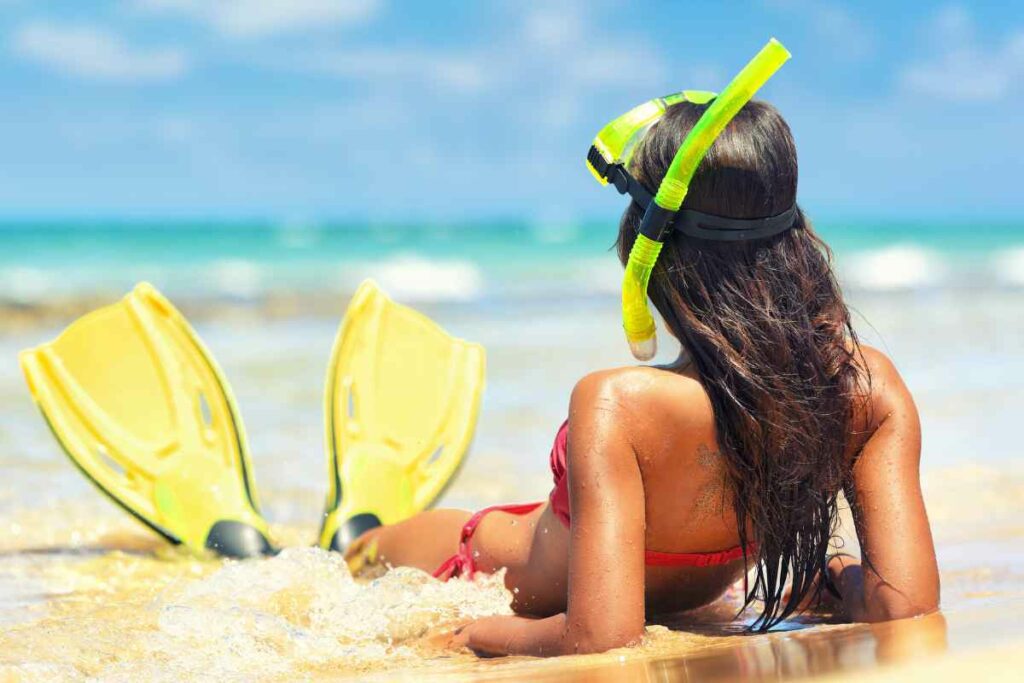
Transportation and Storage
Consider how you will transport and store your scuba fins during travel. Look for fins that come with a protective carrying bag or case. This helps to prevent damage and keeps the fins organized.
Some fins have a detachable blade feature, allowing you to separate the foot pocket from the blade for more compact packing.
There are fins with a foldable design that can be folded in half, further reducing their size for travel.
Also, ensure to get a good travel insurance cover that will cater for damages to your gear.
Type of Fin
There are mainly two types of scuba diving fins:
Open heel fins are designed to be used with dive boots and have an adjustable strap, providing a more secure fit. Full foot fins are designed to be worn without boots and have a pocket for your bare feet.
If you’re diving in cold water or prefer added protection for your feet, go for open heel fins. Full-foot fins are great for warm-water dives and snorkeling.
Blade Style
The blade style of scuba diving fins can vary, and each has its characteristics.
The main blade styles are:
- Paddle Blade: This style offers excellent power and stability, making them suitable for divers who want maximum propulsion. Paddle blades are often preferred for technical diving and strong currents.
- Split Blade: Split blades have a split down the middle, allowing water to pass through more easily. They provide a more efficient kick and are lighter than paddle blades, offering increased comfort and reduced fatigue during longer dives.
Take a look
- 7 Best Wetsuits for Surfing
- 4 Best Portable Travel Bidets
Additional Features
Some scuba diving fins come with additional features that can enhance your overall diving experience.
These may include:
- Channeling or Vents : These features help to direct water flow, increasing thrust and reducing resistance for a more efficient kick.
- Quick Release Buckles : These allow for easy donning and doffing of the fins, particularly useful if you’re frequently taking them on and off during dives.
Selecting the right scuba fins is crucial for an enjoyable and efficient diving experience, especially for travelers. These scuba fins mentioned above offer a combination of performance, durability, and travel-friendly features.
Whether you prioritize power, maneuverability, or compactness, these fins provide excellent options to enhance your underwater adventures. Remember to choose fins that fit properly and align with your diving preferences to ensure maximum comfort and safety.
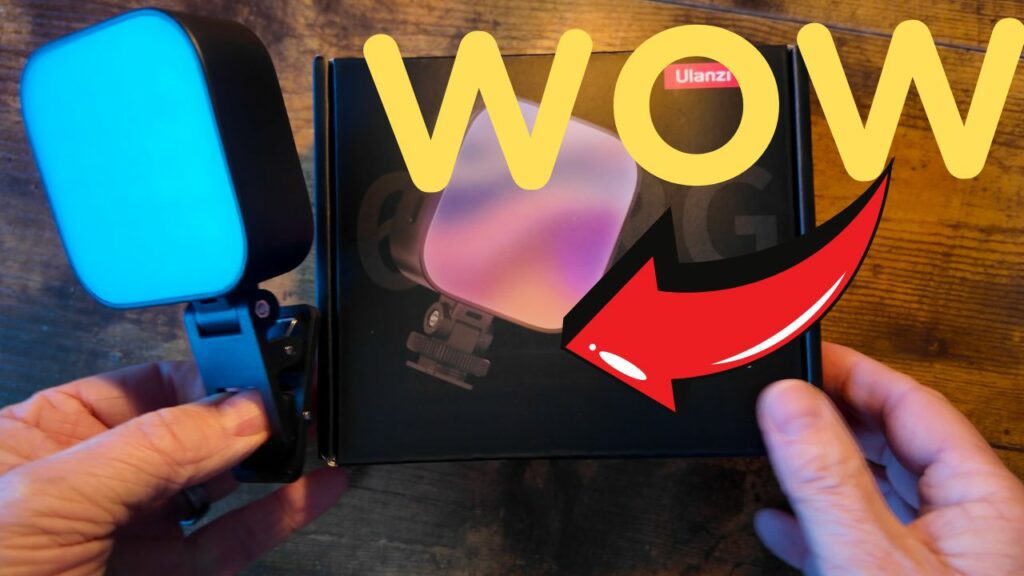
Affiliate Disclaimer
As an affiliate, we may earn a commission from qualifying purchases. We get commissions for purchases made through links on this website from Amazon and other third parties.
Latest posts
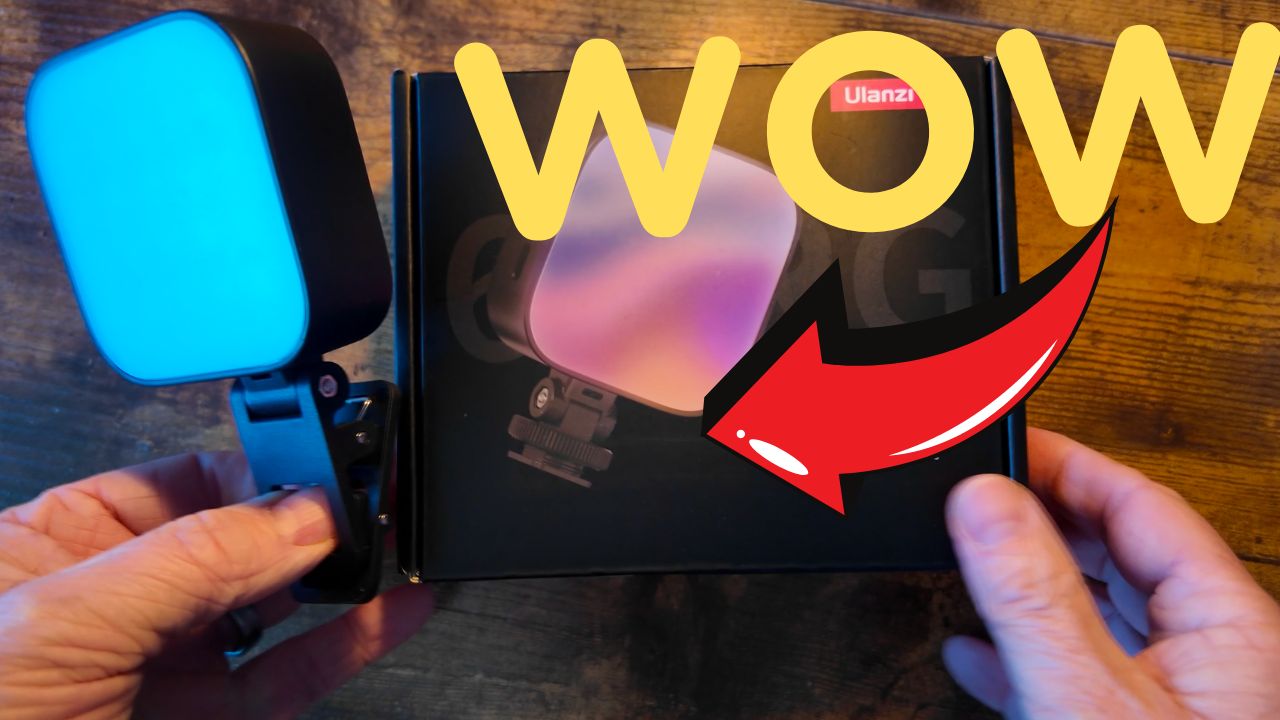
Ulanzi U60 RGB Video Light Review: Top Vloggers’ Choice?

What Is Malta Famous For? Malta Local History and Past Events

Do IndiGo Airlines Provide Headphones? In-Flight Entertainment Explained

Best Scuba Fins of 2024
- Best Fins Overall – TOP PICK
- Best Hybrid Fins
- Best “Classic” Style Fins
- Best Travel Fins
- Cheapest Scuba Fins
By Alex Hatton
Last Updated:
September 27, 2023
21 Best Scuba Fins of 2024 - Reviews by the Diving Squad
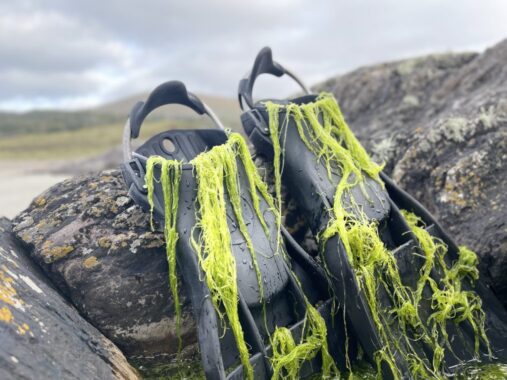
Buying your own pair of scuba fins is one of the smartest things you can do to get the most out of your dives.
Choosing your own pair of fins means you can get the perfect size for your foot; eliminating the ankle cramp so often experienced when using rental fins.
Also, you can buy a design of fin that suits you best. Some fins are super powerful yet heavy. Others are lightweight and compact; perfect for travel!
On this page, we’ve reviewed the best scuba fins of 2024. Dive down to the QUICK ANSWER for a brief synopsis of each fin or descend deeper for our Detailed Reviews
How did we create these reviews?
By being huge scuba-nerds! We’ve given detailed feedback of the fins we’ve owned and tried whilst also interviewing other divers about theirs.
You’ll find real-life user-stories of trying out these fins, original photos and even get to see which parts of the world we’ve used them in.
Whilst creating these reviews; we’ve taken into account key factors such as the cost of a pair of fins, how heavy, durable and compact they are and any special aspects of their design.
For example some fins are designed to be extra manoeuvrable whereas others are created to fit super small or large feet!
My favourite dive fins are the Apeks RK3 – they are short and wide making them powerful and perfect for frog-kicking as well as great in enclosed spaces.
Virtually all the fins we’ve reviewed are open-heel, which are easier to take on and off and adjust compared to closed-heel fins making them perfect for scuba diving.
So, let’s dive in and take a closer look…
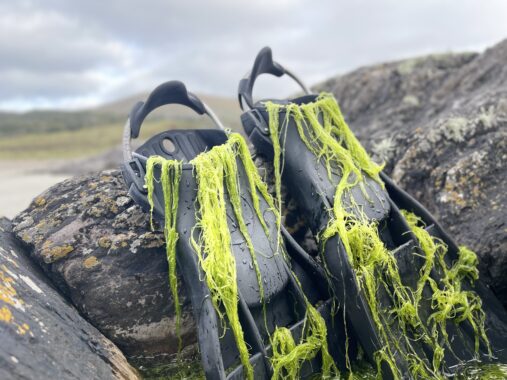
QUICK ANSWER
1) top pick: apeks rk3, 2) best hybrid fins: scubapro seawing nova, 3) best "classic" fins: tusa sf-22 solla, 4) best fins for travel: scubapro go travel, 5) cheapest fins: tusa liberator x-ten, 6) best range of colours & patterns: scubapro jet, 7) best split fins: atomic smoke on the water, 8) best rental fins: mares avanti qauttro+, 9) manta inspired: oceanic manta ray, 10) extra secure fit: mares x-stream, reviews: best scuba fins.
- Our TOP PICK : Apeks RK3
- Best Hybrid Fins: ScubaPro Seawing Nova
- Best “Classic” Fins: Tusa SF-22 Solla
- Best Fins for Travel: ScubaPro Go Travel
- Cheapest Scuba Fins : Tusa Liberator X-Ten
- Best Range of Colours & Patterns: ScubaPro Go Jet
- Best Split Fins: Atomic Smoke on the Water
- Best Rental Fins: Mares Avanti Quattro+
- Best Manta Inspired Fins: Oceanic Manta Ray
- Best Fins for Extra Secure Fit: Mares X-Stream
1) TOP PICK: Apeks RK3 Fins
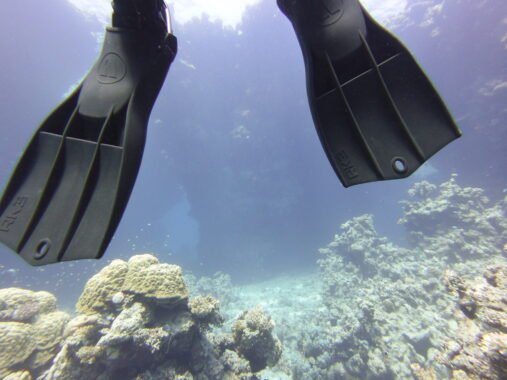
- Price: > $$$
- Tec Fin Design: Short & Wide
- Awesome Power & Thrust
- Great for Frog-Kicking
- Vents for Extra Power
- Spring Heel Strap
My favourite dive fins of all time, the Apeks RK3 fins are insanely powerful! They have tec blades meaning they’re shorter and wider than standard paddle fins; this combined with channels (open-gaps) across these blades means you get a huge amount of thrust combined with less resistance when kicking.
Being made of a durable thermoplastic rubber material that can withstand extreme abuse, they’re phenomenally durable.
Because they’re shorter, the Apeks RK3 fins are also superb for frog-kicking as well as great within confined spaces such as wrecks and caves. They have been the standard gear issued to US military and coast guard divers for decades.
One con I will point out is that because the Apeks RK3 fins are so bulky and heavy, they take up more packing space; however, in my opinion the awesome performance that they provide is well worth it.
They’re also extremely comfortable to wear thanks to the ergonomic foot-pocket and the spring heel straps which compress and contract with changing pressure caused by depth to ensure a consistent fit on all stages of the dive.
- Super Powerful
- Insanely Durable
- Comfortable
- Spring heel strap for consistent fit
- Great for frog-kicks and in confined spaces
- Bulky and heavy – take up a fair bit of packing space
- No small size
2) Best Hybrid Fins: Scubapro Seawing Nova
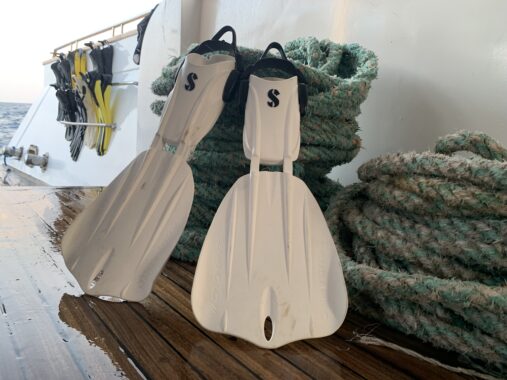
- Hybrid Design – Extra Manoeuvrability & Agility
- Light and Easy to Use
- Comfortable Foot Pocket Design
Followin a unique design, Scubapro Seawing Nova Fins were created to combine the power , ease of use and manoeuvrability of paddle fins with the comfort, efficiency and lift of split fins.
To achieve this, they feature articulated joints which allow them to effortlessly propel the wearer through the water with speed and agility .
Think of how a dolphin’s tail moves as it swims: the tail’s natural structure makes it bend and this provides the animal with a lot of power. By having articulated joints, the seawing novas work in much the same way!
Pivot control ensures the most efficient angle of attack is maintained so that no matter how hard or soft you kick, these fins generate thrust with minimal effort and without drag.
Once more like the dolphins tails by which they’re inspired, the blades feature a varied geometry so that as the foot moves downward, the fin flattens out to provide extra thrust and power.
Ridges and winglets on the inner blade assist with channeling water in the right direction for optimum balance.
The spring straps automatically adjust to changes in pressure and have a large finger tab for easy pulling back to make donning and doffing a breeze.
Quirky in design and exceptional in performance, the Scubapro Seawing Nova Fins are another example of the exciting technology being incorporated into modern dive fins.
- Strong yet flexible.
- Spring heel strap.
- Wide trailing edge adds extra propulsion.
- Grommet hole on end of each blade for easy carrying.
- Available in a variety of colours.
- Articulated joints provide a lot of power and agility.
- A little awkward to pack.
3) Best "Classic" Fins: TUSA SF-22 Solla
- Price: > $$
- “Classic” Paddle Fin Design
- Good Balance of Power and Lightness
- Don’t require much strength to use
TUSA are a hugely respected scuba gear manufacturer, having been established since the 50’s. They’re well known for producing high quality dive equipment that performs well without relying on fancy designs.
Enter the Tusa SF-22 Solla fins! These fins incorporate the classic “paddle” style blade that has served as the baseline fin design for decades and enjoyed immense success.
Paddle blade fins provide awesome versatility; they’re more powerful than fancy fin designs like split fins yet aren’t as heavy as tec fins and therefore require less effort to kick with.
Still, to keep with the times, Tusa have modified the paddle blades slightly: they’ve added a 20 degree angle to the blade with channels as well as side-rails to provide maximum power and manoeuvrability.
The finished product is a pair of fins that are very much still classic paddle blade fins but now have a few modern modifications for improved performance.
Highly popular among beginner-intermediate scuba divers and as rental gear among dive centres, the Tusa SF-22 Solla offer superb value for money and are a great option for beginners.
- Lots of colour options.
- Easy donning and doffing.
- Adjustment is easy.
- Extremely comfortable.
- Deliver superior propulsion with only moderate output.
- No spring-heel strap as seen in more expensive options.
- Not the all-time cheapest (they are mid-priced).
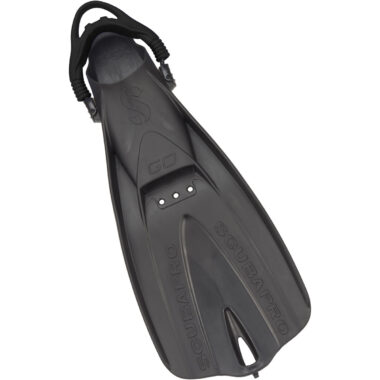
- Super Lightweight and Compact
- Slot into eachother for Easy Packing
Scubapro Go fins have been designed especially for travel – they’re the most lightweight scuba diving fins out there, with a pair weighing just 2.6 lbs / 1.2 kg (size M-L) – including the bungee straps!
These compact fins also feature an innovative stacking system : an interlocking tooth on one fin blade hooks into the second fin and then the bungee strap from the second fin hooks the heel of the first into place.
Just like that, the ScubaPro Go fins are stacked together and it’s like only having to pack one fin!
Despite the Go Travel fins lightness they’re still incredibly durable due to being made from 100% monoprene .
It’s actually quite surprising how strong these ultra light fins can be – they are able to deliver a good amount of thrust with minimal effort.
The blades have a 25 degree to accommodate for diver leg bend and also feature power bars on the underside of the rail to deliver excellent speed , stability and manoeuvrability .
A self-adjusting bungee heel strap allowing for a versatile fit. The open toe foot pocket is comfortable against a bare heel, which is just as well as the foot pocket won’t accommodate dive boots ; however it can fit neo socks.
- Extremely lightweight and compact.
- Stacking system for easy packing.
- Highly durable.
- Decent amount of power.
- Good stability and manoeuvrability.
- Can’t fit dive boots in the foot pocket.
- Only available in black or white.
5) Cheapest Scuba Fins: Tusa Liberator X-Ten
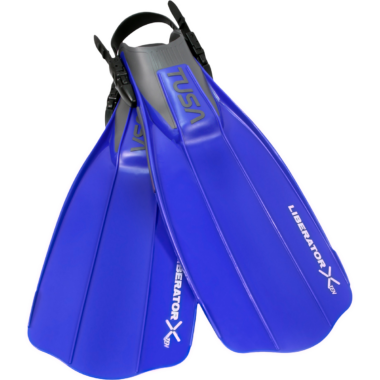
- Price: > $
- Paddle Fin Design
- Decent Power and Manoeuvrability
If you’re on a low budget , the Liberator X-Ten series are far more affordable than most other fins yet still offer very decent quality.
They’re reliable, easy to get on and they also provide ample thrust and power.
On top of this, they incorporate a hydrodynamic design, made from a specially compliant material to provide extra stability and flexibility .
The comfortable open heel pocket is lightweight and fits most foot types, although it’s worth mentioning that these fins do only come in two sizes: small and regular ( see more info on fin sizing here ).
TUSA’s EZ strap and buckle system with squeeze side style release buckles allows the fins to be quickly and easily adjusted with minimal effort, even as they’re being worn.
Low cost yet high quality and easy to get the best out of, the Tusa Liberator X-Ten fins are the best option for any diver looking to save money.
- Cheapest scuba diving fins.
- Still offer high performance and durability.
- Compact, light and easy to pack.
- Not quite as durable as more expensive fins
- No special features (e.g. rails, vents, etc) on blades.
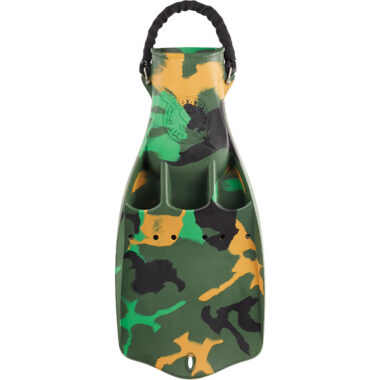
- Huge Range of Designs
- Tec Fins: Short & Wide
- Perfect for Frog Kicking
- Awesome Power
- Vents for Extra Thrust
Since the 60’s, ScubaPro have the dive gear manufacturer of choice for those who like high quality equipment that looks awesome.
Enter the ScubaPro Jet fins – you wont find any other pair of fins available in such a wide range of colours and patterns as these!
But there’s more to these fins then just looking cool. With a classic tec design; they’re powerful and sturdy; this power is further enhanced by vents through the blades.
Water flows through the vents on the down stroke which reduces pressure on the leg. When fining on the up stroke, the vent’s angle means the fin acts as a solid blade for maximum thrust.
They also come equipped with corrosion resistant spring heel straps which are easy to adjust as well as ditch and don.
Spring heel straps are depth compensating – when you go deep and your dive boots compress due to increased water pressure, they contract. They re-expand upon ascent, ensuring a consistent fit during the whole dive.
Do note, these fins foot pockets are pretty small, so if you want to wear a dive boot with them, you might want to consider getting an extra size up than you normally would ( more info on fin sizing here ! ).
- Vented design offers unparalleled power and thrust.
- Grommet hole one each blade for carabiner attachment makes fins easy to carry.
- Spring heel strap adjusts to changes in pressure at different depths.
- Comfortable foot pocket.
- Easy to adjust, ditch and don.
- Extremely durable.
- Most expensive scuba diving fins for beginners.
- Bulky and a little heavy.
7) Best Split Fins: Atomic Aquatics Split Fins
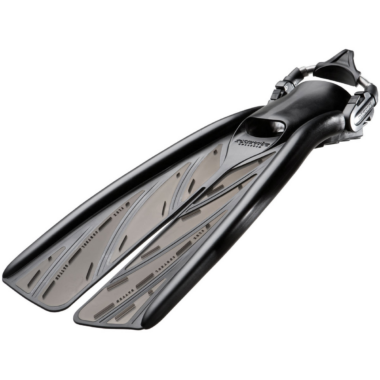
- Split Fin Design
- Next-level Agility and Manoeuvrability
- Require very little strength to use
Splitfins require some practice but when used correctly they have a lot of potential.
When you kick using splitfins, the two separate blades of each fin twist and in doing so create a propeller surface that significantly and easily increases lift .
Atomic Aquatics have persisted with the split fin design since the early 2000’s – their newest model: the “smoke on the water” series of split fins take the best elements of the split concept and makes it easier to use.
Created using the latest plastic polymer technology to give a lightweight fin that’s excellent for travel, these surprisingly durable fins have the capacity to provide huge amounts of kicking power.
The semi rigged flex battens set in the soft blades control the precise wing shape to optimize thrust and reduce drag whilst a highly flexible hinge point between the battens causes the blade to react quickly to the slightest kick.
Also, the large surface area of each blade improves pivoting , turning and alternate kick cycles and there are power rails on either side perform to act as the backbone of each fin, storing and releasing energy with every kick.
These fins are exceptionally comfortable thanks to the anatomically contoured foot pocket which is specially moulded to fit the foot without any stress points and features a semi open toe .
They are equipped with a spring heel strap that automatically compensates for changes in boot compensation and adjust with changes in depth.
- Easier to use than other split fins.
- High kicking power for minimal effort.
- Excellent pivoting and turning.
- Can use alternate kick cycles.
- Spring heel strap = consistent fit.
- Comfortable foot pocket.
- Reduced drag and improved thrust.
- Only available in one colour.
- A split fin take some getting used to.
8) Best Rental Fins: Mares Avanti Quattro+
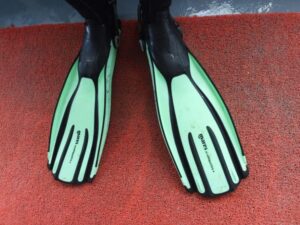
- Most Commonly Used Rental Fins by Dive Centres
- Reliable and Easy to Use
- Good Combo of Power and Lightness
- Channels for Extra Thrust
The Mares Avanti are a long running and well known line of scuba diving fins. Because of their comfort and ease of use, they’re extremely popular with dive shops as rental equipment , which lends testimony to their reliability.
The newest model of Mares Avanti fins: the Quattro Plus have four channel grooves to optimise thrust angle . They also have stabilising trim tabs to enhance strength for improved kicking motion.
As well as this, the blades are lighter and softer compared to previous models, meaning less strain is put on the calf muscles.
These features, combined with an ergonomic and comfortable foot pocket means the Mares Avanti Quattro Plus fins provide an excellent job of transferring energy from the foot pocket to the fin blade.
The end result is that these comfortable and attractive fins provide more power with less effort.
The simple bungee spring strap makes for easy donning and doffing – it also features a large finger loop to make pulling it back effortless. Because it’s a spring strap, it automatically adjusts to changes in pressure!
Available in a range of colours, the main offset of the Quattro Plus fins is that they’re pricier than other fins, but as far as simplicity and comfort are concerned, they’re some of the highest quality scuba diving fins on the market.
- Available in several subtle colour options.
- Highly durable.
- Easy to get on and off.
- Soft = less effort from the calf muscles.
- Provide a lot of thrust and power.
- Comfortable.
- More expensive than most other beginner’s scuba diving fins.
- A little bulky.
9) Manta Ray Inspired: Oceanic Manta Ray
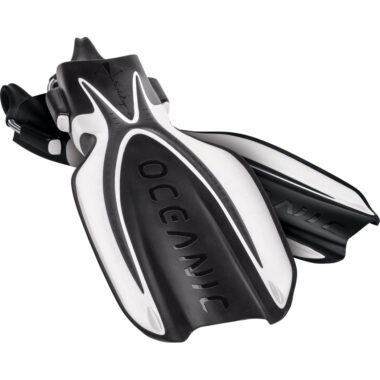
- Inspired by Manta Ray Body Shape
- Awesome Propulsion
- Extra Durable
- Winglets along sides for extra thrust and agility
These scuba diving fins do indeed resemble manta rays somewhat and the reason for that is because their design has actually been inspired by the shapes and mechanics of powerful marine animals such as these!
The blades are made from techno-polymer materials to mimic the combined properties of bone’s strength , toughness and lightness. The result is powerful, easily manoeuvrable dive fins with plenty of thrusting power.
Meanwhile, the Power-X system acts as tendon and joint, improving propulsion by flexing during the down stroke and releasing stored energy prior to the upstroke.
The blades also have power channels made from flexible material to stimulate elasticity of skin by directing water flow off the back of the blade to provide superior thrust.
Winglets along the length of each blade act much like power rails by increasing kick power efficiency and keeping the fins tracking in the right direction for optimum balance.
The scuba diving fins come equipped with soft-pad heel spring straps that adjust to changes in pressure and have an ergonomic finger-loop for easy fitting.
The unique easy buckle adjustment (EBA) system allows for more than 2″ (5cm) of precise adjustments for a custom fit.
We love how the highly effective Manta Fins have drawn full inspiration from nature – having been improving aquatic designs for millennia, it knows exactly what it’s doing and can definitely teach us a thing or two!
- Excellent thrust.
- Minimal strain on feet or ankles.
- Comfortable foot pocket moulded specifically for women’s feet.
- Durable and lightweight.
- Range of fin stiffness options.
- Excellent kicking power with minimal effort.
- No channels or vents.
- A little long = slightly less ideal in tight spaces.
10) Extra Secure Fit: Mares X-Stream Fin
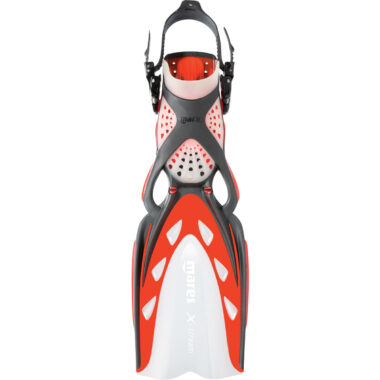
- Hybrid Design
- Awesome Comfort
- Extra Secure Fit
- Light to Use
- Awesome Agility
Mares X-Stream fins have forever redefined how we imagine scuba fins can look but their futuristic appearance does more than just make them look cool .
These extremely high quality dive fins took two years and four patents for Mares to develop; they’re inspired by marine mammals and are immensely popular among experienced divers.
The uniquely designed foot pocket, which is very soft and flexible, is riddled with perforations on the outside to reduce drag.
On the inside, internal ribbing offers an exceptionally comfortable fit by eliminating foot suction and distributing pressure over the foot evenly.
As for the blades, they feature an optimised pivoting system which allows them to maintain an optimal angle throughout the kicking cycle, resulting in a continuous thrust with minimal effort and great stability.
The blades also feature a large central super channel in addition to two traditional lateral channels for added thrust. These channels are surrounded by vents to reduce turbulence during each fin stroke.
The adjustable straps and buckles are of the Mares patented ABS design come equipped with large pull tabs for easy donning and doffing and can easily be adjusted whilst being worn.
- 4 Mares patents
- Extremely comfortable foot pocket.
- High performing blades with plenty of kick power.
- Super channel and vents for extra thrust.
- Optimized pivoting angle = more kicking power with less effort.
- No spring heel strap.
- Expensive.
11) Short Elasticated Fins: AquaLung Express ADJ
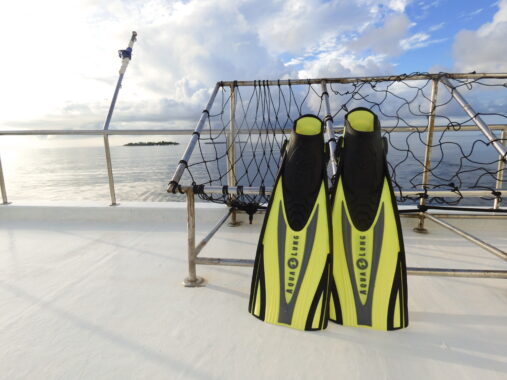
- Easy Donning & Doffing
- Compact and easy to pack
- Elasticated Membrane for Extra Thrust
Lightweight, simple and comfortable, AquaLung Stratos ADJ fins shorter than most dive fins which makes them great for frog-kicking and use in tight spaces such as shipwrecks and caves.
An elasticated membrane stretches over the blades which stores and releases power allowing excellent thrust – that said you need to have some leg strength already to get the most out of them.
The bungee strap adjusts to pressure changes whilst the quick releases makes for easy donning and doffing . Rubber anti-slip pads on the foot pocket provide a comfortable fit that suits most foot shapes.
These are stylish and attractive fins available in several vibrant acrylic colours that makes the wearer easy to identify underwater, even in poor visibility conditions.
Overall if you’re looking for a fairly affordable pair of short fins that are durable, comfortable and powerful – provided you use them right, they’re a pretty decent option.
- Budget Friendly.
- Soft and flexible.
- Powerful with lots of thrust.
- Provide good comfort. .
- No channels, vertical stabilizers or other special features.
- Limited selection of colours.
12) Stylish Design: Atomic Blade
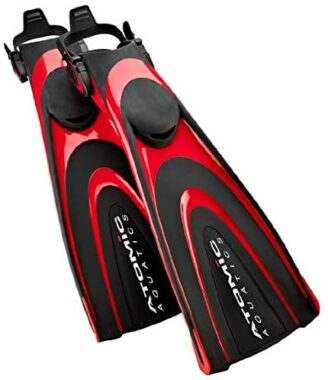
- Acrylic Colours
- Quirky Visual Appeal
- Paddle Blade Design
- Feels as if fins are “bolted to foot”
Inspired by the structural frames used within race cars, the Atomic Bladefin’s unique design means that the top part of the foot pocket is actually part of a single structure that includes the frame rails.
The lower half of the pocket; which is connected underneath, gives the wearer a feeling as if the fin is bolted to the foot, which creates an extra secure fit as well as providing maximum sensitivity between feet and fins.
Ultimately this means that the Atomic blade fin’s quirky design provides two benefits – it results in a pair of extremely slick and streamlined looking fins and it enhances their performance!
Atomic Bladefins are available in a variety of bright colours and with their unique design and “wicked fin and buckle styling” system, make for a trendy and obvious compliment to the Atomic series scuba masks and snorkels.
Vertical stabilisers on each fin capture water and channel the flow down each blade and off the stabilizer tips – this keeps the blades tracking in the right direction for enhanced user stability and balance.
Power is controlled with two frame structures (monocoque and framerail) to fully optimise the paddle design for maximum kicking effort.
The EZ lock buckle system lets you effortlessly snap the buckle on and off, with zero risk of it accidentally coming undone.
These are the most expensive beginner’s fins going but if you can afford them they offer fantastic comfort and sensitivity, whilst also looking insanely cool!
- Unique design.
- Extra sensitivity between feet and fins.
- Comfortable and secure fit.
- Stylish and attractive appearance.
- Vertical stabilizers improve balance.
- Lightweight and easy to pack.
- More expensive than other beginner’s fins.
13) Extra Stiff Fins: Seac Propulsion S
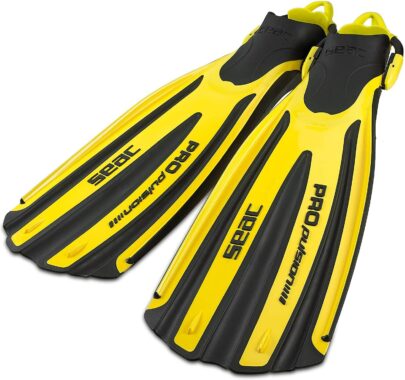
- Extra Stiff for More Power
- But Require a lot of strength to use
- Channels and Rails for Extra Thrust and Power
These sleek scuba fins are designed by the Italian manufacturer Seac. They’re built for power with long running channels, narrow side rails and an extra stiff structure for providing superb thrust and acceleration.
It’s worth noting that the extra stiffness of the Propulsion S fins does mean they take more effort to use, so they’re really suited for a diver who is physically very fit and won’t tire from having to use more energy for each kick cycle.
Donning and doffing is easy thanks to the simple bungee strap which comes with a large, easy to grasp finger loop . The foot pocket has been designed for comfort as well as to reduce ankle twisting and fatigue that might come with using stiffer fins.
Sea Propulsion S fins are made from an insanely durable rubber. It holds up well at low temperatures and is also uv and crack resistant , meaning a pair of these fins should last a long time.
Do bear in mind, that these fins are longer than most other options we’ve reviewed and subsequently they can take up more packing space!
If you’re physically fit and an experienced swimmer, you can get a decent amount of power from these simple to use fins, however if you’re swimming technique is less developed check out the Tusa Solla instead!
- Extra stiff = extra power.
- Super thrust and acceleration.
- Easy to take on and off.
- Easy to adjust, even whilst wearing.
- Exceptionally durable.
- Weaker swimmers will tire when using these.
- Takes up a lot of packing space compared to other scuba diving fins.
14) Super Adjustable: Dive Rite XT Fins
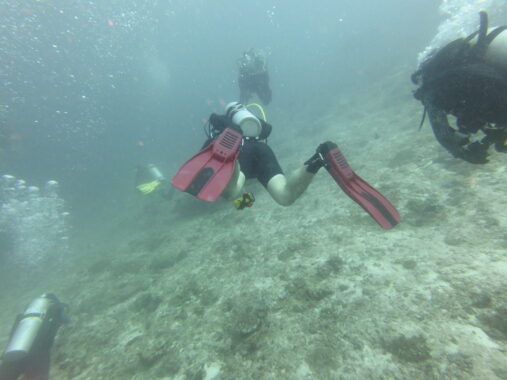
- Super Adjustable
- Extra Secure and Comfortable Fit
Compared to longer running dive gear manufacturers like Mares, Scubapro and Tusa, Dive Rite are fairly new; only being founded in 1984.
However, over the past few decades, they’ve gained a strong reputation for producing reliable, no-fuss dive gear and the XT Fins are arguably their nicest piece of kit yet.
Updated in 2020, these fins now have a POM swivel buckle that secures the marine grade stainless steel spring-strap to the blade and which can swivel out of the way for easier donning and doffing.
(Do note, currently, it’s only the red and black versions of these fins that feature the POM swivel buckle!).
To ensure a constant fit, the spring heel strap automatically adjusts for the changes in dive boot compensation that come with pressure differences caused by changing depth.
Divers can further customize their strap fit by moving the buckle locking screw between two positions – a feature not usually seen in dive fins and one that ensures you can get a 100% perfect fit!
Dive Rite XT Fins are moulded from a monoprene blend to strike the perfect balance of power to work ratio, providing efficient finning whether in high flow or stiff currents.
The blade is shaped for a variety of kicks including modified flutter, frog kicks and power kicks providing stellar manoeuvrability and balance throughout
- Durable and lightweight.
- POM swivel buckle.
- Customize strap with 2 lock screw positions.
- Excellent power and thrust.
- Comfortable, secure fit.
- Minimal effort to use.
- A little long = slightly less ideal for tight spaces than shorter fins such as tech fins.
- Bulky to pack.
15) Mid-Priced Split Fins: ScubaPro Twin Jet
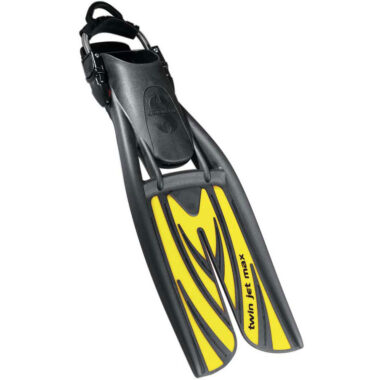
- Extra Agility and Manoeuvrability
- Require Little Strength to use
Split fins are able to provide a lot of power with minimal kicking effort but achieving this does require a knowledge of how to use them properly.
Although we’ve reviewed the Atomic Aquatics Smoke on the Water as the best quality split fins overall, one thing the Smoke on the Water fins don’t have is any colour choice – they’re only available in silver.
Enter the Scubapro Twin Jet fins which come in many vibrant colours and are also more affordable.
Manufactured from a bi-material for the ultimate blending of flexibility and performance; whilst producing a slightly stiffer blade, they’re ideal for divers who prefer a little more feedback / sensitivity.
The distinctive hydrofoil shape allows water to flow between and around each of the twin blades for enhanced propulsion .
An extended soleplate provides additional leverage to improve power transfer from foot to fin, whilst side rails enhance blade stability throughout each kick.
To give even more kicking power , vents between the foot pocket and the blade helps water move around the fins with each kick cycle, greatly reducing drag.
The soft, open heel foot pocket offers a comfortable fit whilst the spring heel straps make ditching and donning a breeze as well as adjusting to changes in pressure caused by altering depths.
- Split fin design can be highly effective.
- Exerts minimal strain on ankle or leg.
- Flexible yet stiff.
- Vents and side rails + spring heel straps!
- Easy to don and doff.
- Comfortable.
- Split fins take a little getting used to!
16) Designed for Women's Feet: Aqua Shot FX
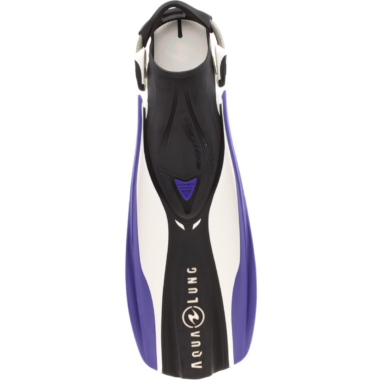
- Foot Pocket Specially Moulded for Women’s Feet
- Provides Extra Comfort
The Aqua Shot FX has taken successful features from unisex fins and incorporated them into a design with a foot pocket that’s been moulded especially for women’s foot proportions.
It is narrower and more slight than traditional unisex fin’s foot pockets and also features a customised inner sole to provide a grip effect.
In addition to providing a comfortable and specialist fit, these dive fins offer next level performance, thanks to the many awesome features they’ve borrowed from popular unisex models.
For maximum energy transmission, the foot pocket features a “power transmission zone” which anchors the foot to prevent unnecessary stretching of the pocket on the power stroke.
The power zone also sports integrated “V Boosters” to provide optimal power with each kick, whilst also providing the diver with a mid-foot pivot point on the fin, to eliminate foot and toe fatigue.
Side rails improve stability and balance underwater whilst adding to overall power by reducing drag.
Spring straps automatically compensate for pressure depth changes and make donning and doffing a breeze.
The Shot FX’ blade is shorter and softer than that of classic fins which makes them easier to kick, however stiffness increases with size, so divers can choose the optimum stiffness for their preferred diving style.
Available in a range of colours and with a sleek, modern design these high quality fins are ideal for women who find unisex fins don’t provide a comfortable or secure enough fit.
17) Cheapest Split Fins: TUSA X-Pert Zoom Z3
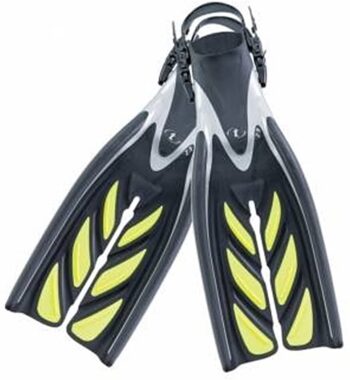
- Split Fin Design (Cheapest Available)
- Great Agility with Little Strength Required
As we’ve seen, split fins generate more thrust with less effort when used correctly . However, the downside of split fins is that due to their highly specialised design, they tend to be quite expensive; especially when they’re also open-heeled, which scuba divers will want them to be.
That said, the X-Pert Zoom Z3 fins are considerably cheaper than other open heel split fins!
It’s not too surprising that these durable and stylish fins are designed by TUSA; considering their snazzy colour design, which is available in several bright colours.
These fins feature reinforced blade rails to keeps the split blades close together for optimum stability as well as optimized blade scoops for directing water behind them for increased thrust.
They also sport TUSA’s patented 27 degree angle blade design, which compensates for the leg’s natural bend and in doing so, keeps the fin in perfect position throughout the kick cycle resulting in more efficient kick cycles.
The EZ buckle system with squeeze-style side releases allows for quick and easy adjustments. It’d be great if it featured spring heel straps as well, but for the extremely reasonable price point, it’s not too surprising that it doesn’t.
- Affordable.
- Decent quality.
- Light and sturdy.
- Blade rails and scoops for improved thrust.
- TUSA are a highly respected brand renowned for good scuba gear.
- 27 degree angle means it is harder to pack.
- No spring heel straps.
18) Tec Fins with Channels: Hollis F1 Bat Fins
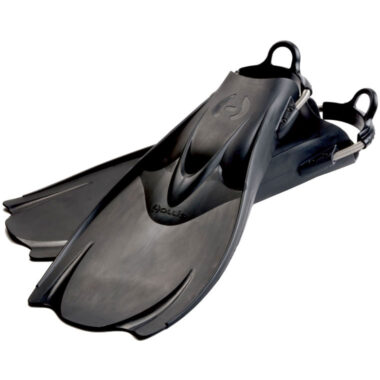
- Tec Fins = Short and Wide
- Awesome in Enclosed Spaces like Wrecks and Tunnels
- Great for Frog Kicking
- Great Power and Thrust
Hollis F1 Bat fins are built for power , manoeuvrability and toughness , being similar to the vented Apeks RK3 fins in this regard. However instead of vents, F1 Bat fins feature blade tip channels for enhanced acceleration .
To be honest, we prefer vents over channels – they offer more power which is why the Apeks RK3 fins are our favourite tech diving fins. That said, channels may be preferred by some depending on their diving style!
The F1 Bat tech fins are relatively short and wide fins, which makes them ideal for enclosed spaces and the frog kick although they’ll work with any kick cycle.
They feature an extremely comfortable steel spring heel strap, which in addition to changing in response to depth, is angled for improved comfort .
Also, the spring heel fin straps have unusually large tab loops – besides making it effortless to get the fins on and off, these are large enough that you can hang the fins by them for quick and easy drying .
Being constructed from high-grade, heavy-duty rubber, the Hollis F1 bat fins offer superb strength and durability – they’re virtually indestructible and can handle practically any temperature or rough handling.
As a scuba gear manufacturer, Hollis like to keep things simple, yet efficient and the popular Hollis F1 bat fins are exactly that.
- Powerful and strong.
- Extremely durable.
- Channels for improved acceleration.
- Good for tight spaces.
- Can hang up to dry.
- A little stiff.
19) Best Full Foot Fins: Mares Volvo Race Full Foot Fins
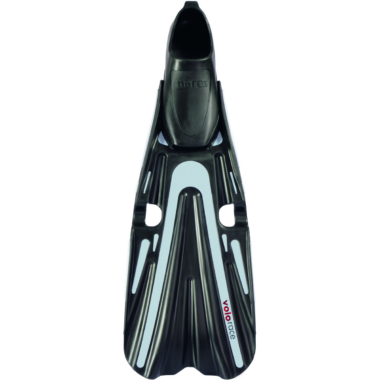
- Full Foot Design
- Extra Light and Compact
- Don’t Require Dive Boots
Unlike an open heel fin (which all the other fins reviewed in this article are), full foot fins are non-adjustable, challenging to take on and off and can’t accommodate dive boots.
For this reason, scuba divers almost universally prefer open heel fins, with full foot fins generally being reserved for snorkeling.
That said, scuba diving is a very particular sport with different diving styles and custom kit outfits and for this reason a small minority of scuba divers do prefer full foot fins.
An advantage of full foot fins is that they do not need to be worn with dive boots and are often cheaper than their open heel fin counterparts.
If you’re unsure which kind of fins to go for, we recommend open heel fins – but if you know you like diving with full foot fins, than the Mares Volvo Race are the most popular choice of full foot fins for scuba diving with.
Sleek, stylish and available in several colours and sizes, they combine lateral channels with a super channel in the centre to provide decent thrust with minimal effort, which is further enhanced by rubber stabilizers .
They also feature an optimised pivoting blade system which results in their providing fluid movement and agility through the water.
The foot pocket is spacious and comfortable and provides a snug fit, whilst the fins themselves are extremely tough and durable.
- Do not need to be worn with dive boots.
- Super channel for extra thrust.
- Optimised blading system = good balance.
- Good range of sleek colours.
- Can’t be worn with dive boots (dive boots keep your feet warm!).
- Difficult to take on and off.
- Can’t be adjusted.
20) For HUGE Feet: XS Scuba Turtle Fins
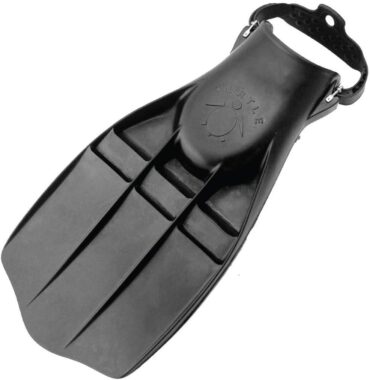
- Specially designed for Massive Feet
- Awesome Power but Require Decent Strength to use
- Tec Fin Design
- Wide and Short
XS Scuba Turtle Fins keep things simple with a wide paddle design featuring vents for extra thrust power.
Water flows through the vents of each blade during the down stroke to reduce pressure and provide less strain on the leg.
Then, during the up stroke, the vent’s angle ensures that the fin reacts as a solid blade resulting in maximum power and propulsion through the water.
These immensely durable, highly efficient tech fins are a popular choice among many combat and tactical units worldwide.
Similar to the Apeks RK3 fins in many ways, the Turtle fins are also quite short which makes them great for confined spaces such as shipwrecks and caves.
The unique rubber compound provides wearers with greater kicking efficiency by reducing the overall weight, whilst also adding a snap back quality for additional acceleration power.
Because they’re only available in the sizes: X-Large, XX-Large and 3X-Large , these fins are ideal for anyone who wants a huge foot pocket, although divers with smaller feet may find the XS Scuba Turtle Fins too big.
They come equipped with adjustable rubber straps, with large pull tabs and eyelets to hang fins on for drying. Unfortunately, these straps are not spring heel, so won’t adjust to changes in pressure!
Ultimately these are high quality, nice tech fins, but we prefer the Apeks RK3 Fins !
- Extremely large size options.
- Good in confined spaces.
- Produce a lot of power with minimal effort.
- Vented design for extra propulsion.
- Only come in large sizes.
- No grommet holes, unlike the Apkes RK3 fins.
- No spring heel straps.
21) For Tiny Feet: ScubaPro Go Sport
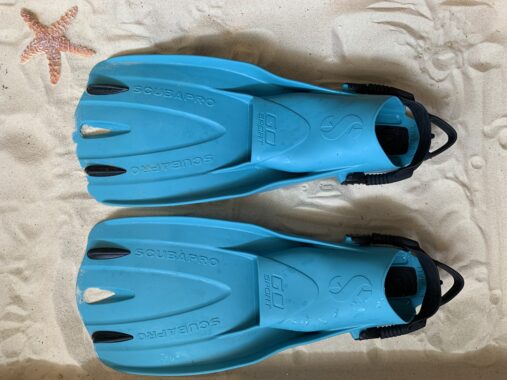
- Specially Designed for Tiny Feet
- Super Light and Compact
- Also great for Travel
The ScubaPro Go Sport fins are one of the very few fins to come in an extra small size for adults.
But besides this extra size option, they’re also great dive fins; being exceptionally light and compact – yet also durable due to a monomer construction, which makes them awesome for travel.
They feature an adjustable bungee strap for max comfort and a pre-angled blade with power bars which provide moderate power.
You can get these fins in a range of colours and they’re also available in small, medium, large and extra large!
Dive Fins: PARTS, TYPES & FEATURES:
CLICK HERE TO ASCEND BACK UP TO THE REVIEWS …or dive deeper below to find out all there is to know about scuba fins!
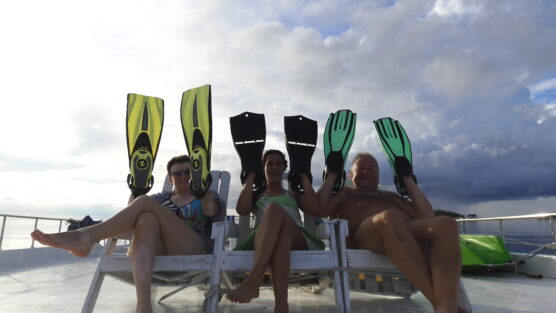
First of, let’s quickly talk about Scuba Diving Fins vs Snorkeling Fins :
Diving fins tend to be stiffer than snorkel fins, which means they generate more thrust but require a bit extra effort to use.
That said, there are many highly efficient makes of dive fin which require minimal physical exertion and yet still generate a lot of power, making them perfect for weaker swimmers.
Whereas snorkeling fins tend to be quite basic, scuba fins often have features such as channels and vents to improve their efficiency.
Dive fins may also come in special designs such as split fins and tech fins.
Generally, dive fins tend to be open heel which makes them easier to don and doff as well as able to accommodate dive boots , which provide insulation; useful for when you’re diving down deep.
Snorkel fins on the other hand, are usually full foot design.
Take our word for it; if you’re planning to use fins for scuba diving, then go for a pair of open heel fins made especially for scuba divers!
This is a Diving Squad article, so you can rest assured that all of the fins reviewed on this page have been designed especially for scuba divers!
Now we’ll cover:
Open Heel vs Full Foot Fins
Dive Fins: Main Parts
Types of Blade / Fin
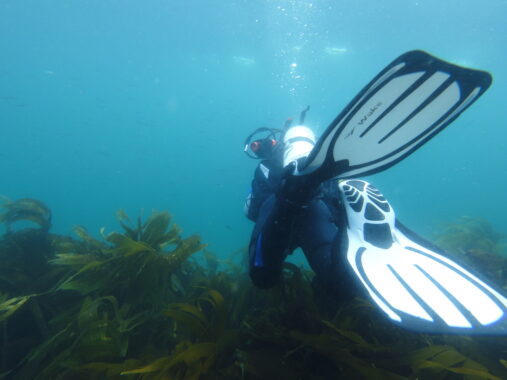
Open Heel Fins:
Study the two images above. The fin on the left is an open heel design – it is open at the back. Because of this, the foot pocket is larger and can accommodate dive boots, which provide insulation. This is extremely handy for diving, because water temperature quickly drops as you dive down deeper.
Open heel fins are held in place by an adjustable strap or a bungee heel strap- or in the case of the very highest quality makes, a spring heel strap, which adjusts to pressure changes with depth, by compressing and relaxing with the boots neoprene, to ensure a consistent fit throughout all parts of the dive.
Open heel fins are a lot easier to take on and off than full foot fins, which comes in seriously handy when already wearing heavy scuba diving gear and maybe being in the water.
For these reasons, the vast majority of scuba divers prefer fins that are of open heel design. Because of this and the fact that we review the most popular gear with scuba divers , all but one of the fins reviewed on this page are of open heel design.
Take our word for it – open heel fins are the way to go for scuba divers!
Full Foot Fins:
The fin on the right is a full foot fin because the foot pocket encompasses the entire foot. Full foot fins are generally used for snorkeling as they don’t need to be so powerful if only being used at the surface.
That said, some makes of scuba diving fins come in a full foot option, which is preferred by a very small minority of divers as it’s cheaper and a bit lighter.
However, full foot fins are much more tricky to get on and off and they can’t accommodate dive boots. So, unless you know for a certain fact that you love diving with full foot fins, we strongly suggest you opt for a pair of open heel dive fins instead!
Fin Features, Parts & Terminology
Fins: 3 main parts:, 1) foot pocket:.
Located at the back of the fin, this is the area you slip your foot into. Most fins are available in a selection of foot pockets sizes – we’ve provided a detailed guide on how to choose the right size fins.
Perhaps the scuba fins with the most unique foot pocket design are the Mares X-Stream which used a revolutionary design with internal ribbing for maximum comfort. There’s also the Aqua Shot FX which features a foot pocket moulded especially for the proportions of a women’s foot (all other scuba fins foot pockets are unisex!).
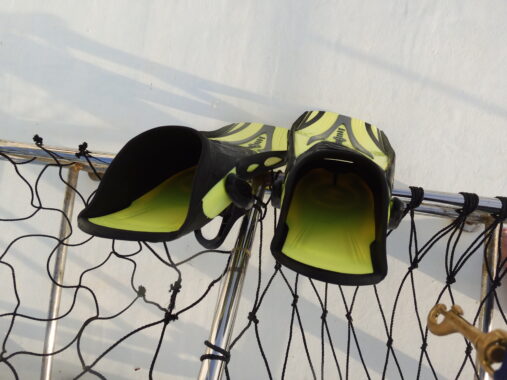
2) Heel Strap - Traditional VS Spring Heel:
Traditionally, fin straps have been made of rubber or silicone and have required manual adjustment using buckles.
In recent times however, the majority of high quality scuba fins have switched to using spring heel straps , which are superior because they ensure a constant fit on all parts of the dive by compensating for depth compression.
Even on dives of only ten or so meters, dive boots experience some compression as water pressure increases, which both decreases the thickness of the boot’s neoprene as well as encourages one’s feet to slide deeper into their fin’s foot pockets.
Spring straps are more tensile than traditional straps and because of this they naturally compensate for the compression and re-expansion of your dive boot over the course of a deep dive, ensuring a consistent fit.
Spring heel straps are also easier to take on and off as you don’t have to fiddle with any buckles – instead simply pull back on the finger tab of the spring strap to remove it from your heel! More affordable scuba fins tend to have bungee spring straps whereas the pricier options use marine grade stainless steel spring straps.
We strongly recommend opting for scuba fins that come with this incredibly useful modern feature which is why just about every pair of scuba fins we’ve reviewed on this page have spring heel straps – but you can rest assured that if they don’t, we’ve pointed it out in the review!
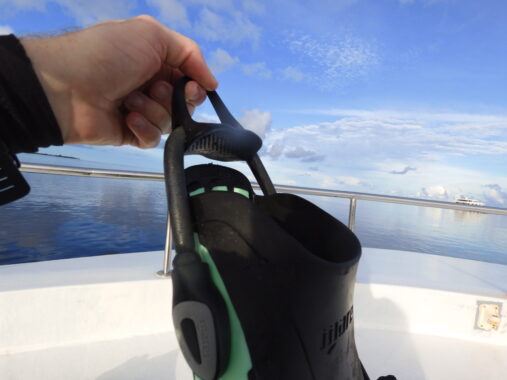
The stars of the show, the blades are the main part of the fin and are used to create the power and thrust to propel you through the water when you kick.
As we’ll discuss a little further below, there’s a few different types of blades – e.g. split blades, tech blades and paddle blades. But first, let’s look at the many performance enhancing features that blades may or may not have:
Blade Features:
Thin, long in-grooves that run the length of each blade, channels collect water and align it for an efficient kick cycle. Generally blades with channels sport one or two symmetrical pairs, but sometimes they may also have a central “super channel” for even more added efficiency.
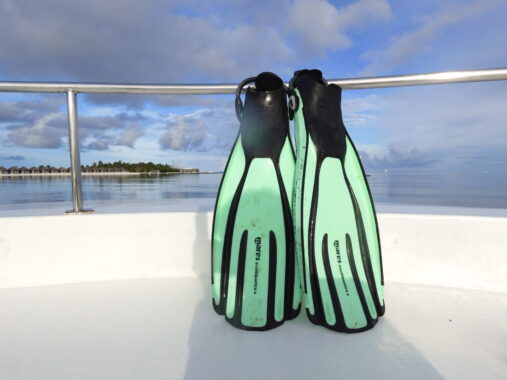
Stabilizers
- Vertical stabilizers on fin tips keep the fin tracking straight up and down with every kick for improved balance.
- Dynamic stabilizers on the blade surfaces and rails facilitate water flow to generate optimum propulsion.
Narrow ridges that run the length of each blade on either side. The frame rail design on each side of the fin mimics a backbone and in doing so adds more kicking power by storing and releasing energy with every stroke.
Grommet Holes
Some fins have grommet holes at one or both ends for attachment of clips and carabiners, to make transporting them easy.
Fin vents are a very efficient means of maximising propulsion and power. They’re instantly recognisable as the grids of slits crossing horizontally over the length of a blade.
So, how do they work? Water flows through the vents on the down stroke of fining, which reduces pressure on the leg. When fining on the up stroke, the vent’s angle means the fin acts as a solid blade for maximum thrust.
What this means is that you get maximum propulsion with minimal physical exertion or leg ache. Nice! Many consider vents to increase scuba fin efficiency more greatly than channels and power rails combined.
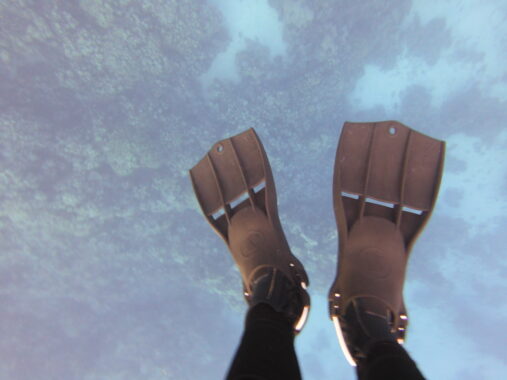
Different Types of Blade Design
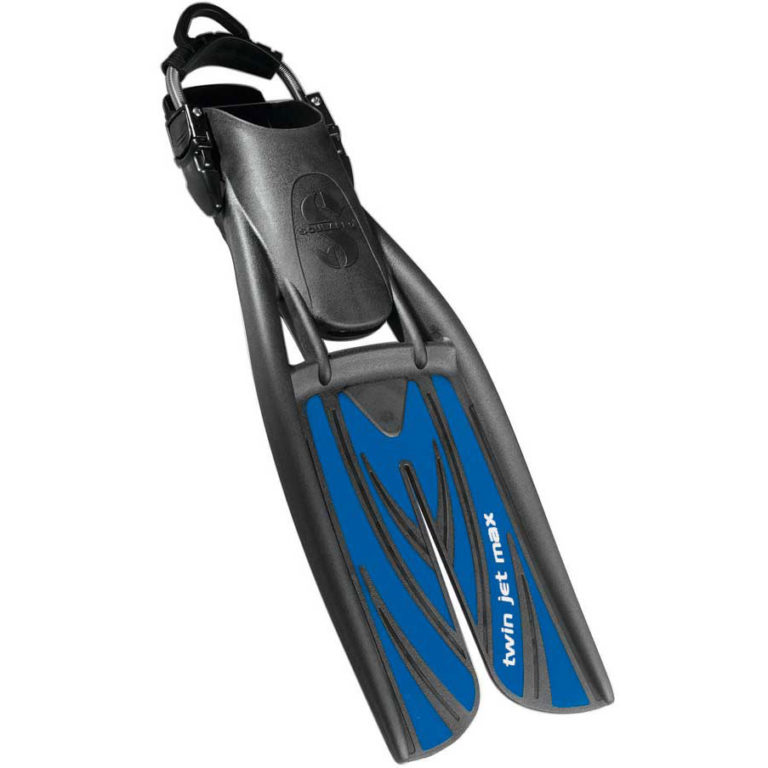
Paddle Blades
The standard blade design is that of a paddle blade aka blade fin. This is the classic, instantly recognisable style of fin, where each fin looks a little like a frog foot or flipper.
This is a broad term that encompasses most fins, including different designs.
For example tech fins and articulated joint fins are different designs, but they’re both paddle fins.
Paddle fins work well especially well with the flutter kick, but shorter models can also work with the frog kick.
Our Top Pick Fin’s for Beginners are Paddle fins!
Split Blades
Split fins are instantly recognisable thanks to the large split running between each blade, splitting it into two independent blades.
In the early 2000’s, split fins became popular for a short while, before being dismissed as gimmicks that didn’t perform well in currents.
However, this was largely due to misunderstanding as back then hardly anyone knew how to use them properly.
Wielded correctly, split fins can provide awesome manoeuvrability and power, whilst reducing resistance on joints, making them an excellent choice for those with sore hips or knees.
Split fins to take a little getting used to, which is why they’re most suited for experienced scuba divers. Generally they work better with narrow flutter kicks and not so well with frog kicking. After you’ve bought your first pair of split fins, try them out in a pool or shallow water and get used to them that way before you take them diving.
Our favourite Split Fins are the Atomic Smoke on Waters!
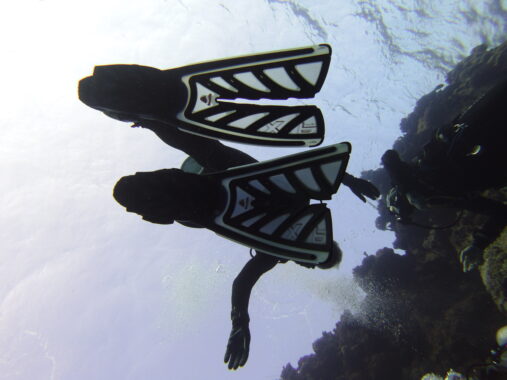
Tech Blades
Tech fins (which are blade / paddle fin in design), tend to be short and wide, with large foot pockets.
Highly durable, simple in design and particularly good for enclosed spaces like wrecks (due to their relative shortness) they are favoured among technical divers and other diving professionals.
However, tech fin’s simplicity, power and ease of use also makes them a great option for recreational divers.
They work especially well with frog kicks, but can also be used with standard flutter kick cycles.
Although they’re a little heavy, tech fins often feature vents which gives them exceptional power as well as spring heel straps meaning they adjust to changing pressure depth.
Our favourite tech fins and also number one fins for advanced divers are the Apeks RK3 Fins .
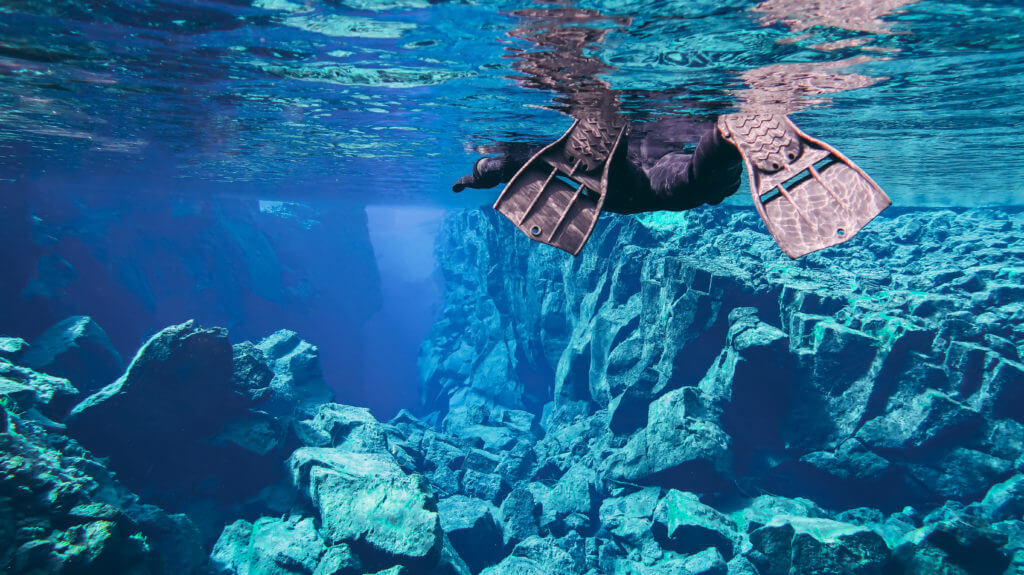
Misc Blades
You may have noticed that a few fins we’ve reviewed, such as the Mares X-Stream and SeaWing Nova whilst technically paddle fins, look totally different to most other fins.
That’s because in today’s tech driven world, new technologies and styles have led to some revolutionary and entirely unique design concepts for diving fins.
Such models offer exceptional comfort as well as awesome performance although their whacky appearance may not appeal to everyone.
They’re also a little bulkier, which makes packing them a tad bit more difficult, though by no means impossible.
If you dig cutting edge technology and consider yourself a diver of the future, they’re worth checking out.
Fins Sizing
Scuba fins are not usually sized by shoe size, but instead by bands – e.g. XS (extra small), S (small), M (medium), L (large) and XL (extra large).
What does make things a little complicated is that the actual shoe size that each band correlates to varies between different scuba gear brands. For example, the medium size band of Tusa fins may not correlate to the exact same shoe size that the medium size band for Scubapro fins does.
Fortunately, once you’ve decided on which scuba diving fins you want to purchase, you can easily go onto the manufacturer’s website and check out which size bands correlate to which shoe size.
Also, a general rule of thumb when buying adjustable open heel fins is that if you’re planning to wear them with dive booties, to add one size up to leave room for said wee’ dive boots.
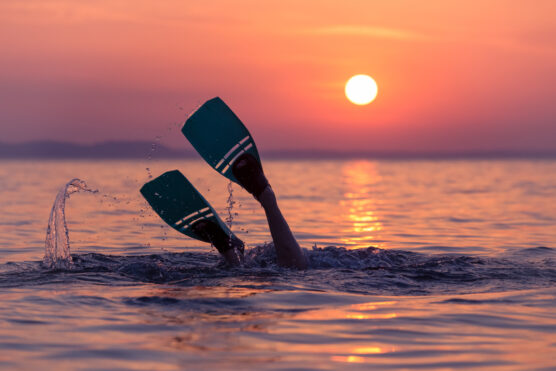
Diving Squad Debriefing
Squad! At ease. You’ve just completed this mega article on the very best scuba diving fins with reviews of the 20 top quality dive fins on the market as well as handy info on fin parts, types, features and sizing.
Being colossal scuba nerds, we’re constantly on the hunt for the latest information regarding scuba diving gear updates and new releases so you can rest easy knowing that what you’ve read here today reflects the very latest and up to date information re the exciting world of scuba fins.
All that remains now is for you to choose and buy your dream pair of dive fins. Good luck…you’ve got this – we believe in you!
Diving Squad signing off.
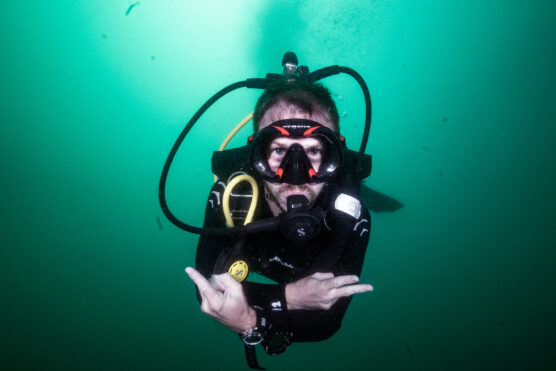
Support the Squad!
We are part of the Amazon Services LLC Associate Program. If you make a purchase on amazon after clicking a link on Diving Squad, we earn a small commission fee, at no extra cost to yourself.
We are also part of several other affiliate programs so if you click on a Diving Squad affiliate link that results in you booking a liveaboard, booking accommodation, purchasing insurance or buying a product somewhere else, once more we make a small commission, without it costing you a cent extra. Thanks!
Written by:

Best Dive Fins for Travel Review
Last Updated: March 28, 2023
If you thought that the wonders of the natural world only exist on land, then you are greatly mistaken.
The oceans are teeming with life, and the underwater world is a universe in itself. Large parts of it remain undiscovered to date, but with more people learning scuba diving, humankind is delving deeper into its depths than ever before.
Do you want to explore this breathtaking landscape for yourself? Well then, you will need proper equipment, foremost among which is a premium-quality pair of fins.
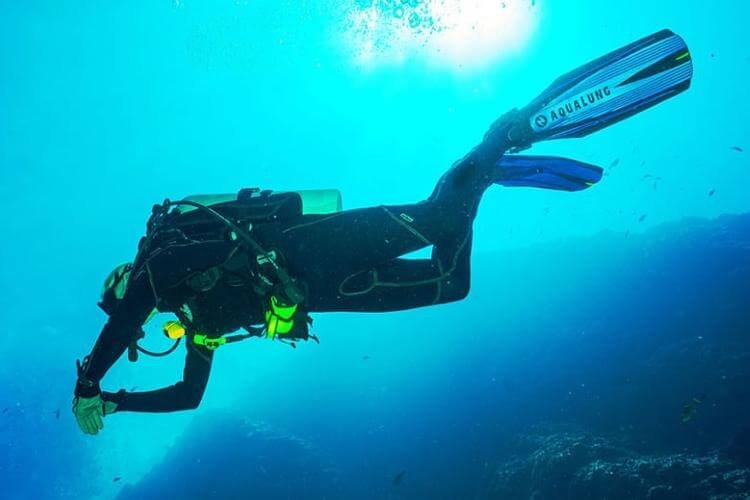
Traveling is a big part of scuba diver’s lives and when planning a diving trip , fins often take a lot of room in your luggage. Have you ever been fed up with your bulging bag? I know I have.
That is why I researched and shortlisted the best 6 scuba fins that are great for travel, so now you can save space for other essential gear.
Best Travel Scuba Fins – Top 6 Picks
1. tusa hyflex switch.

What I like about it
Since I have already mentioned the polyurethane blade system, let’s look at it in greater detail. The manufacturers have designed the fins, keeping in mind the need for divers to change their speed and direction swiftly. As a result, these fins aid fast movement, helping you adapt to the waters.
Also, compared to ordinary blades, the vortex generator reduces water resistance with every stroke, ensuring that you don’t spend much energy. This should make diving comfortable and safe so that you never feel out of breath.
You will find that it comes with a comfortable foot pocket that increases power transfer to the blade. Naturally, you get to go further and dive longer with every stroke, making it a fantastic option.
In other words, the angled fin shape and standard bungee strap will help you cut through the water with ease.
And the best part, you can separate the foot pocket from the blade to fit it in a regular carry-on bag without trouble.
What could be better?
There is some disparity regarding the size, and it would be best to double-check. For instance, certain reviews claim that the fins are a bit wide, and you may have trouble adjusting to the extra width. It may also lead to slight muscle pains, so you should try walking with the fins to get the hang of it first.
- Angular design
- Comfortable foot pockets
- Fin blade can be deattached from foot pocket
- Compact, lightweight & travel-friendly
- Swift movement
2. Scubapro GO Travel Fins

The incredible thing about these fins is that it delivers supreme comfort while completely covering the feet, thanks to its Monprene construction. This makes it flexible without compromising on strength, so that it can withstand heavy-duty and long-term use.
What’s more, unlike the other options, it features an open-heel design, suitable for both snorkelers and globe-trekking divers. Naturally, these fins can be the perfect companion for travel and recreational activities while preventing issues like torn foot pockets, delamination, and broken blades.
But what’s more impressive is its easy portability that makes air travel easy. You will find that the flippers have a Piggy-Back Stack system, whereby the blades interlock with each other to reduce room. As a result, they don’t take up much space, allowing you to carry the fins wherever you go.
In terms of improvements, you must remember that these fins are narrower than their regular counterparts, and it may take time to adjust to the shape. I feel that you can use them for snorkeling and less intense dives before heading out into deeper waters. Also, due to the narrow shape, users with bigger feet may cramp after longer dives.
- Increases agility
- Open-heel design
- Monprene material
- Easy to pack and store
- Slightly narrow
- May lead to cramping
3. Mares Volo Race

Honestly, there are more attractive models available on the market, but these pair of flippers stand out in terms of performance. The composite shape covers the entirety of the foot so that you can use all the muscles for diving longer and exploring the unknown.
Thanks to its anatomical foot pocket, you can smoothly transfer power from the muscles to the fins without any hassle. In other words, it delivers the best results with minimal exertion so that you can scuba dive as many times as you want .
You get tremendous output from just flicking your feet and subsequently the flippers. Plus, the OPB technology will allow you to manage the thrust angle and optimize performance even while swimming in difficult conditions.
Other than that, the rubber stabilizers and channel thrust technology suitably manage the water flow for maximum speed.
Also, these fins are great to use for travel since they are so much lighter than most and highly flexible, so its easy to pack in your bag.
There are a couple of things you need to keep in mind, including size and flexibility. Like the Tusa fins, you will find that it’s difficult to determine the correct size, and you might actually need a substantially smaller flippers than what you usually wear.
The flexibility could be an issue if you like your flippers to be slightly sturdy, but it’s not a disadvantage per se.
- Reduces resistance for optimum performance
- Rubber stabilizers ensure maximum speed
- Anatomical foot pocket
- Minimum exertion
- Light and flexible
- Size variations
4. Aqua Lung Storm Fins

When it comes to choices, this one won’t disappoint because it is available in multiple colors and sizes, suitable for most divers. If you wish to mimic the numerous hues of the deep sea, go for a bright yellow, blue, or green shade; otherwise, keep things simple, with white or black.
Coming to its features, you will find that it has an open-heel shape, delivering the comfort of bare feet while ensuring safety. That’s not all; the Monprene body protects against damage and prevents the fins from tearing even after heavy use, while at the same time maintaining ultra light weight, just what the traveling diver needs.
Recommended Read: Best Dive Fins for Beginners
The manufacturers have used silicone for the bungee straps, making it easy to wear and take off the flippers when needed. Not to mention, the straps have a heel pad which complements the ergonomic foot pocket for easy movement and less fatigue.
It would be best not to wear them with scuba boots as they may cause cramps and make you feel uncomfortable. If that’s the case, you might have to choose a product that’s designed for wearing with footwear. Other than that, the strap of this pair is a bit tight and may hurt the ankles.
- Monprene material for durability
- Silicone straps make it easy to wear
- Ergonomic foot pocket
- Open-heel design for comfort
- Tight strap
- Can’t wear with boots
5. Cobalt Travel Ready Compact Fins

It is available in different shades, but the best part is the adjustable design. Even though it’s open-heel, you can alter the tightness of the buckles for optimum comfort. Additionally, removing the fins underwater or outside becomes hassle-free.
While using the flippers, you can generate more forward thrust due to the excellent pocket holes. This will reduce fatigue and ensure that you have sufficient energy to go on deeper dives without experiencing leg stress. That’s why many prefer to use them for snorkeling, given their ergonomic construction.
You will also notice that the blade length is slightly small, making the fins suitable for traveling. You will be able to pack them in the bag easily, while still having sufficient room for other diving gear.
I found that they don’t stay flush against the feet and may flop around a bit which is slightly inconvenient. Since they are available in only two sizes, you don’t have many options to try different pairs. Meaning, unless you have smaller and narrower feet, using these flippers may prove troublesome.
- Easy to wear
- Substantial forward thrust
- Portable design for convenient travel
- Adjustable buckles
- Not many sizes
6. Hollis F-2 Fin

I love the power to weight ratio of these dive fins that can cut through the water with ease, while reducing strain on the muscles. This is because the blade surface delivers smooth movement on both the up-stroke and down-stroke, increasing efficiency with each kick.
It features an injected and molded Monprene construction complete with a short blade design for greater agility in tight spaces. Meaning, you can swiftly change directions and come up for air while snorkeling without any difficulty.
Another interesting attribute is its vented blade design that allows the water to glide over the fins without restricting movement. In fact, owing to the foot pocket, you can use the flippers with any convenient footwear for the best results.
Their size makes them great for the traveling diver. What’s more, it comes with a multiple strap mounting position to deliver a snug fit and maximum grip out of water.
Your swimming technique will determine whether you can use these fins as per your requirements. For instance, divers with a flutter kick technique will struggle to get secure grips with the design. And the major concern is the large foot pocket which is bigger than most products on the market.
- Multiple strap mounting position
- Vented blade
- Smooth movement
- Excellent power to weight ratio
- Large foot pocket
Also Read: Best Fins for Strong Currents
Frequently Asked Questions
What is the difference between regular and travel scuba fins.
Regular fins are more powerful and, therefore, have tougher and longer blades compared to travel flippers. That said, certain travel fins can deliver similar results while also being lightweight and flexible – any of the options above would do a good job.
When Do You Really Need Travel Scuba Fins?
Travel scuba fins come in handy when traveling by air, and you need room for the rest of your gear. Also, they are most suitable if you prefer lighter fins that are comparatively less rigid to help conserve energy while scuba diving .
That’s all there is to know about dive fins for travel; hopefully, now you are confident about choosing a suitable pair of fins to pack for your next diving trip .
Before signing off, I decided to shortlist my favorite options so that you can make an informed purchase. For instance, divers who like their fins to be flexible and lightweight will love the design and packing ability of the Tusa Hyflex Switch fins.
On the other hand, the Mares Volo Race is extremely compact and offers efficient energy transfer to reduce fatigue. On that note, it’s time to say goodbye; if you have anything that you would like to share, let me know via the contact page.
Have fun diving!
- Skip to main content
- Skip to primary sidebar
- Skip to footer

DIVE Magazine
Scuba Diving Luxury Travel Magazine
The best scuba diving fins of 2023
8 August 2023 13 minutes

Substance, style or streamlining? Here’s a look at some of the best scuba diving fins – from entry-level to technical – on the market today
This article contains Amazon Affiliate links, through which DIVE Magazine earns commission from qualifying purchases – helping to keep us in print and produce quality content, largely available free of charge to our readers. Click here for more information
There is such a broad selection of scuba diving fins on the market that it can be difficult to know where to start looking for the set that is best suited to you, especially if you are about to make your first equipment purchase. An army of web experts will proclaim that only their particular choice of fins is the ‘right’ fin to have, but what feels right to one person may feel distinctly uncomfortable to another.
Fins are about comfort, utility and – very often – style and colour. A diver’s choice of fin will depend on the arena in which they are diving and some fins are better suited to certain types of diving than others.
Here’s a look at some of the best options for scuba diving fins on the market today. We’ve split the categories into ‘entry-level’, ‘advanced’ and ‘technical’, but it should be noted that there is a great deal of crossover between those broad descriptions.
More from DIVE’s equipment guides:
- DIVE’s guide to the best action cameras for scuba divers
- DIVE’s guide to the best dive computers
- DIVE’s guide to the best scuba diving regulators
- DIVE’s guide to the best travel BCDs
- DIVE’s guide to prescription lens masks for scuba divers

The entry-level category is aimed at those divers who don’t have a great deal of underwater experience beyond their beginner-level certifications. This is the type of fin that is often used during training programmes and as part of the rental gear offered by dive centres. They tend to be basic with little in the way of extra features, and are usually the least expensive.
This does not mean that they are only suitable for novices; indeed, they are multi-purpose fins that would serve many divers well in most circumstances. If you’re new to the market and not certain what to buy, it’s difficult to go wrong with a general-purpose paddle fin.
Aqualung Storm MAX £90
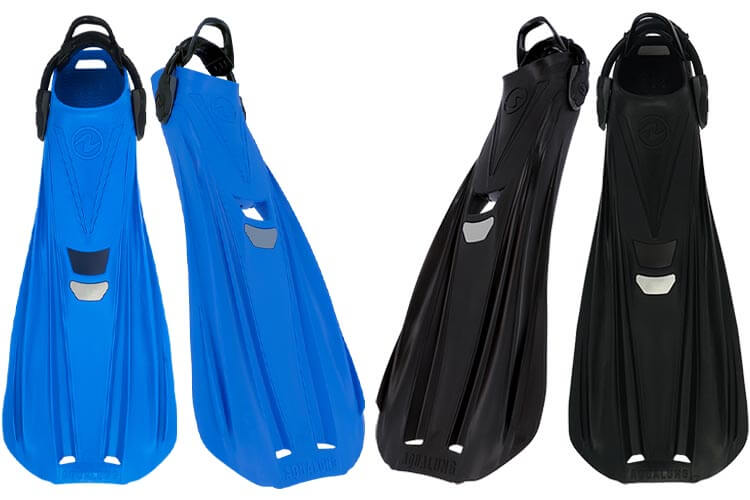
Aqualung’s Storm Max are long fins made from a single material Monprene construction for durability and strength, with an automatically adjusting bungee strap for ease of donning and doffing. Each size has its own colour coding to help distinguish it from other divers’ fins. Aqualung also produces the Storm fin (not pictured), priced between £60-£81, a similar single-material fin which is smaller and lighter in weight but not suitable for use with boots. Travelling divers who enjoy full-foot style fins may like the Storm’s ‘barefoot open heel’ design, but those who dive with boots should go for the Storm Max.
Sizes S, M, L Colours Black, orange, white, blue and brick (red)
www.aqualung.com
Check them out on amazon, atomic aquatics bladefin £199.95.

Atomic’s ‘Power-Loop Monocoque’ means that the top part of the foot pocket is actually part of a single structure which includes the frame rails running the length of each side of the blade. The lower half of the pocket – or ‘Power Plate’ – connected underneath, gives divers what Atomic describes as the feeling that the fin is ‘bolted’ to the foot. Vertical stabilizers on the fin tips keep the blade tracking in the right direction during kicking. The strap and side-clipped buckles rotate 180 degrees and are of the standard ‘pull to adjust’ design.
Sizes S, M, L Colours Blue, yellow, silver, red, pink, purple
www.atomicaquatics.com
Mares avanti superchannel £92.

The Mares Avanti series has some of the most recognisable fins on the market, and there is little to fault them. The various channel designs allow for controlled deformation of the otherwise fairly rigid blade, allowing a higher volume of water to be displaced with every thrust. They will work in pretty much all conditions, and function across all kicking styles. The Superchannel is slightly more compact and a little lighter than the popular Avanti Quattro +, but comes in at a budget price. No-nonsense, rugged and multi-purpose, the Superchannel comes with a rubberised bungee heel strap as standard (ABS buckle versions are still available).
Sizes S, R, XL Colours Blue, yellow, black
www.mares.com
Northern diver power fins £22.

Northern Diver’s Power Fins are a classic twin-bladed design with a soft inner section allowing for independent movement of each blade, generating powerful thrust while remaining highly manoeuvrable. The fins come with an adjustable strap and have proven popular amongst travellers with the pair of L/XL sized fins weighing in at 2.8kg
Sizes S/M, M/L, L/XL, XXL Colours Blue, yellow, silver
www.ndiver.com
Scubapro go sport £129.
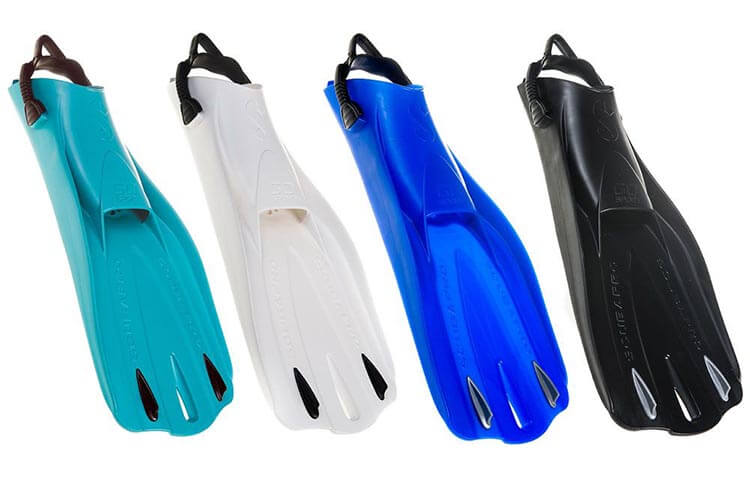
Scubapro’s GO series of kit is aimed at the entry-level travelling diver – lightweight, robust and at the lower end of the price point scale. The Go fins come in three different styles: Go, Go Sport and Go Sport Gorilla. The Go (RRP £74) is, essentially, an evolution of the full-foot-fin with an elasticated bungee but not suitable for booted feet. The Go Sport fulfils this need, with a foot pocket and self-adjusting bungee, plus the blade has been modified for the attachment of ‘skegs’ which sit perpendicular to the fin to minimise sideslip, all weighing ad just over 1kg. The new Go Sport Gorilla (RRP £140) is made with a stiffer blade and heavy-duty bunggee but comes at a higher price and larger weight penalty of more than 4kgs.
Sizes S/M, M/L, L/XL Colours Black, white, blue, green, yellow, pink
www.scubapro.com
Seac propulsion s £53.99.
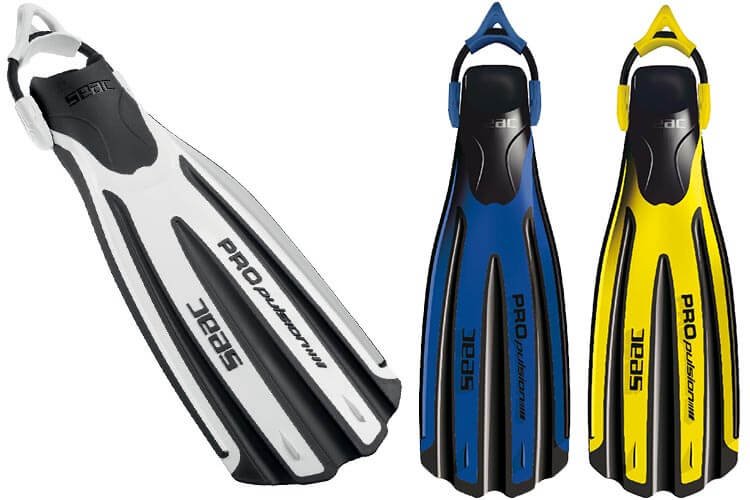
The Propulsion S is the evolution of Seac’s popular propulsion, with ‘S’ standing for sling-strap over the traditional buckle style of fin. The Propulsion S is a dual-compound fin with an integrated rigid frame, semi-rigid blade and soft-rubber channel inserts that allows for increased water displacement, with relatively wide side-rails to prevent water spilling off the edge of the blade, which is longer than most other paddle fins, at 68cm in the large size.
Sizes S/M (37-39), M/L (40-42), L/XL (43-45) Colours white, blue, yellow, black
www.seacsub.com
Tusa imprex duo £75.
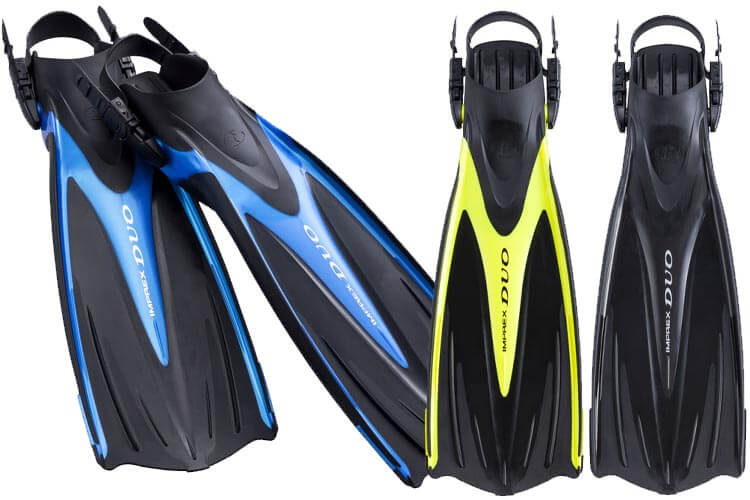
Tusa’s Imprex Duo features the Italian marque’s patented 20-degree angled blade design and multi-compound foot pocket, packaged in a dual-material design with reinforced side rails for increased stability. TUSA’s ‘EZ Strap and Buckle System’ is a fairly standard pinch-clip design which allows the straps to be tightened or loosened while being worn, for easy adjustment and removal.
Sizes S, M, L Colours Black, blue, yellow
www.tusa.com

These are fins that have more advanced technical features, often with holes, splits and channels which change the hydrodynamic capability of the fins. They may offer extra thrust, lighter weight or ease of use, but may not be suited to all divers in all circumstances, and are suited to divers with a little more experience underwater, who understand in greater depth how their fins affect their diving. Most of them also look pretty funky.
Aqualung Phazer £119-144

The Aqualung Phazer builds on a host of Aqualung technologies, including its ‘Wave Rib’ tech which uses a new design of side ribs which ‘load’ the energy of every kick to create a powerful kick suitable for beginners and experts alike. The blade uses a tri-material construction for flexibility and stiffness where each is needed, and a new ‘Hydro Power Channel’ helps water flow through the blade, increasing efficiency and stability. The Phazer is equipped with a new bungee strap design and heel pad for quick and easy donning and doffing.
Sizes S, M, L, XL Colours Black, red, hot lime, petrol/black, white/blue, white/pink
www.aqualung.com
Hollis f2 £115.
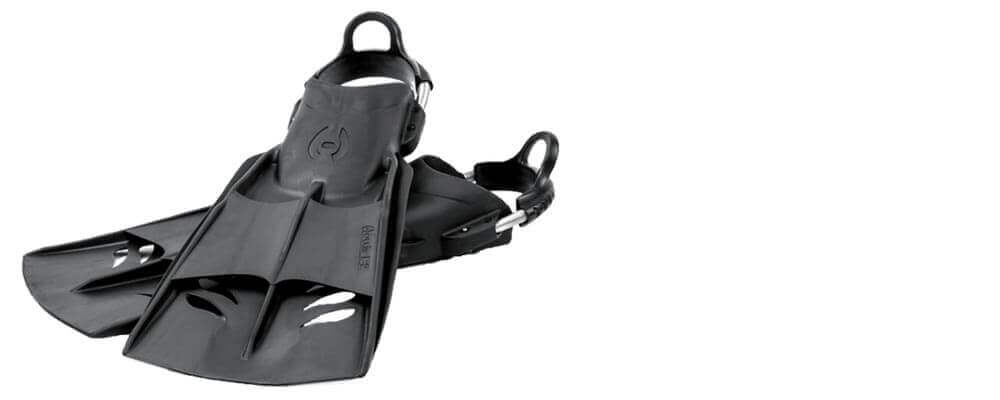
Hollis is primarily a technical diving manufacturer but the unusual design of the F2 is targeted at all divers, of any level. The fin is injection-moulded monprene, with a short blade for ease of packing and use in tight spaces. The vented blade reduces some of the strain of finning and is designed to accommodate all kicking styles. The steel-spring straps have angled mounts for comfort and have multiple mounting points to ensure the wide foot pockets are a good fit for different styles of boot.
Sizes S, R, L Colour Black
www.hollis.com
Mares x-stream £179.
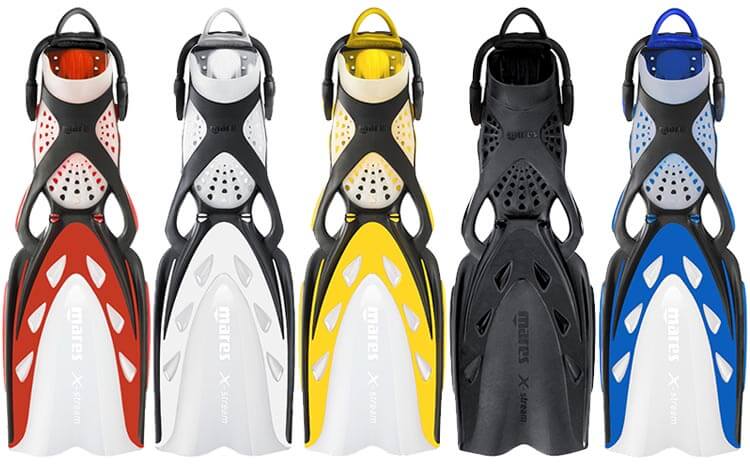
The latest evolution of the Mares X-Stream fins retains the use of its Channel Thrust and Optimized Pivoting Blade (OPB) technologies. First seen on the older Volo Power model fins, the X-Stream’s blade flexes close to the foot pocket, but with a more enhanced pivot point, designed to provide the wearer with maximum thrust but minimal leg fatigue. The fins are made from three different materials for high elasticity, durability and resistance to wear. The foot pocket is perforated to reduce drag from the ‘parachute effect’, and the straps and buckles of the original X-Stream have been replaced with bungees.
Sizes XS, S, R, XL Colours Blue, pink, red, black, white, yellow
www.mares.com
Northern diver coda dual v2 £137.
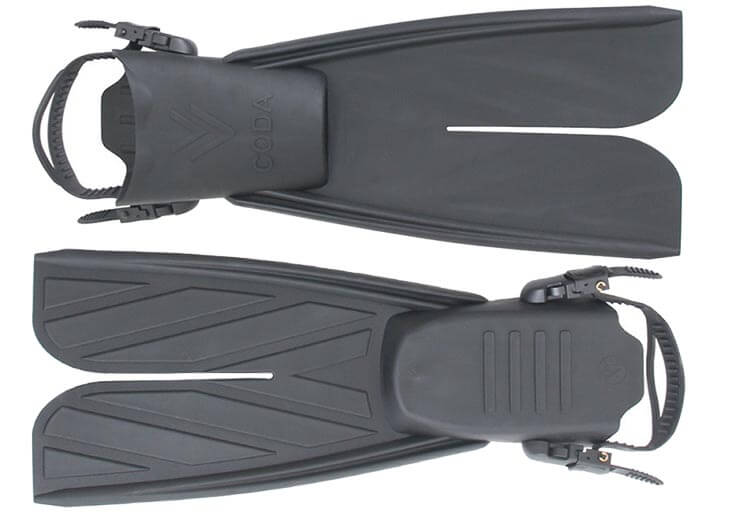
Northern Diver’s Coda Dual V2 fins are designed to deliver high power with less effort – a balance between lightweight, soft, short split fins and long, stiff blades making the V2 Coda an easy-kicking, high-thrust fin. Semi-rigid panels in the blade provide control over how it flexes during the kick cycle, creating a pair of ‘wings’ to provide thrust while reducing drag, with a high surface area for improved directional control. Constructed from heavy-duty thermoplastic vulcanizate, the fins are ideal for Miltary use, yet weigh in at just 2.6kg for a pair.
Sizes M, L, XL Colours Black
Scubapro Seawing Supernova £145
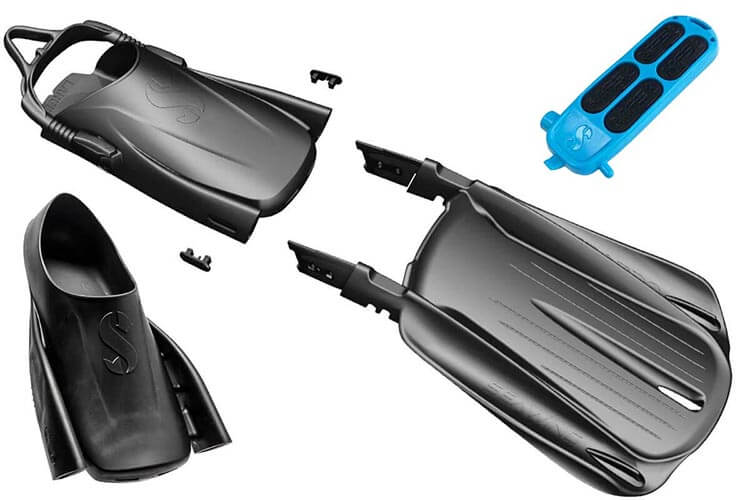
Scubapro’s Seawing Supernova is an evolution of its popular, award-winning Seawing Nova, awards. It is designed to maximize the thrust of a paddle fin with the ease of use of a split fin. The Nova has an articulated joint around which the blade pivots, and the extra-wide trailing edge adds extra propulsion, while ridges and winglets on the blade channel water in the right direction. It can be used with all styles of kicking, including reverse, and is suitable for the technical as well as the recreational market. The single-material, monoprene construction has been tested to one million kicks with no material fatigue. Grip pads on the heels reduce slip and bungee straps are standard. A stiffer ‘Gorilla’ version is available.
Sizes XS, S, M, L, XL Colours Black, white, yellow, blue, pink, purple
www.scubapro.com
Tusa solla £89.50.

Tusa’s Solla uses the same patented 20-degree angled blade design as its Imprex Duo. The Solla has a three-channel blade with a crescent tip to help maximise propulsion, with reinforced side rails and vents along the blade to fine-tune its performance. The foot pocket and blade use Tusa’s proprietary ‘Forcelast’ compound to make the most efficient transfer of energy while kicking, and is secured to the diver using Tusa’s patented ‘EZ-Lock’ strap and buckle system.
Sizes XS, S, M, L/XL Colours Black, Cobalt Blue, Fishtail Blue, Flash Yellow, Hot Pink, Metallic Red, Pearlescent Pink/White, Light Blue/White, Ocean Green, Rose Pink
www.tusa.com

These are fins that are geared towards the technical diving market, which has more stringent demands for fin performance than recreational diving. The material and design may be stiffer, heavier and shorter, so that they can be used in all environments, with all equipment configurations, and with the thickest of exposure suits. This does not mean the fins are only for tech, and many recreational divers enjoy using these fins.
Apeks RK3/RK3HD £162
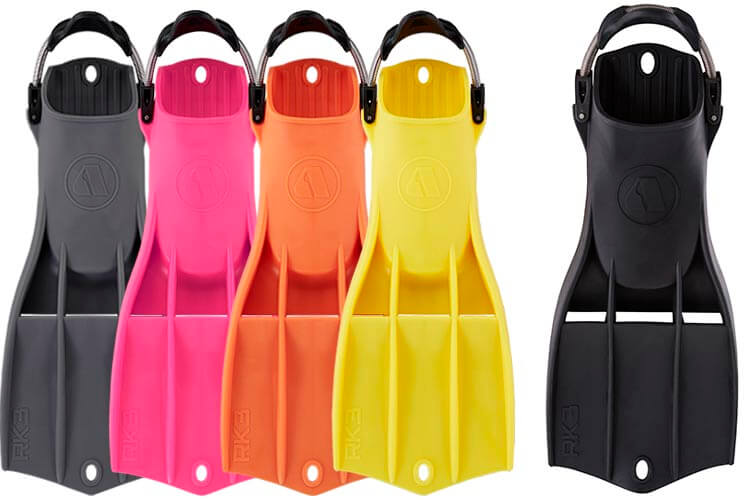
Designed with and used by the US military and coastguard, the Apeks RK3 is a rugged thermoplastic rubber fin featuring an oversized foot pocket to accommodate drysuit boots, with a spring strap for ease of use. The blades are short, wide and heavy, but vented to reduce resistance, and have grommet holes at either end to fit clips and carabiners to aid carrying them. The HD version is constructed froma higher-density rubber for extra negative buoyancy. The RK3 weighs 1.19kg per fin (in the large size) and comes in a range of colours; the RK3 HD weighs in at 1.4kg, and is available in black, orange or dark grey. Voluminous foot pockets will accommodate all types of boot, but try them out with your own boots before you buy.
Sizes S, M, L, XL Colours Black, white, dark grey, orange, yellow, ping (RK3) /black, orange, dark grey (RK3 HD)
www.apeksdiving.com
Check them out on amazon (rk3), check them out on amazon (rk3 hd), atomic aquatics x1 bladefin £149.

Following a similar internal design to the BladeFin, the X1 is shorter and stiffer with rigid, lower-profile side rails to reduce sideways drag, and has been specifically designed to cover all kicking styles – including frog, scissor, helicopter and back-finning – aimed at increasing manoeuvrability in tight spaces, and the overall utility required by technical divers. The foot pocket is taller and roomier to accommodate drysuit boots, and similar vertical stabilizers to the recreationally-oriented BladeFin keep the fin tracking straight. The Atomic EZ-LOK buckle system comes as standard; optional spring straps are also available.
Sizes S, M, L, XL Colours Blue, black, red, yellow, silver
Hollis F1/ F1 LT £165.95

Constructed from high-grade, heavy-duty rubber, the F1 – aka the ‘Bat Fin’ – is demonstrative of Hollis’s commitment to the technical diving market. The generous foot pockets with multiple angled mounts for the steel spring strap cater for all sizes of boot, although they are some of the heaviest fins on the market. The F1 LT is lighter and shorter, specifically engineered for tight, confined dives, and comes in three different colour schemes, as opposed to the F1’s singular black.
Sizes One size Colours Black (F1); white, yellow, grey (F1 LT)
www.hollis.com
Check them out on amazon (f1), check them out on amazon (f1 lt), mares power plana £192.
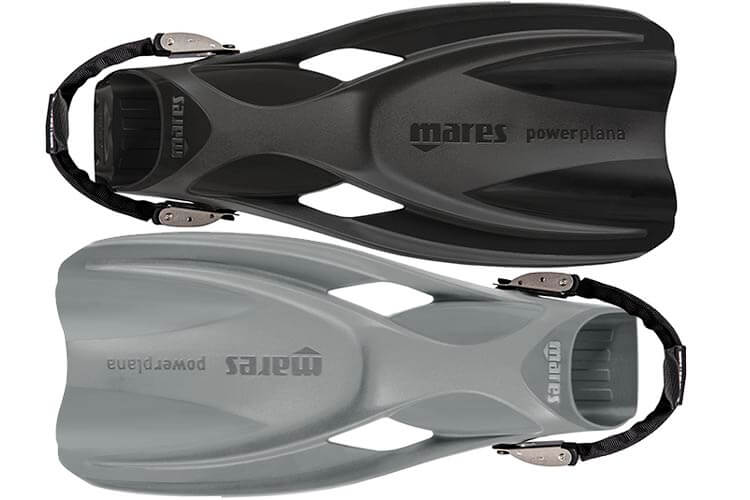
Negatively buoyant and designed from natural rubber, Mares’ heavy-duty tech fin is suitable for all divers, especially those wearing thick exposure suits and drysuits. The broad blade and large sidebars, combined with a length of only 55cm make this a compact, sturdy fin which will suit all kicking styles – and especially frog kicking. The large vents at the base of the blade help to reduce stress on the ankles and calf muscles, and the full-foot pocket with bungee strap will accommodate most types of boot, although the bungee strap is not adjustable, and may need swapping depending on which size boot is being worn.
Sizes S, R, XL, XXL Colours Black. grey
Northern Diver Jet Fin £55
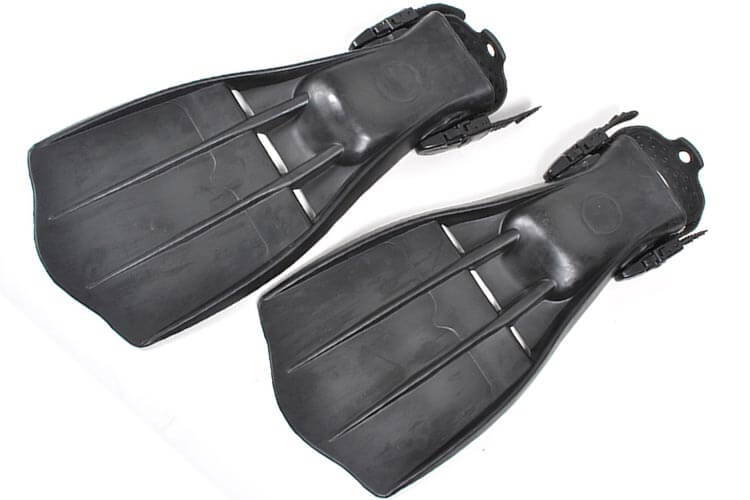
Northern Diver’s Jet Fins are made from high-quality rubber, originally designed for the military and commercial diving sectors, where they have been extensively tested in some of the most extreme diving conditions. The Jet Fins are equally suited to wreck, cave and technical diving where shorter fins are preferred, and are available with a clamp style metal buckle or quick-release Fastex strap (subject to availability)
Sizes M, L, XL, XXL, XXXL Colours Black. grey
Scubapro Jet Camo £215

Scubapro’s Jet Fin was first introduced more than 50 years ago; its distinctive design now recognisable the world over. The rubber construction is renowned for its durability, and the vents reduce drag on the upstroke and provide more thrust on the downstroke. Among the favourites of technical, military and commercial divers, Scubapro’s Jet Fins are available in the classic black, or the latest white, green and blue camo versions, with steel spring straps as standard.
Sizes M, L, XL, XXL Colours Black, white/grey, green/blue, blue/white camo
X-Deep EX-1 £125
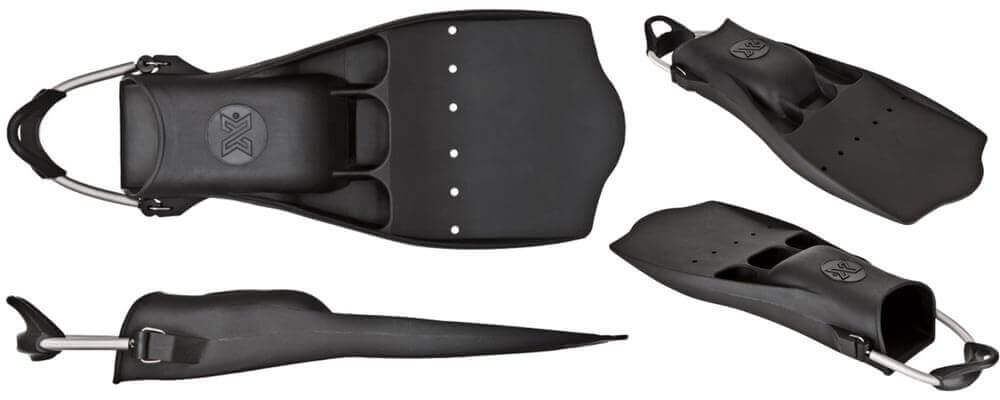
Tech specialist X-Deep has evolved the traditional vented jet fin design, utilising an advanced polymer instead of rubber which means the EX-1 is not as affected by temperature. X-Deep makes the fin available in hard, medium and soft compounds. The hard is for dedicated technical divers, while recreational divers may prefer the softer compound as they master their finning technique. A neutrally buoyant version will be available for 2018. Foot pockets have been moulded around a variety of boots with a slightly softer compound around the opening to increase feel. Steel spring straps are standard.
Sizes L, XL Colours Black
www.xdeep.eu

The advice that’s often given to people buying diving equipment is ‘buy the best that you can afford’, which may be the case for gear such as regulators and exposure suits, but is less true of fins. A high-end regulator will work everywhere, but an expensive set of fins, for reasons of experience and diving environment, may not always be the best choice.
If you are a novice looking to make your first purchase, stick with what you know, and consider that the general-purpose type of fins used as rental gear by most dive centres are basic, inexpensive, hard-wearing, and suitable for all – which is why the dive shops use them. They may not be perfect, but if you’re not sure where to begin looking, they are a great place to start.
Personal physique, prior injury or age may affect your choice: harder, stiffer and heavier fins may be more powerful, but can be hard on the ankles and calf muscles; others are designed to reduce the effort involved in their use, but there may be a trade-off in terms of a reduction in power. Some claim to make the best of both worlds.
Most fins will cater to the basic up-and-down flutter kick, but some of the more ‘advanced’ designs may not be so great for frog-kicking and even less so for back-finning. You will only ever really know by trying, so if you have the chance to dive in a set of finis before parting with your money, go for it.
Open-heel of full-foot?
We have only included open-heel fins for use with boots in this article, as most dive professionals would recommend this setup to give you the broadest range of dive possibilities. Traipsing barefoot over hot sand, rocks, broken glass, stinging hydroids and sea urchins is no fun at all, and the waters around even the warmest of tropical islands can be decidedly chilly at times. Boots protect you from the physical environment and offer thermal protection that full-foot fins cannot.
Sizing guides vary between manufacturers. Some will label their products as S, M, L, others as S/M, M/L, L/XL, some have Small, Regular and Large. It depends on your personal shoe size, naturally, but also on the size of the boots you are wearing. As a rough guide, you can expect the following sizes to be relevant, in this table based on a 5mm boot. Buy online if you’re sure you know what you need, but there is no substitute for a proper fitting at a dive shop.

- Latest Posts

- Diving ‘Wreck Week’ in the British Virgin Islands - 15 May 2024
- Shearwater Research announces new Peregrine TX - 14 May 2024
- Mexico’s deepest blue hole is found to be record-breakingly deeper - 13 May 2024
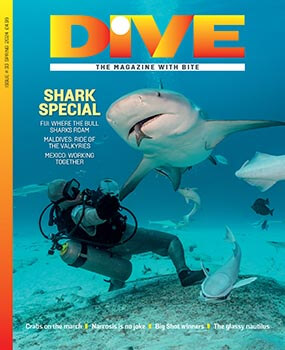
FOLLOW DIVE
Want to access DIVE on your tablet or smartphone? Press the Apple, Android or PC/Mac image below to download the app for your device

More from DIVE
- Advertise with DIVE Magazine
- Terms & Conditions
- Privacy Policy
- Privacy Policy

6 Best Scuba Fins For Travel In 2023

Reviewed By Travis Turgeon / Scuba Editor
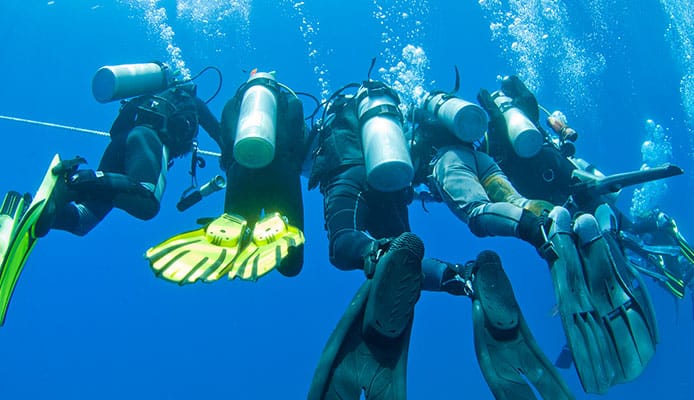
OUR TOP PICK
Mares AvantiQuattro Plus Scuba Travel Fins
Editors choice.
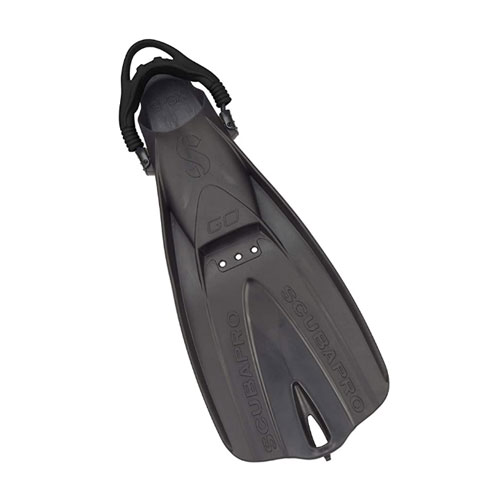
Scubapro Go Travel Fins
Cressi Pro Light Scuba Travel Fins
The top 6 scuba fins for travel in 2023.
- 1. Mares AvantiQuattro Plus Scuba Travel Fins
- 2. Scubapro Go Travel Fins
- 3. Cressi Pro Light Scuba Travel Fins
- 4. Mares Volo Race Scuba Travel Fins
- 5. Aqua Lung HotShot Scuba Travel Fins
- 6. Hollis F-2 Scuba Travel Fin
Are you excited to plan a trip to scuba dive along a beautiful coral reef but concerned about the bulk of your luggage? Fear not, because we have compiled a list of the best travel scuba fins on the market. This will allow you to save precious space for all your other gear and leave with a light heart and lighter baggage.
Nobody will ever recommend diving without fins. Furthermore, you have to be sure that the ones you are bringing along fit you perfectly, something you can never really know with rentals. It is, therefore, crucial to find a top-rated pair of travel fins that can cozily fit in your travel bag along with all the other gear you need. Follow us as we take a look at the best options available today.
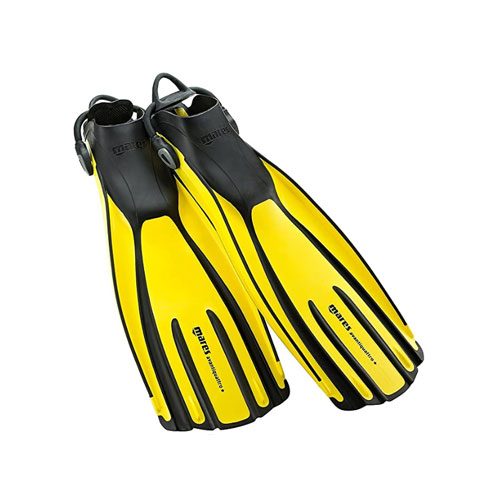
The Mares Avanti Quattro Plus p all the thrusting power and responsiveness of the best scuba fins without taking up as much of the space and bulk. They are a new restyled version of an already excellent model. Closed at the rear with a very convenient bungee strap. The Avanti Quattro Plus travel scuba fins build on the success of their predecessor adding new composite materials for improved efficiency and features four channels for greater thrusting power.
The foot pocket is anatomically shaped to improve power transmission and the fins feature a stabilizer to better direct the motion and avoid ankle twists. A high-flex material provides an excellent response for a standard scissor kick and good performance for a flutter or frog kick. These fins will feel right at home in open water and do almost everything right.
- Stand Out Features - Why We Love It
- Improved version of an already good model
- High-flex material
- Bungee strap closure
Blade: 15 inches Weight (perfin): 2 pounds

Made out of a solid block of moldable Monprene, the Scubapro Go Travel fins are top-rated travel scuba fins that comply with the International Air Transport Association carry-on details. Durable and ready for heavy use, the two blades can be interlocked for ease of packing and transport.
While an open heel design, the foot pocket is soft and suitable for barefoot divers, those who wear neo socks as well as those wearing traditional booties. The heel strap is a bungee that is almost indestructible. Power bars on the underside help to avoid over-flex and make sure that every ounce of power is used to the maximum. The Scubapro Go travel features a 25-degree angled blade and a central power panel for rigidity. This creates a channeling effect to further increase thrust, making these fins a great balance between power and maneuverability. This model is based on the Scubapro Go Sport Fin, While the travel fin has slightly less power, few divers will notice the difference.
- Interlocking fins for ease of transport
- Central power panel for rigidity
- Underside power bars to prevent over-flex
Sizes: XS to XL Weight (per pair): 2.2-2.6 pounds
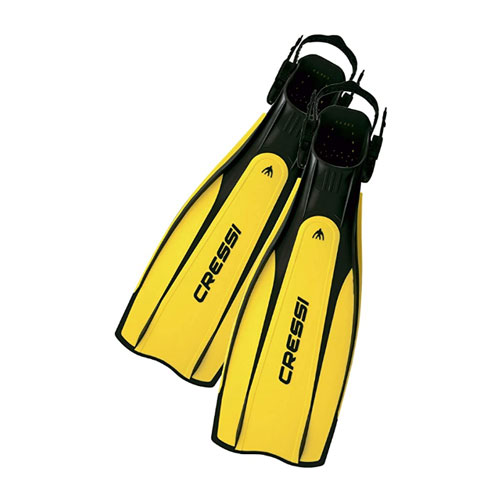
Beginners and professionals alike will find in the Cressi Pro Light one of the best pairs of travel dive fins on the market. Light and reactive polypropylene makes up the blade while a comfortable rubber is used for the foot, and the blade begins already above the foot pocket providing a substantial increase in surface area when compared to other models.
The foothold is anatomically designed, thanks to the latest computer technologies, and built for optimal transmission of thrust between the leg and the fin. The whole motion is stabilized thanks to two flaps at the end of the blade, efficiently directing the fin while kicking. The Cress Pro Light are fins that seem to come from the future and are some of the best scuba fins for travel you can buy.
- Increased fin surface area
- High-tech material mix
- Stabilizing flaps
Blade: 12.3-14.8 inches Weight (perfin): 1.48-3.74 pounds
Mares Volo Race Scuba Travel Fins
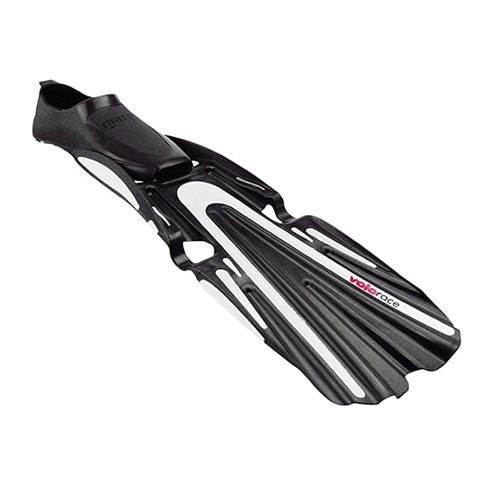
The Mares Volo Race fins are a great piece of kit to add to your travel scuba gear thanks to its smaller blade that makes it ideal for transportation. This does not prevent it from delivering excellent propulsion with minimal exertion, thanks to an ingenious design that unites an OPB-Optimized Pivoting Blade, with channel thrust.
The combination of these technologies make the one of the best scuba fins for travel you can buy. The anatomical foot pocket, on top of everything, helps with an extremely smooth kicking motion that will let you slide through the water with ease, with a rubber stabilizer minimizing twists and turns.
- Optimized Pivoting Blades
- Channel thrust technology
- Anatomical foot pocket
Blade: 14.6 inches (size 42/43) Weight (perfin): 1.5 pounds (size 42/43)
Aqua Lung HotShot Scuba Travel Fins
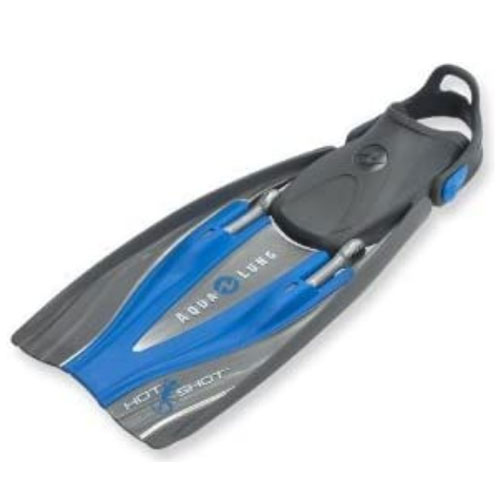
The unique design of the Aqua Lung HotShot scuba travel fins allows you to dial the power band resistance that you prefer, effectively providing two different speed gears. Adjustments can be made even while wearing the fins and the power boost you’ll receive on the upstroke will let you glide through the water with ease.
The Aqua Lung HotShot fins are also lightweight and easy to transport making them ideal for travel while the foot pocket is comfortable and efficient, providing an excellent perception of your foot’s movement in the water. The anti-slip bottom keeps you safe even aboard a boat and pure silicone slings make fastening them a breeze. Overall, surely one of the best travel scuba fins on the market today.
- Adjustable power bands
- Anti-slip bottom
- Lightweight and easy to pack
Length: 20.9 inches Weight (per pair): 3.28 pounds
Hollis F-2 Scuba Travel Fin
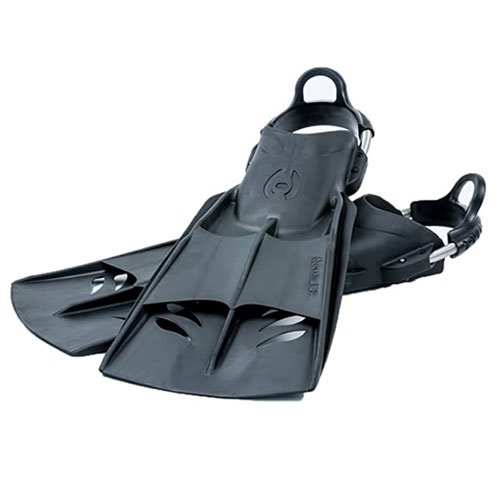
A shorter blade lets you pack easily with the Hollis F-2 scuba fins, but this does not compromise power. The design adds blade surface both on the upstroke and downstroke so each one of your kicks can achieve maximum thrust. Also useful is a vented blade design, made to reduce water resistance. The build of these scuba diving fins for travel is pure monprene.
The foothold can accommodate various types of diving footwear and the heel is secured in place with an adjustable stainless-steel spring strap. The fit is adaptable to all foot sizes thanks to multiple strap mounting positions, and the straps adapt to the depth you’re swimming at for an ideal fit at all times.
- All monprene build
- Steel heel straps adjust to water pressure
- The design adds blade surface without compromising size
Sizes: S to XL (4 to 13) Weight (per pair): 2.2 to 4.18 pounds
- Travel fins are usually lightweight, keeping your feet positively buoyant in the water. Negatively buoyant fins can negatively affect your trim and dive position in the water.
- Longer fins are difficult to pack and travel with. Find some fins that give you enough power, but keep the blade as short as possible.
- Full foot fins provide you with the option to get your exact shoe size and give you a better fit. On the other hand, open heel fins will cover a broader range of foot sizes, giving you the option to dive barefoot, with socks, or with booties.
How To Choose Scuba Fins For Travel – Buying Guide
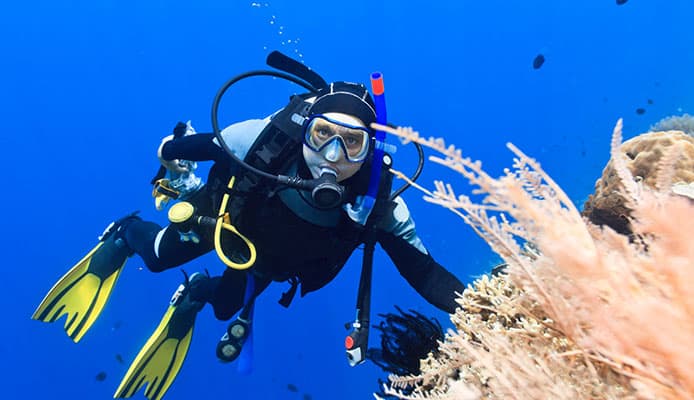
Once you’re in the water, the weight of the fin doesn’t influence your experience as much as other gear can, like the air tanks. However, the weight will matter greatly while you’re packing, since airport regulations are getting more stringent and convoluted every day. Luckily, most travel fins for scuba are designed with this in mind and do an excellent job in stuffing a lot of features in a lightweight package.
Most scuba diving fins are open-heel, so there is a little more leeway in getting the correct size. Still, you need to get as close as possible, and a fit that is not too small. When selecting an open heel fin take into consideration the booties you will wear. Most manufacturers take 3 mm booties into consideration when sizing their fin sizes. If you frequently wear a thicker size you might want to consider that. Be sure to try them on before you set out on your trip to get a good idea of the fit, and return them in case you realize that they don’t work for you. A good fitting fin should not squeeze your foot while also being easy to slide on and off.
Users looking for the best travel scuba fins should know that they won’t be the cheapest model you can find. As will all the rest of the diving gear , fins can be purchased basically for life, so it’s worth putting a bit more money on the table for them. Most manufacturers place special care in the build quality of their products and the price is justified in that sense, so be prepared to face a small investment but know that it will be one that will pay dividends for years and years to come.
You might also like: Best BCDs For Beginners
As you have seen in our scuba fins for travel reviews, this piece of gear comes in various shapes and sizes to adapt to different needs. There is also a variety of different fin types available, as is the case, for example, for snorkeling fins. These differ from diving fins since they are shorter and lighter and not designed to face the conditions one might encounter at deeper depths. As for diving fins, most are the open heel version. These are designed to be used with diving booties, Thicker sizes of booties can also keep the foot warm. Fins can also be divided into paddle or split fins. A paddle fin is a solid piece of material without openings, that will provide excellent thrust but require more energy to be moved. A split fin will have an opening along the blade that makes it more lightweight and flexible and thus easier to maneuver and require less force to use, with most of the thrust being delivered by the speed of the kick rather than the strength,
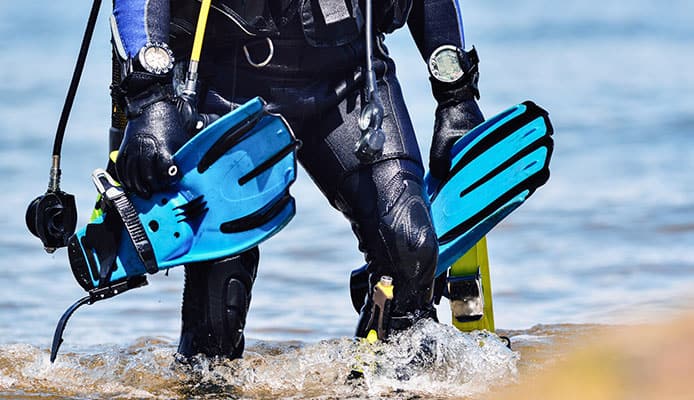
Q: What Is The Difference Between Regular And Travel Scuba Fins?
Regular scuba fins are usually longer and tougher than travel scuba fins. This is because they are designed for maximum power underwater, letting you get the most out of every single kick. The best scuba fins for travel, however, can achieve very similar results all while being smaller, easier to carry, and more flexible. You will need to work a little bit harder to make up for the difference in size but the reduced weight can be a money saver if you move around a lot.
Q: Why Do I Have To Own A Pair Of Fins?
You will see many answers to this question focusing on anything from fit to blade types and many other factors. Once you find a design that fits your needs, The biggest reason for purchasing your own is muscle memory. Fins are an extension of your legs and feet. When you are using the same fins, your body will find the best ways of using them. Changing fin styles on each dive will not allow you to improve.
Globo Surf Overview
Passionate scuba divers always battle with the size and bulk of their gear. Luckily, there are different options for travel scuba fins which are all excellent in their way. We hope our reviews have cleared up your mind so you can quickly find the model that is good for you and start enjoying your dive.
More Scuba Reviews:
- Dive Camera
- Bcd For Beginners
- Dive Watches Under 200
- Womens Wetsuits
- Dive Compass
More Fins Reviews:
- Monofins For Swimming
- Snorkeling Fins
- Bodyboard Fins
6 Best Scuba Fins in 2023 (Review)
Last Updated: January 26, 2023 | Written By: Matt Fitzgerald
ReadyDive may earn a small commission from affiliate links in this article. Learn more
Table of Contents
Fins are one of the most crucial pieces of equipment when it comes to optimising the diving experience. For the experienced diver, fins quickly become the first object of attachment. I know myself that I would almost rather not dive if I could not do so with my favourite pair of fins. Good fins provide the diver with a range of benefits and are paramount in making the dive experience both as comfortable and as safe as possible. Hopefully, by reading our article, you can pick the best scuba diving fin based on your personal needs as a diver, as well as what type of fin you want from our product recommendations.
Best Scuba Fins Reviewed
#1 – apeks rk3 review (best all-rounder) .
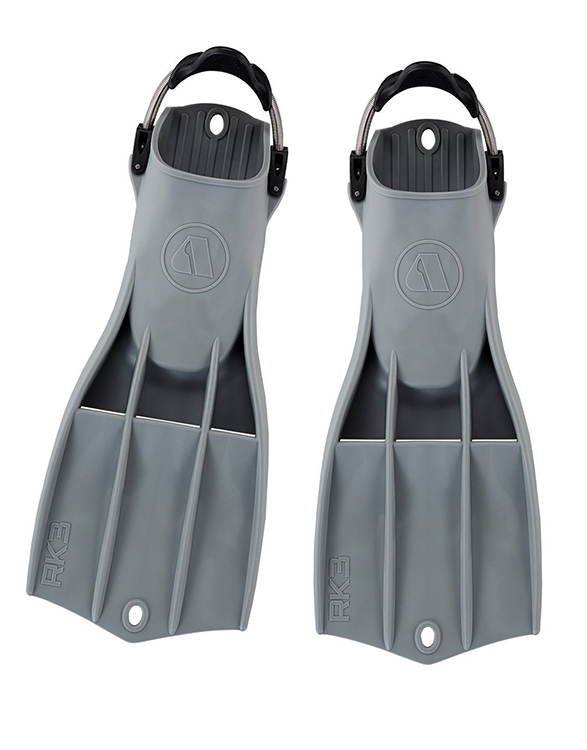
One of the most popular pairs of fins on the market, the Apeks RK3 fins are a perfect all-rounder, for all types of diving and divers. They are made of a very tough thermoplastic, and are positively buoyant. Their inherent buoyancy is a great benefit for many wetsuit divers, as it brings the legs into a well-trimmed position without the diver having to consciously do so with lower back tensing. Equally, for drysuit divers wanting a heavier fin, Apeks released an updated version called the Apeks RK3 HD fins, which are negatively buoyant. The vents on the blades make for less resistance on the up-stroke, similar to that of a split fin, but without the loss in power. They come in three sizes: medium, large and super, and are between 1.1-1.4kg per fin, size dependent. These make for a perfect set of fins, be it for the first time diver, or the experienced technical diver.
#2 – Mares Avanti Quattro Review (Best All-Rounder #2)
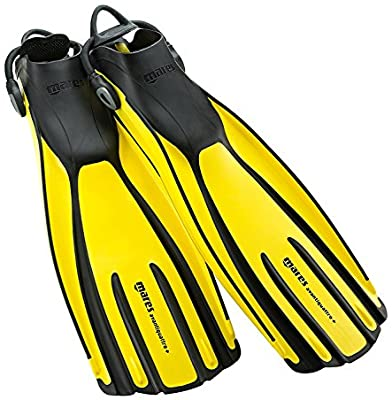
The Mares Avanti Quattro fin is held dearly to the hearts of many divers. They are again an all-rounder, as they possess the precision and power required by overhead and technical divers, whilst not being so stiff as to put off new, recreational divers. The only drawback is their length, as it slightly reduces control and is also a problem for the travelling, size conscious diver.
#3 – Scubapro Jet Scuba Fins Review (Best for Power and Control)
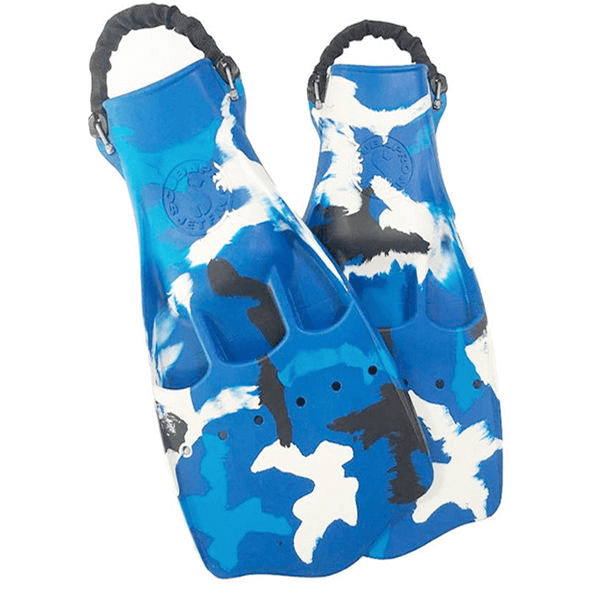
The Scubapro Jetfin is a classic scuba fin based on a very simple, original, and effective design. They are short and wide, with a very stiff blade, resulting in maximum power and maneuverability. They are extremely tough, and, in many cases, will last the diver their whole diving career. They are utilised by the most demanding divers, from North Sea saturation divers to military divers. They are negatively buoyant, making them the perfect fin for drysuit use. They also come in a range of colours and camouflage prints, making them very recognisable and personalised. They are available in sizes M, L, XL, 2XL, and 3XL. The only downside of these fins is their increased weight, which may pose a problem when travelling. However, many divers use and travel with these fins, regardless of their additional weight, due to their outstanding performance. The Scubapro Jetfin is the original jetfin that spawned all the others.
#4 – OMS Slipstream (Best for the Traveller)
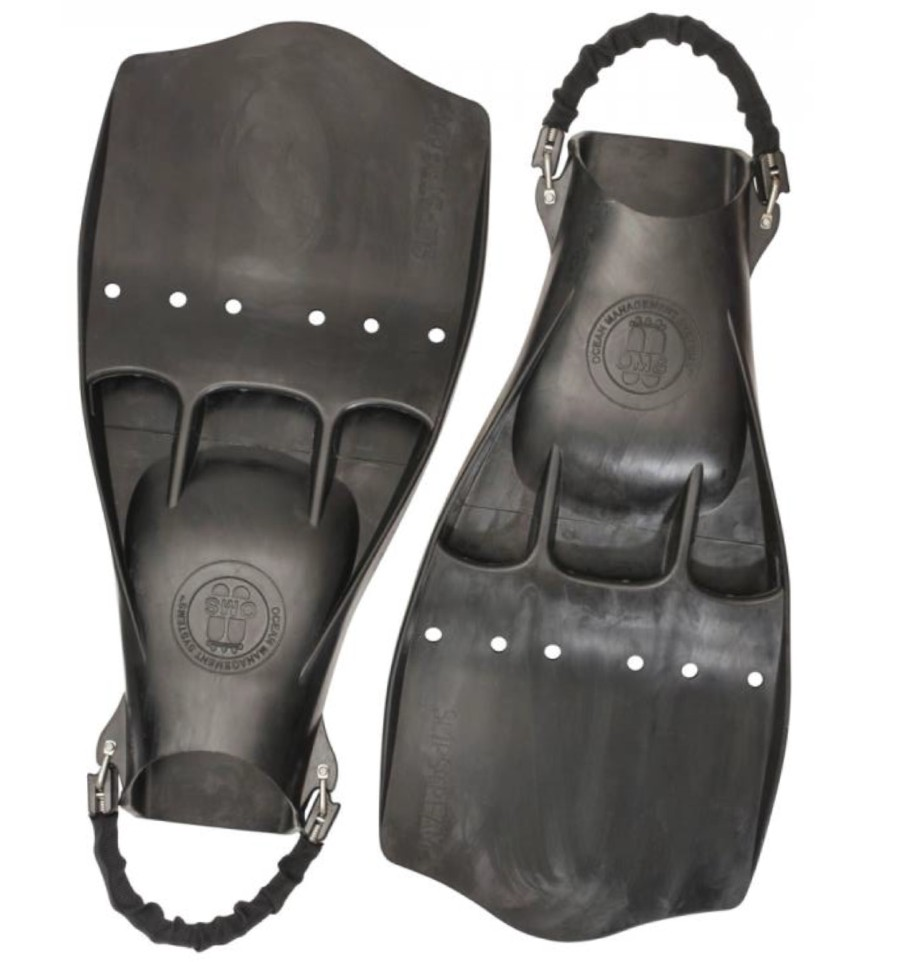
The OMS Slipstream’s are a fin modelled on the classic jetfin design, but are made from a lighter monoprene material. The result is that they are better for travelling, and are also neutrally buoyant, making them better for divers suffering from excess negative or positive buoyancy with their current set of fins. These are an excellent choice, and can be used in the most demanding of conditions. They are also a good choice for warm water sidemount divers who require a lighter fin with the same power and control of a traditional, heavier jetfin.
#5 – Scubapro Go Travel Fins (Best for the Cost-Effective Traveller)
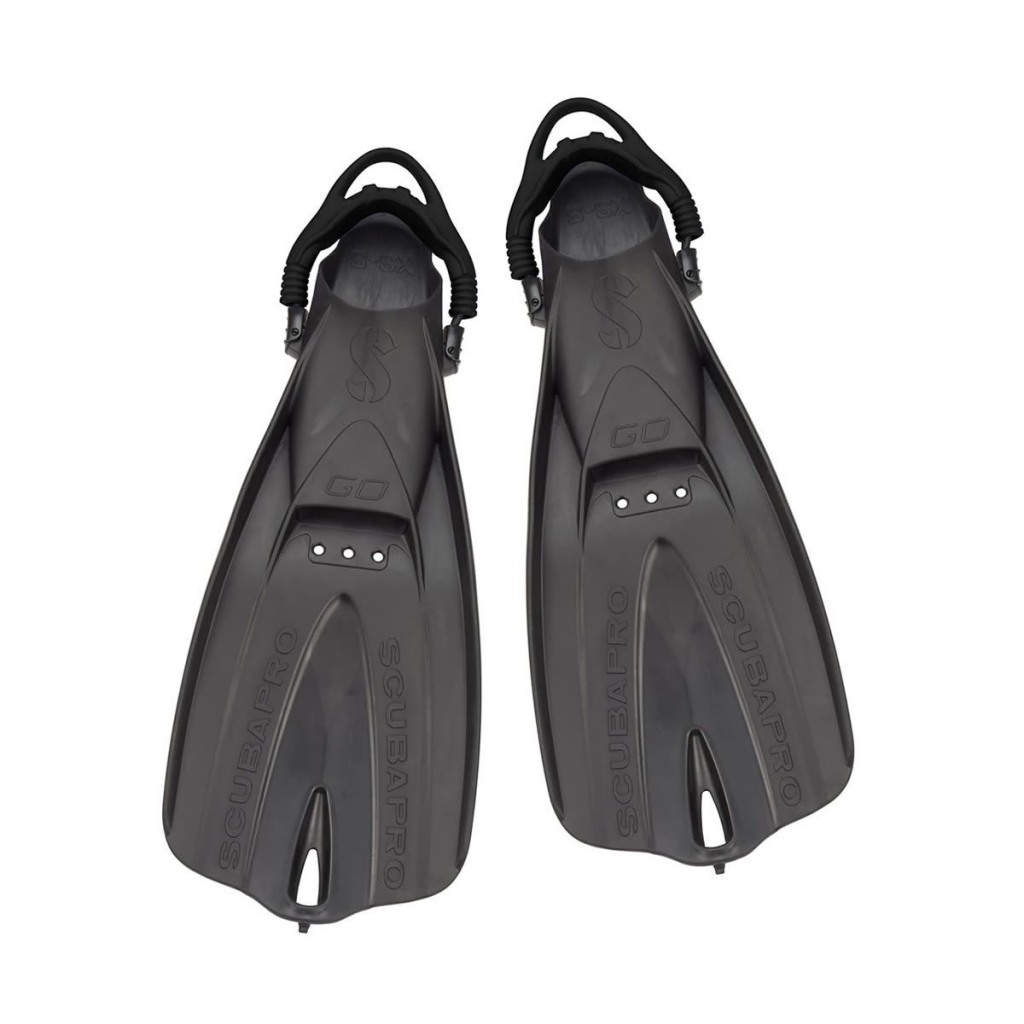
The Scubapro Go Travel fin is a fin designed for the traveller, and is also much more affordable than other pairs. Weighing in at a mere 0.6kg per fin, these are ideal for travelling. However, durability is not compromised, as they are made of 100% monoprene. They are also able to be worn barefoot if used for snorkelling too, but can also be worn with a neoprene sock or boot. The simple bungee strap, as with traditional jetfin designs, makes for extremely easy donning and doffing.
#6 – Atomic Aquatic Split Fin (Best for the Adaptive Diver)
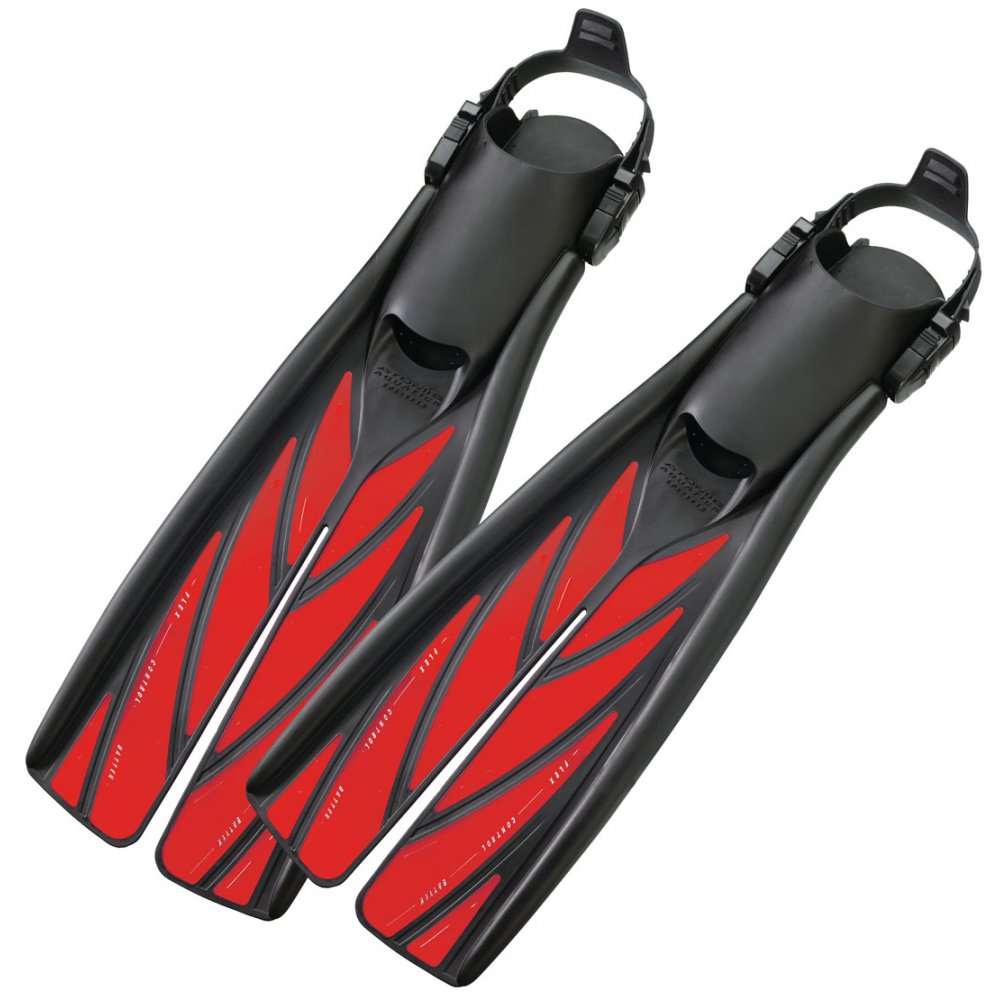
The Atomic Split scuba fin is an alternative option for divers who suffer from decreased leg strength and/or issues relating to mobility. The split fin design, whilst not optimum for power or fine motor control, makes for a very easy finning experience in calm conditions. Similarly, they are a good option for junior divers who require a fin that is less stiff and more flexible. However, for the diver wanting optimum power and finning control, split fins are not the fins to go for.
Picking The Best Scuba Diving Fin
The basics .
Unlike other pieces of dive equipment, fins are relatively simple. Factors to consider in terms of the construction of a fin are: blade length and width, closed heel versus open heel design, heel strap design, stiffness, and weight. There are two main designs of fins: paddle/jet fins and split fins.
Paddle/Jet Fins
The paddle design of scuba fins is the classic design that was originally used during the advent of diving. It utilises a short, wide, stiff blade, with a thick body, and is very durable. The shorter and wider a fin is, the more power and fine maneuverability it delivers. Therefore, paddle fins possess the greatest power and fine in-water control. These are the most ideal pair of fins to invest in for the majority of divers. The quintessential paddle fin design is that of the jet fin: this is a simple, effective construction that has barely changed since its initial birth.
The second type of fin design is the split-fin. The split fin blade is split in two, hence the name, making for reduced resistance, increased flexibility, and less stiffness. This is ideal for divers suffering problems of leg strength and/or issues relating to leg mobility. Split fins, however, sacrifice power and in-water control for flexibility and comfort. They are not the fins for those diving in currents, overhead environments or for technical divers. The use of split fins in any of these environments would pose a serious safety risk due to the lack of control and power they afford the diver. But, in calm conditions, performing normal recreational dives, they are a good option for those who struggle with the stiffness of a paddle fin.
Closed Heel vs Open Heel
Scuba diving fins also come with the option of having a closed heel versus an open heel. Closed heel designs, in almost all cases, are for fins designed for surface swimming and snorkelling, or freediving – even if they are marketed for scuba diving. The blade design is typically very weak (unless they are freediving fins), lacks precision and is generally unsuitable to the demands of scuba diving. Similarly, closed heel designs preclude the use of neoprene boots , therefore meaning they can only be used with bare feet – limiting the environments you can use them in. Open heel fins, on the other hand, can be used in all environments and are used by fins designed specifically for the demands of scuba diving. Therefore, you should always select a pair of fins utilising the open heel design.
Spring Bungee Straps vs Plastic Strap with Clips
In terms of the heel strap, there are two main designs: spring bungee straps versus a plastic strap with clips. Both designs work well. However, the single strap bungee design tends to be preferred by divers, as the donning and doffing process is made easier, and the strap itself does not require tightening: the bungee is naturally tight. Similarly, as the plastic strap has clips at both ends, it can easily be lost if both are unclipped in the water when doffing. Some divers actually have constructed their own bungee straps and replaced them with the plastic clip system on fins which don’t offer a bungee system.
The Importance of Good Fins
A pair of good scuba fins provides the diver with increased kicking efficiency. The key is in finding a fin that plays to your strengths. If you are a diver for whom the frog kick is your primary kick, then a paddle/jetfin style fin will be the best choice. Conversely, if leg strength and/or mobility is an issue, then a fin which is less stiff is a better choice, as comfort is of primary importance. With increased kicking efficiency comes less exertion. This means that the diver will require comparatively less oxygen and will therefore have a lower breathing rate, resulting in better overall gas consumption throughout the dive. Less exertion also means less chance for carbon dioxide (CO 2 ) retention. CO 2 is the by-product of respiration. Less exertion results in less respiration, and therefore less CO 2 build-up. Reduced CO 2 retention is a very important factor for safe diving as CO 2 becomes very narcotic at comparatively lower levels, and has also been shown to increase the likelihood of central nervous system oxygen toxicity.
Scuba Fins also play a vital role in determining in-water control. A good fin will respond to the subtleties of variation in ankle and foot motion; it should perform well in modified variations of the frog and flutter kick, as well as with the reverse kick and helicopter turns. Good in-water control ties in with the previous point, as it reduces exertion. It also decreases the likelihood that a diver will come into contact with corals or any other delicate part of the underwater environment, making for more sustainable diving. In-water control and precision is essential for more advanced types of diving, such as cave and wreck diving, as it is the difference between visibility or a silt-out. Similarly, in technical diving, in-water control is vital in order for decompression stop depth to be held consistently.
Fins and Trim
Often, scuba fins are talked about purely from the perspective of propulsion. However, scuba fins are not merely a means of propulsion; they are an integral part of whole-body trim. Fins themselves have different buoyancy characteristics; some are negative, some positive, others neutral. The diver is essentially a seesaw in the water. With this in mind, the buoyancy characteristics of a diver’s fins are going to have one of the greatest impacts on their trim, as the feet are the furthest away from the centre of the diver.
An intelligent thing to do before buying a new pair of scuba fins is to examine your trim position in the water. This can be done by performing a simple in-water trim check, as shown below. Whilst hovering, you want to extend both your arms and legs, so that your whole body is almost perfectly horizontal in the water column. Then, simply relax in this position, releasing bodily tension, and allow your body to move in the direction it naturally moves in.
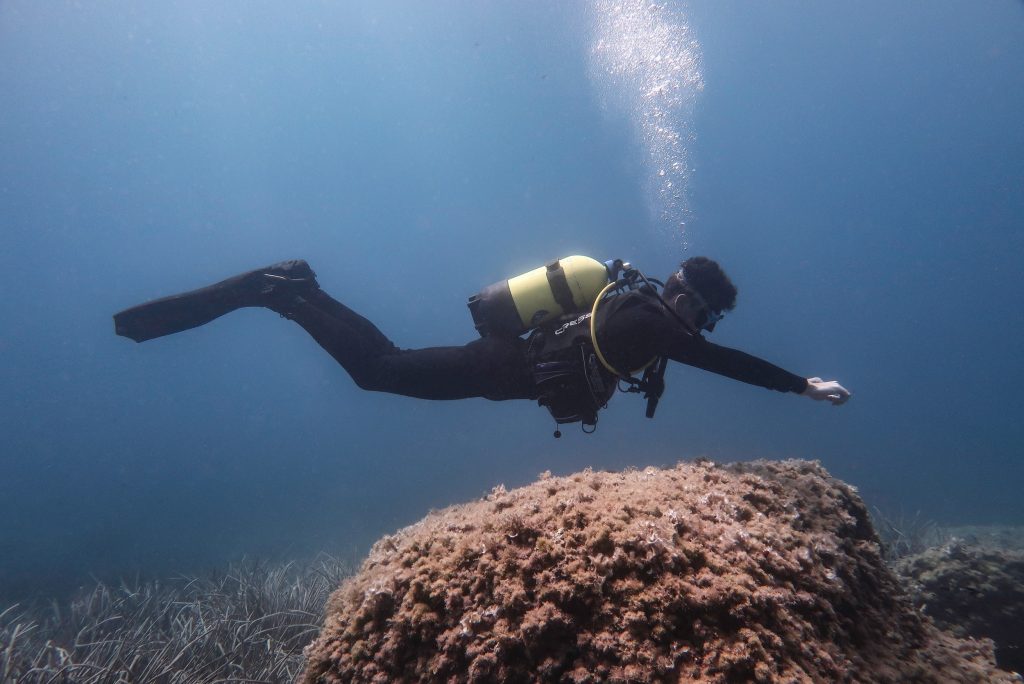
If your fins/legs are too light, your legs will gradually rise, becoming the highest point of your body, and putting you into a head-down position, as shown below.
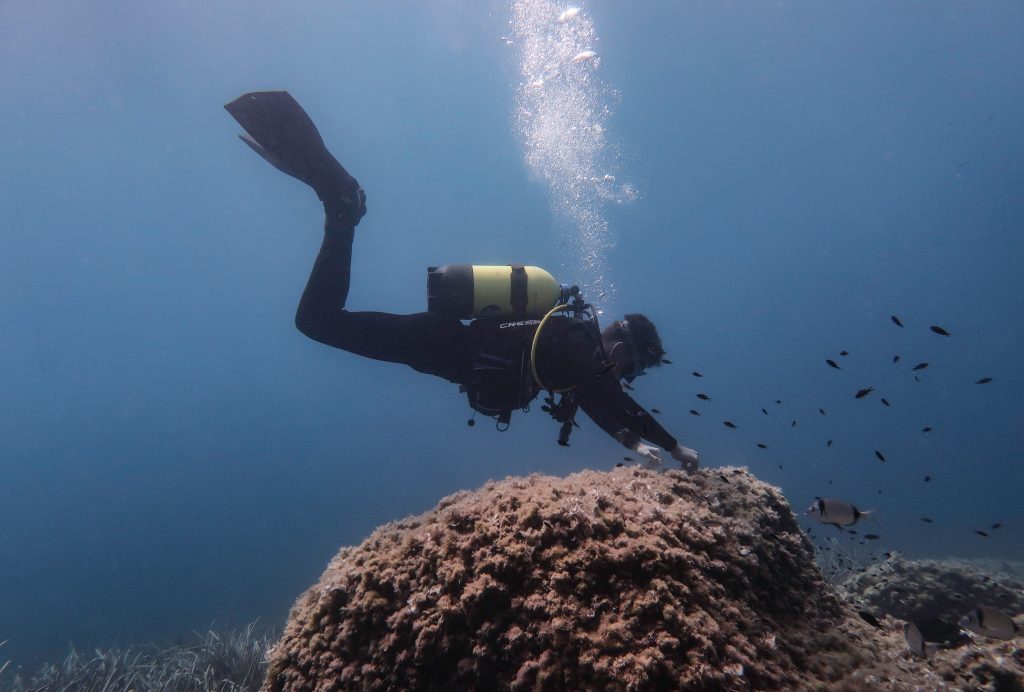
Conversely, if your fins/legs are too heavy, they will gradually sink, becoming the lowest point of your body, as shown below.
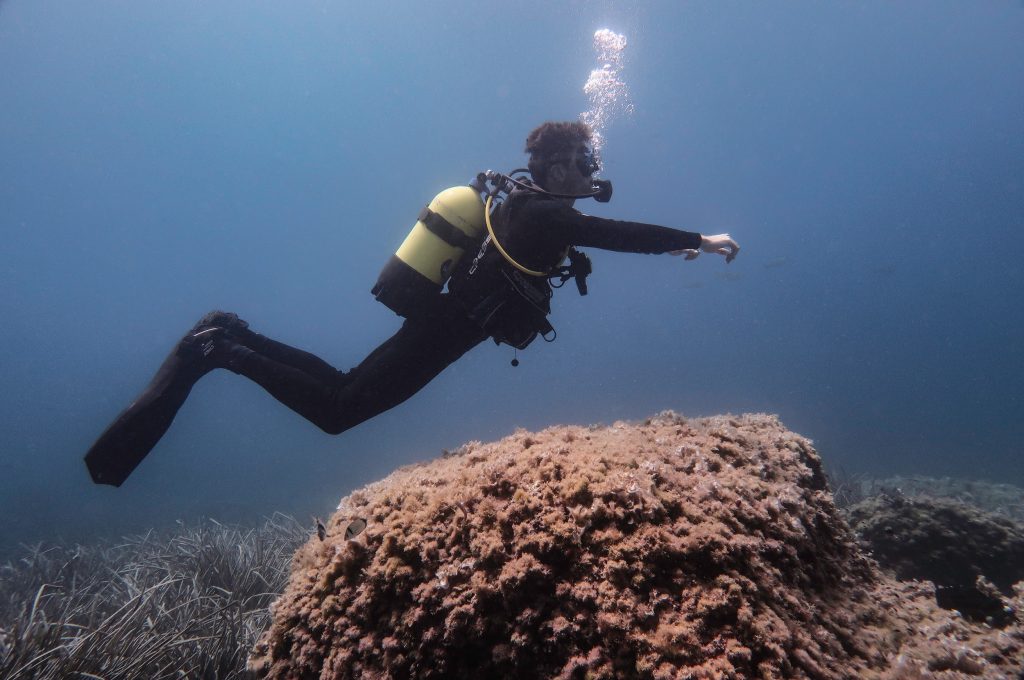
Similarly, if your legs neither rise nor sink excessively, and your body stays roughly 20-40 degrees off horizontal, then you are perfectly trimmed. This is demonstrated below.
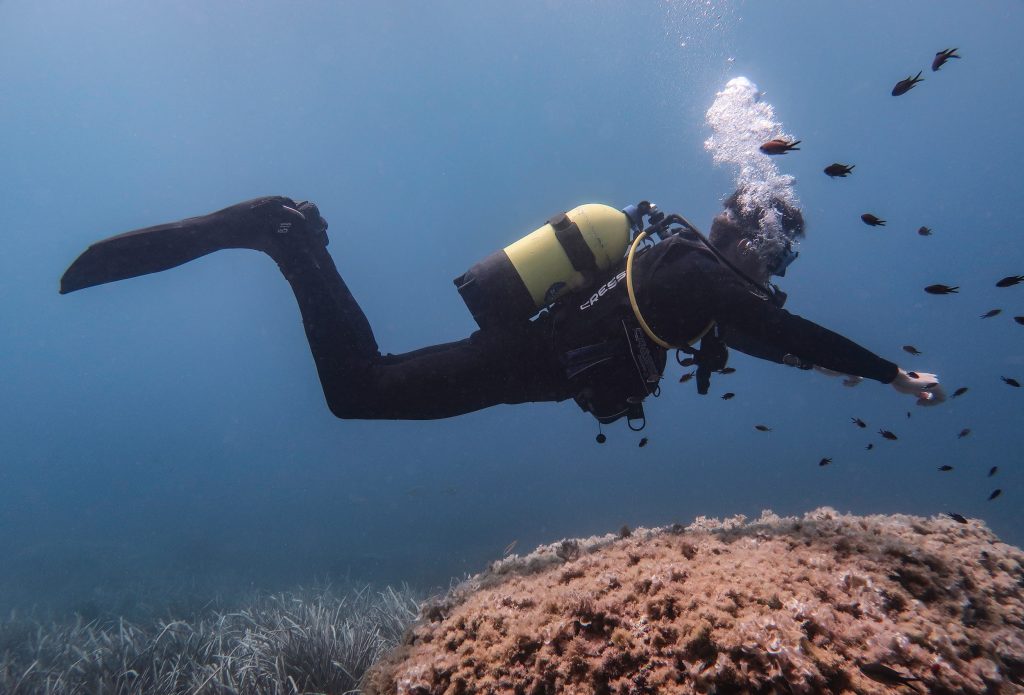
On the other hand, your body may shift to one side, showing an imbalance on the lateral plane, as shown below. In this case, this is due to another affecting factor of trim, such as weight distribution – however, as this article is concerning fin selection, we shall leave this for another time.
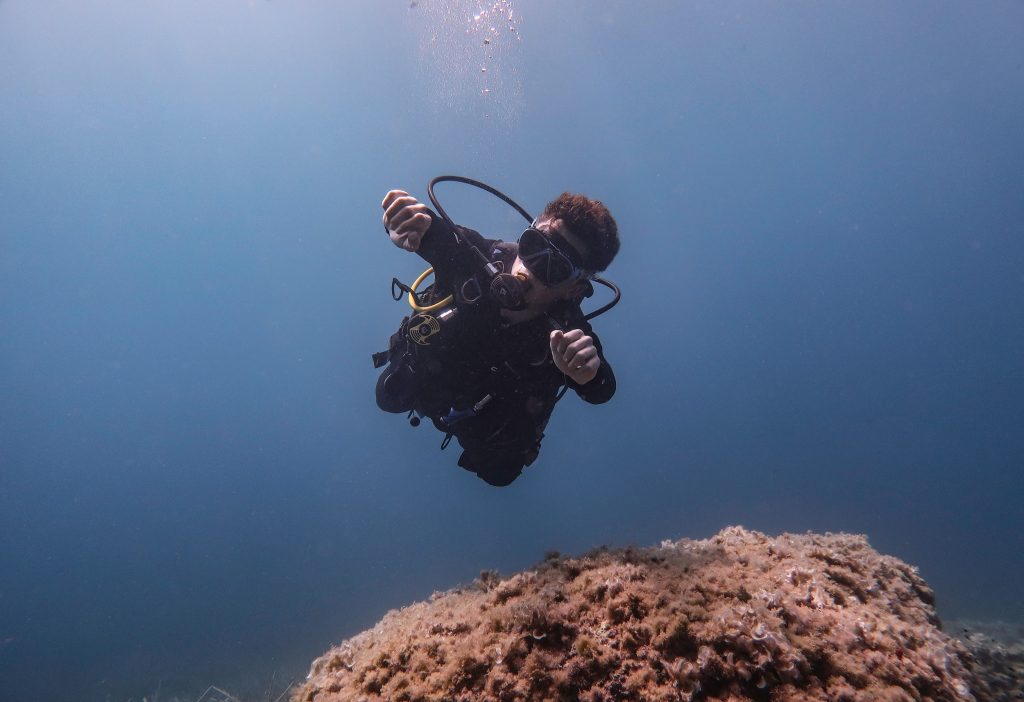
Given the result of this simple in-water trim check, you can now make a more informed decision as to what characteristics you are looking for in a fin. If you suffer from floaty legs, then a fin that is slightly more negative will of course be of top priority, and vice versa. If your current fins already result in a perfectly trimmed in-water position then you will most likely want to look for fins possessing the same weight and material characteristics.
Scuba Fins in a Whole-Body Context
We have, hitherto, considered fin selection from a perspective of propulsion, and a perspective of trim. The third consideration, intertwining the previous two, is how scuba diving fins interact in a whole-body context with the rest of your equipment, and how changing various pieces of equipment changes the desired characteristics of the scuba fins.
Firstly, exposure suits. Drysuit divers tend to be in an on-going battle with floaty feet, especially neophyte drysuit divers. Therefore, a fin with negative buoyancy is often the most desirable option, in order to mitigate this problem. Some divers are apprehensive to dive with a heavier fin, however, it is almost always better to dive with a fin that is slightly too negative than too positive. This is especially the case for drysuit divers, as it is easy to compensate for any excess negative buoyancy by simply shifting air to the feet until reaching a neutral level. With excessively negative fins, when taking a stroke, you are able to kick backwards and upwards, thereby partly compensating the negative buoyancy whilst maintaining kicking power and finning control. However, with excessively positive fins, this is not possible as you are unable to kick downwards without ascending, as if you kick back and down you will ascend in the water column, and, equally, when you kick backwards your legs will naturally be pulled upwards, thus losing kicking power and finning control.
When it comes to wetsuit diving , fins that are either neutral or even slightly positive tend to be more desirable. That said, however, some divers suffer from floaty legs, regardless of the exposure suit they wear. This tends to be seen especially in those who carry more fat in their legs, as fat floats and muscle sinks.
Secondly, equipment configurations. For twinset divers, the heaviest part of their body tends to be their torso. For those diving in an aluminium twinset, this is even more the case, as the aluminium tanks become positive throughout the dive causing the weight to be concentrated further up their back. Therefore, a pair of negative, or at the very least neutral, fins are the most desirable option, as they will balance out the twinset diver like a seesaw, putting them into perfect trim. Alternatively, for the sidemount diver, the majority of weight is centred on the waist. This causes the hips to sag and, consequently, for the legs to sink. Therefore, a slightly lighter, more positive fin tends to work better in providing perfect trim. Of course, however, you also need to consider what type of exposure protection you will be using with what equipment configuration, as a drysuit sidemount diver will most likely want heavier fins to compensate for the effects of the drysuit, for example.
Ready to start Scuba Diving?
Read our free guides and informational content to get you ready for your next scuba diving adventure!
© ReadyDive 2021

5 Best Scuba Fins for Travel and Diving Adventures [Editor’s Picks!]
Traveling and having a scuba vacation is a great way to unwind. Nevertheless, you don’t want to be stuck on rental fins that don’t fit well or are not suitable for your swimming style. So if you’re a traveling diver, you might as well get a pair of the best scuba fins for travel. Below, we have reviewed 5 of the best fins that you can add on your diving gears:
How diving fins work
Scuba diving fins are probably one of the most important gears that every diver can’t live without. The main purpose of fins is to aid swimming and movement underwater. Moreover, it reduces muscle fatigue as it offers additional velocity so your feet can cut through the water and you can advance easily. It’s also crucial in the ease of ascending and descending, especially for deep dives and harsh underwater conditions.
Also, dive fins help you maximize your air supply. Since you’ll be performing less labored movements, you will consume less air and it helps with buoyancy as well. Also, since you have an extra length on the fin blades, you no longer have to use your hands to swim. This is very useful for those who are operating underwater equipment like cameras , propeller, lights, and so on.
Diving fins play an integral role in the hydrodynamics of a diver. Do you wonder how it feels like to dive without fins? Here’s what will happen:
As you see, it’s hard to gain buoyancy, plus you’re going to dust the bottom, which will affect the visibility level.
– Anatomy of a dive fin
Dive fins usually have six parts: strap, buckle, foot pocket, side bars or rails, winglets, and blade. Each one affects the efficiency of the fin underwater so it’s important to know how each parts works.
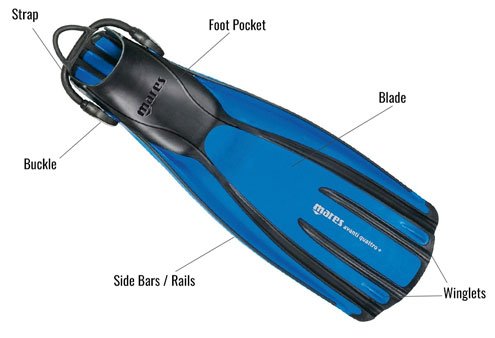
How scuba travel fins differ from others
So how does a travel fin differ from other dive or swim fins? Well, it all boils down to the size. You need one that you can stash easily in your gear bag . As much as you can purchase the longest and largest dive fins, bringing it to your travels can be a pain.
Also, you may want to look for ones that you can wear without any additional gears. This way, you can also use it for snorkeling and other leisure activities.
No one wants a dive fin that takes up more than half of their luggage’s size. Nevertheless, size may not be a big deal if you’re traveling on your own car. But if you’re hopping on a plane, you might as well look for the top scuba fins with a manageable size.
Full foot vs. open heel fins
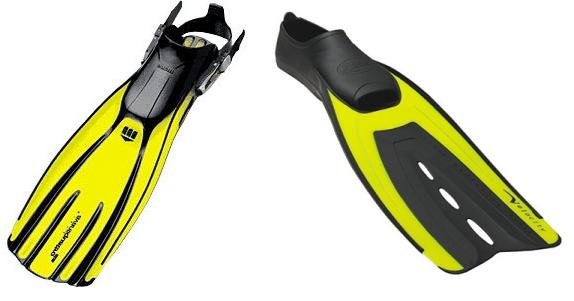
There are two main types of scuba fins: a full foot type and an open heel type. The following are the differences and use of each one:
**Full foot fins
As its name indicates, full foot fins have enclosed type designs and is the traditional option among divers. It’s a single-piece fin where you’ll slide your feet into for a snugly fit. As much as this offers convenience, it lacks adjustability. Nevertheless, this wouldn’t be a big problem if you got the right sizing, but you can’t share them with other divers with different foot sizes.
Moreover, closed foot fins offer less protection. Why? Since it has an enclosed construction, you can’t wear dive boots. Also, full foot fins don’t protect your soles from rocky or rough surfaces. Aside from that, full foot fins aren’t ideal for cold water and can cause blisters if you have tubby toes.
Anyway, you can still fit in a thin neoprene sock for added thermal protection if the underwater temperature is a bit chilly. Another consolation here is that full foot fins have better energy transfer.
It’s also challenging to put on and off, but they are best for beginners who are still mastering their buoyancy. In addition, they are more affordable than open heel types.
**Open heel fins
For those who are looking for versatility, open heel fins are the best option. You can easily adjust the fit so you can make way for your large feet or a dive boot. This way, you have protection from cold temperatures or deep diving. You can also change the thickness of your boots to suit the temperature and protection you need.
Needless to say, this type of dive fin is a champ when it comes to protection. It suits both soft and rigid boot soles. Actually, wearing rigid boots on this type of fin will prevent the strap from slipping, which boosts the fit.
Buckle vs. spring strap
If you opt for the open heel fin, you’d have to choose between a spring strap and a buckle enclosure. Both works and it’s easy to put the fin on and off. Also, the two are highly adjustable but it sure does offer varying results.
First of all, quick release buckles are convenient in way that you can put if off without losing the desired tension. So when you have to dive again, it’s all set. This saves you time, especially if your dive group is taking advantage of a specific time window. It also prevents you from rushing the setup of your gears.
On the other hand, spring straps have a stainless steel bungee that provides tension to the strap. The goal here is to provide the best fit above and below water. It means that the spring will adjust automatically as the pressure and temperature changes as you ascend or descend.
Diving fins blade types
Over the years, manufacturers of diving gears have come up with different types of fins. Each one has a specific configuration and set of features that improve your diving efficiency. Also, this diversity allows you to purchase the best travel scuba fins that suit your style. The following are 5 of the most common blade types of diving fins.
**Standard fins
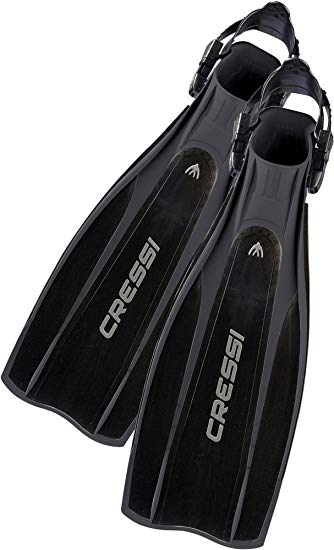
Also known as paddle fins, they have a flat blade that allows the water to spill on the sides. Some comes with side reinforcements to provide better paddling strength.
Nevertheless, this is the traditional option among divers and beginners. It provides an up and down motion and excellent performance on moderate currents. However, paddle fins are best for those with strong legs.
**Split fins
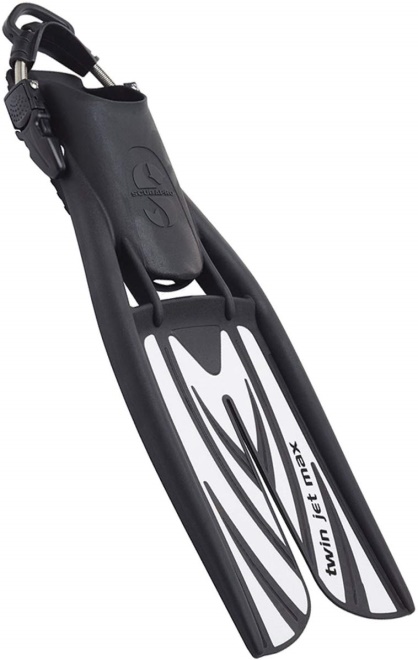
Split fins are like paddle fins but with a slit in the middle. It’s like having two small fins side by side. With this blade design, you can move faster underwater as it acts like a boat propeller.
As you move, the fins will move in different angles so every kick produces excellent results. Also, if you’re planning to spend an extended period underwater, they are the best option. It reduces muscle fatigue without compromising its efficiency.
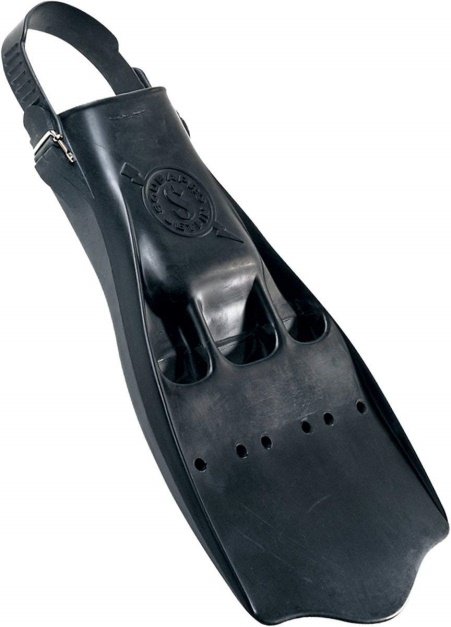
Also known as channel fins, they are ideal for professional and technical divers. The construction of this dive fin includes rubber channels added in the blade area. It’s used to funnel water as the diver kicks. With this design, the diver can move even faster than using a split fin.
Jet fins may have a shorter length, but it’s actually more powerful than other blade designs. However, it’s heavier so it takes practice and expertise to get used to this fin.
In addition, they may suit various swimming styles, but it performs better with frog kicks.
**Hinged fins
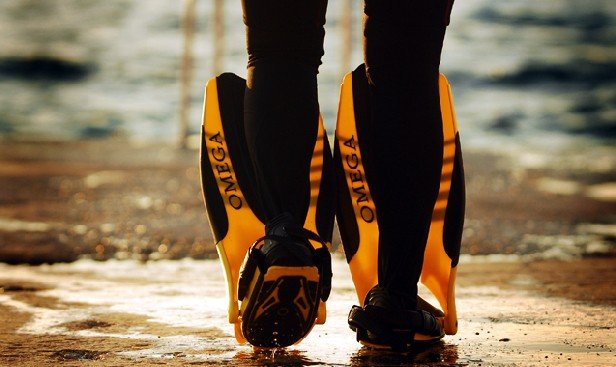
This type of fin blade allows customization as you can adjust the angle to suit your swimming style. It has a hinge that connects the blade and the foot. Once you adjusted the angle, you can lock it in place. In addition, this type of blade is also known as flippers since you can literally flip the length of the blade up so you can walk properly. This type of blade usually comes in an open heel design for excellent adjustability.
**Force fins
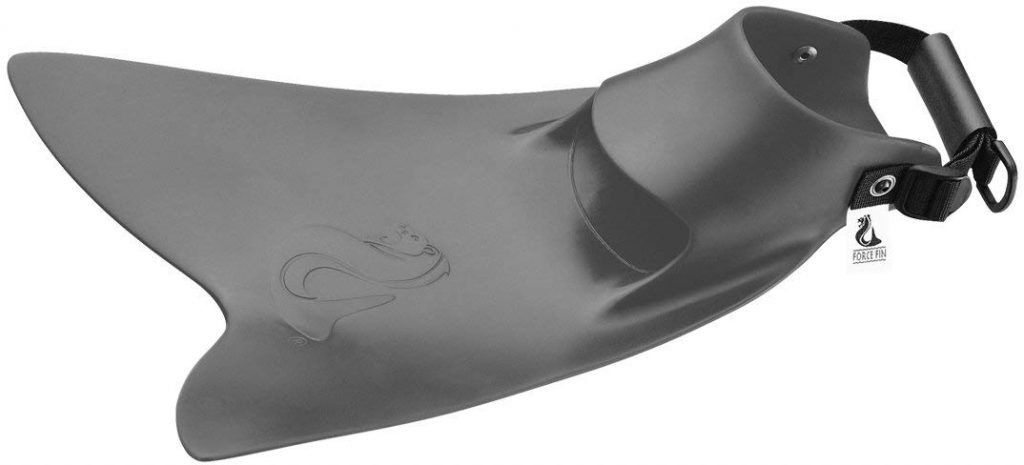
Unlike typical dive fins, force fins sport a different blade design. It’s similar to a whale’s tail, but in a narrower and longer fashion. This blade is thin, lightweight, and very durable. However, it’s also expensive. Nevertheless, this is effective, especially if you’re swimming with short flutter strokes.
Take note that all force fins have an open heel design so you need to wear either a neoprene sock or dive boots.
5 Best Scuba Fins for Travel Reviewed
Are you looking for the top scuba diving fins for travel and adventure? Fret not because we picked 5 of the best options with different blade types. Check which one you prefer the most!
OUR TOP PICK
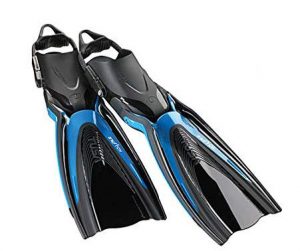
Product Name: TUSA SF-0104 Hyflex Switch Diving Fins
Product Description: For those looking for standard paddle fins, we highly recommend the TUSA SF-0104 Hyflex Switch Fins. It has an open heel design with a bungee strap for the best fit no matter what the underwater temperature is. This TUSA pair also sports the PuRiMax’s Polyurethane Blade System that provides excellent energy transform for every movement of the diver. Moreover, these fins are equipped with TUSA’s proprietary Vortex Generator technology that reduces water resistance on the fin stroke. In addition, you will surely find comfort in this pair’s multi-compound foot pocket. It also has an angled blade design that enhances your finning even on deep dives. Most of all, you can adjust the bungee straps in different positions for an accurate fit.
- CHECK PRICE ON AMAZON
- Blade Quality
- Comfort and Fit
- Value for Money
- Thrusting Power
Also, this TUSA fins are ideal even for strong currents. It has the right stiffness which suits those with strong legs and crampy leg muscles.
You shouldn’t be surprised that this fin has a large foot pocket. Put 5 to 7 mm dive boots on and it will fit like a perfect glove. It provides effortless kicking with excellent acceleration. And if you’re traveling, you can dissemble the fins and foot pockets to save on baggage fees (place it in your carry-on!).
✔️Angled blade
✔️Reduced water resistance
✔️Suitable for thick dive boots
❌Not for very small feet
Runners-up: Mares Avanti Quattro Plus Open Heel Fins
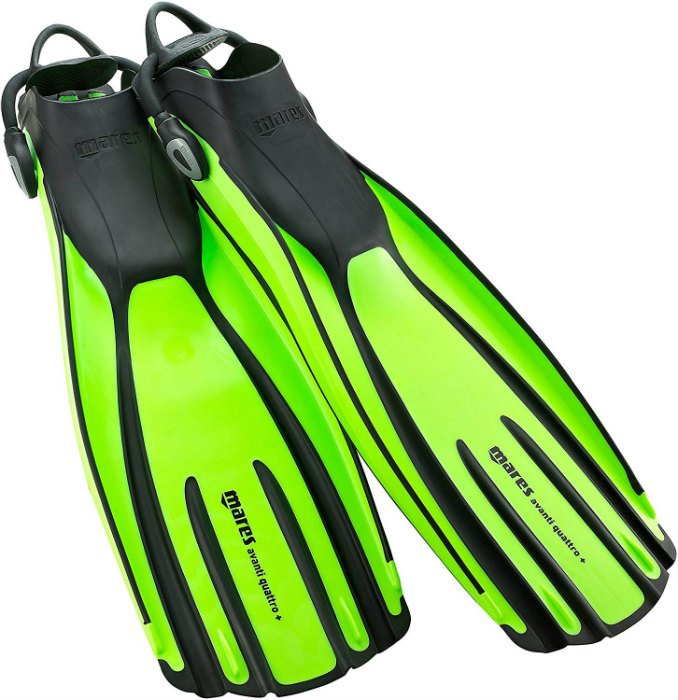
If you’re looking for more thrusting power, you should invest in a pair of Mares Avanti Quattro Plus Open Heel Fins. It has four channels that will boost your efficiency together with its hi-flex material guaranteed to last long. Unlike its predecessor, the Avanti Quattro Plus offers thrusting power and responsiveness so you can accelerate with the least effort.
Moreover, this pair boasts an anatomical foot pocket that transfers the energy well into the blades. Together with a bungee strap, these fins are versatile gears that will improve your diving experience. It also comes with stabilizers that help with your buoyancy and finning techniques.
This Mares pair has a more attractive look and performance as a standard fin type. Most dive boots will fit here, which is added peace of mind for you as a diver.
Overall, we can say that this Mares pair is one of the fastest in the bunch of models we’ve tried before. It does a great job on alternative kicks, especially for open water locations. However, it’s not the best choice if you’re a technical diver since it’s large and very flexible. Nevertheless, for most professional divers, these are excellent finds.
Cressi GARA 2000 HF Reactive Fins
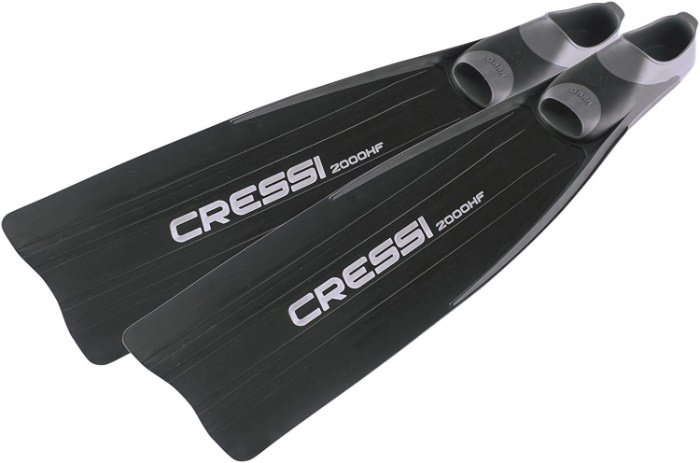
For those who are looking for a full foot fin, don’t hesitate to try the Cressi GARA 2000 HF Reactive Fins. These are made of a special polypropylene material blended with two other materials making it the world’s first fin to be made of three different materials.
Also, this pair is lightweight and reactive, which ensures reactivity so you can practice your buoyancy and skin diving. There’s also a soft elastomer wrapped around the foot area to improve the leg-fin thrust and energy transmission to the blades. Moreover, it was produced using Cressi’s proprietary molding process that bonds three different materials.
These full foot, standard fins can be worn with or without neoprene socks. It’s made in Italy and the blades are longer and stiff to offer better underwater movement.
Aside from diving, these fins are also great for swimming and snorkeling . Compared to the GARA Professional, the GARA 2000 HF is faster. However, this pair is a bit taxing on the ankles so you better put on neoprene socks for extended use.
Scuba Pro Jet Fins
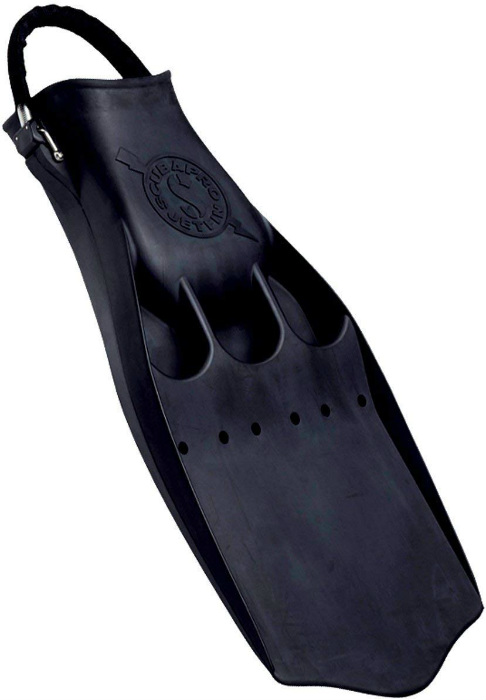
If you’re a technical diver who’s looking for jet fins, you should try the Scuba Pro Jet Fins. It’s made of marine-grade rubber that will last a lifetime if maintained properly. Also, it has a vented design that reduces drag and enhances the thrusting power of the diver.
Moreover, this is excellent for wreck and cave diving, especially for divers with frog kick finning techniques. As an open heel type, this is equipped with a stainless steel, self-adjusting bungee for a perfect fit.
They are ideal for recreational, military, professional, technical, and commercial use. It’s a very versatile pair of fins, although it has a learning curve. Aside from that, these are also ideal for travel due to its shorter blade.
However, we want to point out that the sizing of this fin is quite small. Make sure that you inquire first so you’ll get the right size based on your shoe size. Aside from that, the bungee tends to be a bit tight. Anyway, we think that once you break it in, it’s going to be more comfortable to wear. Besides, if you have small feet, the tight spring will be an advantage.

Apeks RK3 Military Rubber Fin
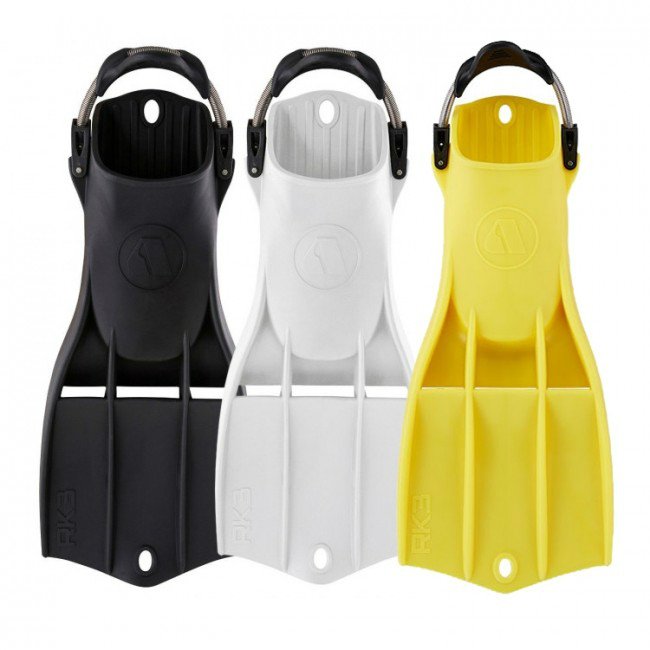
Another jet fin that we like is the Apeks RK3 Military Rubber Fin. It’s a traditional all-rubber fin that provides excellent efficiency while underwater. Also, it has the standard stainless steel bungee with a buckle that keeps the strap in place.
Moreover, this Apeks fin has a short yet wide blade that allows the diver to accelerate easily. Thanks to its thrusting power and maneuverability, these fins are ideal for technical and deep diving. It has a rugged construction that can endure the harsh environment above and below the water.
Also, what we really like the most is that this fin is designed based on the vented scuba fins that the US military is using. That’s a guarantee that this will work efficiently and provide the best thrusting power.
For travelers, these are convenient as it can fit inside a duffle bag. However, you should bring a neoprene sock or dive boots when using this as the bungee will chafe your ankles if worn without any layer of protection.
Considerations When Buying The B est Travel Scuba Fins
**size and fit (how to size up).
When buying scuba fins, make sure that you consider the following points first:
Just like purchasing a new pair of shoes , you should always size up your fins properly. Take note that a wrongfully sizes fin is useless as it doesn’t offer the best performance and comfort underwater. Overall, open heel fins suit most foot sizes since it’s adjustable.
Sizing your fins is easy: just get the same size as your shoes. However, for women, it’s customary to purchase fins that are one or two sizes down than their shoe size.
If you’re purchasing an open heel fin and planning to wear a thick boot in it, you should consider getting a size up. Anyway, inquiring to the seller will help since each brand has their own sizing chart.
**Blade length
Usually, best scuba fins for traveling will range between the length of 15 and 20 chest. Since it’s shorter, it’s easier to transport but without sacrificing the efficiency underwater. Take note that jet fins are short, but they offer better speeds than longer ones.
Nevertheless, size matters a lot when it comes to your blades. Long ones are best for those who have a flutter kick style or those diving in an open ocean. However, it’s difficult to transport if you’re traveling.
On the other hand, medium and short blades are convenient since it doesn’t consume too much space on your luggage. Even if they are short, you can still achieve optimal finning using frog kicks.
In the end, it’s all about your finning style, luggage size, and personal preference. These will define the right blade length you need. If you’re not yet sure what you’ll like, you can rent different fin sizes on a dive shop and take it to a plunge. See which one is the most comfortable and offers the best efficiency.
**Blade stiffness
Just like its length, dive fins come with varying stiffness. Tough and rigid types are ideal in swimming with speed and strength. So if you have strong legs, this might be the type for you. Rigid fins are also perfect for those who want more stability and to prevent the strap from slipping in case of open heel types.
However, stiff blades can make it hard for you to change your position underwater. Unless you have mastered your buoyancy, you should consider softer blades for the meantime.
The rule of thumb is that the stronger your legs are, the firmer your fin blades should be. In addition, beginners who are still practicing their finning should start with a soft and short blade. It’s easier on the legs, which allows you to focus on the methods first.
**Overall quality
Scuba fins for travel should have the right balance of good design, quality materials, and functionality. That way, you can make the most out of your purchase. As you know, high-quality comes with a rather expensive price, so you might as well look for one that gives the best value for money.
**Fin weight
You’d want a pair that’s lightweight enough to not exceed your baggage limit. As for the diving aspect, you may need a lighter pair if your tank and other gears tend to be heavier than usual.
Nevertheless, lightweight fins are usually for recreational purpose. Since stiffer ones tend to be a bit heavier, it’s best for professional and experienced divers. It requires strength and dexterity to fin with a heavy blade.
**Foot pocket material
The foot pocket is the portion of the fin where you’ll slip your foot. It can be made of different materials like plastic, polypropylene, and a combination of rubber. However, if you’re a professional or technical diver, you should consider polypropylene or rubber fins as it’s long-lasting and can endure harsh underwater conditions.
Nevertheless, a combination of other materials is also ideal as it provides insulation and a level of softness. Some high-quality fins use polyurethane, which is also durable even for deep-sea dives.
**Heel style
Like what we discussed above, fin heels fall in two types: open and enclosed. If you’re diving in shallow depths with warm to normal temperatures, you can thrive using an enclosed or full foot pair of fins. However, during cold temperatures and deep dives, it’s a rule that you wear open heel fins with thick boots on.
Moreover, using enclosed heels on a deep dive increases your risk of getting cold. As you know, this type of fin doesn’t allow you to wear thick boots. It will only take a matter of minutes before the cold temperature gets into your skin. And when you get too cold underwater, you’re also exposed to a higher risk of decompression sickness.
**Propulsion
Propulsion is the motion that gets you moving in the water after kicking. Your choice of fins should always provide the highest possible propulsion so you can achieve the best distance with the least possible effort.
When it comes to propulsion, split fins offer the best advantage. Also, most modern fins are produced with designs that allow better angling and thrusting. This way, you can accelerate faster, which saves you air and energy, especially during a long dive.
**Additional accessories
Scuba fins are useful in itself, but you can improve its function with the use of some accessories. It will enhance your finning skills while keeping them intact for a longer period. The following are some of the fin accessories you can get aside from a new pair of fins.
– Fin bag . For traveling divers, fin bags are useful accessories that help them stash the blades easily in their luggage. It also keeps things organized before and after the dive.
– Replacement straps . If you dive often, there’s a chance that your fin straps will break (for open heel types only). So make sure that you keep a spare ready to be used so your diving won’t be interrupted.
-Utility strap . This extra strap allows you to clip your fins in your BCD. It’s useful, especially if the space on the boat is limited and you need to organize your gears.
-Save-a-dive-kit . This kit is essential, especially for frequent divers. When something goes wrong on your gears, a save-a-dive-kit has the tools and materials needed to get it fixed. It can include your extra straps, regulator spare parts, and so on.
If you want quality scuba fins, you should be willing to spend premium money. Although they may seem expensive upfront, the purchase is worth it, especially for regular divers.
High-quality scuba fins last long and it guarantees your safety underwater. Sure, it may cost more now, but it will save you from dud pairs and purchasing new ones repeatedly.
Frequently Asked Questions
Q: can you use freediving fins for scuba.
A: For leisure divers, most fins don’t really make a big difference for shallow depths. So yes, you can use your freediving fins if you’re scuba diving. However, if you’re a professional diver with a specific swimming technique, it’s best to purchase a pair that suits your needs and type of diving.
Q: Why do divers wear flippers?
A: Flippers are necessary to make swimming easier. The extra length of the fins allows the diver to pass through water without exerting more effort. This reduces muscle strain or cramps, especially for deep diving.
Q: Do fins help you float?
A: They don’t necessary help in floating, but it can help in balancing the buoyancy of a diver once he or she is underwater. It adds velocity to the stroke of the feet plus it improves body position without too much effort.
Q: What is the difference between snorkeling fins and scuba fins?
A : It’s all about the length. Scuba diving fins are shorter at about 15 to 20 inches. Meanwhile, snorkelling fins are longer and can reach between 24 and 26 inches. Take note that snorkelling fins should never be used for deep diving as it offers lower control over strong currents.
Q: How tight should fins be?
A: When it comes to diving fins, close and snug fits are preferred. This way, they will not come off your feet even during a strong current or intense underwater pressure. Although they should never be too loose, it should still allow circulation in your feet.
Final words
The best scuba fins for travel are every nomadic diver’s must-have. Unlike other fins, what we reviewed above are durable, long-lasting, and easy to carry. You no longer have to settle with rentals that don’t fit. So for your next plunge, invest in a trusty pair that matches your swimming style, preferences, and goals. What do you think of our options here? Let us know below!
You might also like:
- How to Safely Reuse and Repurpose Old Scuba Diving Tanks
- Essential List: What Scuba Diving Equipment Is Needed
- How Does A Diving Watch Work
- Top 5 Cheap Underwater Cameras – Review & Buying Guide
- Best Swimming Goggles For Triathletes (Review & Buying Guide)
The 9 Best Scuba Diving Fins for Efficient Movement and Control

As you assemble your gear, you’ll need to find the best scuba diving fins for your preferences and needs. It’s essential that you take as much time as you would when shopping for a regulator . That will ensure you find fins that offer the power, comfort, and control you need.
The best scuba fins for you depend on your intended diving environment. For instance, if you plan to dive in harsh conditions, you’ll need durable fins like the Apeks RK3. Your experience and strength also play a crucial role in choosing suitable diving fins. That’s why beginners opt for the TUSA SF-22 Solla Fins. Remember to select the right size for comfort.
This ultimate buyer’s guide will walk you through the best scuba diving fins. From the best fins for strong currents to the best freediving fins , we dive into various scuba fins for different diver experience levels.
Table of Contents
Our Top 5 Picks of the Best Scuba Fins
- Best fins for strong currents : Scubapro Seawing Supernova Fins
- Best for warm water dives : Mares Avanti Super-Channel Full Foot Fins
- Best snorkeling & freediving fins: Cressi Rondinella Full Foot Fins
- Best scuba fins for beginners: Tusa SF 22 Solla Fins
- Best for precision and power: Mares X-Stream Fins
Disclaimer: We are entirely reader-supported. When you buy through links on our site, we may earn a small affiliate commission. This does not affect our opinion of the products linked, which is 100% impartial and unbiased.
Types of Scuba Diving Fins
As you’re on the hunt for the best scuba diving fins, you’ll come across the following types:
- Full foot fins: These tend to have shorter, more flexible blades, making kicking under the water easier. You won’t need to wear spongy neoprene booties with these as they cover the whole foot. And they’re much lighter than open heel fins.
- Open heel fins: These have an open back and require a dive boot. You secure them on your foot with a heel strap. Divers who dive in cold or cooler waters prefer open heel fins for greater efficiency.
- Split fins: These slice through the water with minimal resistance, offering significant power the faster you kick.
- Paddle fins: These are traditional fins with stiff blades that require more leg muscle to kick underwater.
- Pivot fins: These are a newer design that merges the thrust and power of traditional paddle fins and the speed of a split fin. They have a pivot point where the foot connects with the blade so that you can adjust the angle to your needs.
9 Best Scuba Diving Fins
1. scubapro seawing supernova fins.

Our Expert Opinion: Best Fins for Strong Currents
The Scubapro Seawing Supernova are trailblazing, award-winning diving fins designed for recreational and professional divers. They offer superior speed, power, and control, making them one of the best fins for strong currents. Moreover, although they’re at the high end regarding cost, they have several advanced features, such as the twin-tip winglets.
What You Need to Know
Scubapro’s Seawing Supernova are high-performance fins that won the prestigious Red Dot Award for product design. This model is one of the best scuba diving fins thanks to its Pivot Control Technology (PCT) and Auto-Adjust central panel. As a result of those features, they’re more efficient in converting kicks into forward motion.
Moreover, the Seawing Supernova has twin-tip winglets. These offer enhanced maneuverability, especially for frog and alternate kicks. The Seawing Supernova fins also feature an innovative blade shape, delivering increased power, speed, and maneuverability.
Made from Monoprene, the fin is exceptionally durable. And the open heel has an upgraded, heavy-duty bungee strap to accommodate different boot types.
Thanks to their innovative two-piece design, you can easily and conveniently transport your fins. You can also opt for an optional full-foot pocket for diving in warm-water environments.
Specs & Features
- Price : $299.00
- Material : Elastomer Monoprene
- Fin type : Open heel
- Blade Type : Vented Articulated Mid-Point Joint
- Weight : 3.7 lbs. (1.7 kg)
- Sizes : XS, S, M, L, XL
What We Like
- Ease of putting on and taking off
- Great for travel thanks to its lightweight design
- Good thrust and maneuverability
- Ideal for warm and cold water
- Suitable for various boot sizes and styles
What We Don’t Like
- At the higher end, cost-wise
- Only available in black and white
- Flexible blade might make it difficult for precision movements underwater
2. Mares Avanti Super-Channel Full Foot Fins

Our Expert Opinion: Best for Warm Water Dives
Opting for the Mares Avanti Super-Channel Full Foot Fins means you’ll be treated to significant power and efficiency during your divers. While it is bulkier than other scuba fins, it’s suitable for dives in warm water.
Mares’ fins are notorious for offering a perfect balance between power and efficiency. The design is inspired by marine mammals. And it incorporates Channel Thrust technology for enhanced water channeling to move a significantly large volume of water.
Therefore, these are the best scuba diving fins that offer great thrust with less effort. Furthermore, they include a large, flexible central propeller-like blade that optimizes water flow down the fin. This minimizes wasteful spillage and ensures optimal performance with minimal diver exertion.
The fin blades are constructed from Tecralene and Thermoplastic rubber. Therefore, they are exceptionally durable. They also come in various sizes and colors, catering to different preferences and needs.
- Price : $74.95
- Material : Tecralene; Thermoplastic Rubber
- Fin type : Full foot
- Blade Type : Non-vented
- Weight : 1.5 lbs. (680 g)
- Sizes : S, M, L, XL, XXL
- Fair price point
- Various color options available
- Fin with four channels for increased thrusting power
- Bulky, so it might not be suitable for travelling
3. Cressi Rondinella Full Foot Fins

Our Expert Opinion: Best Snorkeling & Freediving Fins
Look no further than the Cressi Rondinella Full Foot Fins for high performance and stability. These are the best freediving fins crafted with a powerful polypropylene blade. They are user-friendly, not overly strenuous, and perform well underwater.
Cressi’s Rondinella Fins are a modern reimagining of the revered Rondine fins. They feature a powerful polypropylene blade placed atop a full foot pocket. That ensures optimal blade alignment with your leg.
Furthermore, the Rondinella Fins have a short blade constructed from durable and lightweight polypropylene, offering both performance and stability. They also have a soft, flexible thermo-rubber foot pocket melded with the blade. The fin frames and specific blade inserts are also constructed from that material, ensuring lightness and power.
- Price: $36.95
- Material: Blade: Polypropylene; Foot Pocket, Rails & Inserts: Thermo-Rubber Elastomer
- Fin type: Full foot
- Blade Type: Non-vented
- Weight: 2.2 lbs. (1 kg)
- Sizes: US men: 1 – 11; US Women: 3 – 13; EU: 31 – 46
- Designed for alignment with different foot sizes
- Extremely light blade
- Easy to slip on and off
- Offers relaxing but efficient propulsion
- May not be suitable for colder waters, specifically those below 60 degrees Fahrenheit
- Pressure on the top of the foot and toes may occur due to full-foot design
4. TUSA SF-22 Solla Fins

Our Expert Opinion: Best Scuba Fins for Beginners
Anyone new to scuba diving will be treated to superior propulsion with the Tusa SF 22 Solla Fins . These are the best scuba diving fins, thanks to their exceptional performance, durability, and fit. And although they’re not the best for travel, they offer an excellent all-around experience with reliable traction on the sea floor.
TUSA’s SF-22 Solla is where performance fin design and hydrodynamic advancements fuse. Boasting several distinctive features that enhance propulsion, speed, and maneuverability, these fins are a superior underwater companion.
The SF-22 fins feature the ForceLast Technology. That revolutionary system delivers game-changing performance and efficiency, distinguishing it from traditional blade fins.
In addition, the SF-22 fins have a patented 20-degree angled blade design and a 3-channel crescent-shaped blade with reinforced side rails and vents. And thanks to their specialized thermoplastic elastomer (TPE) compound construction, this model boasts superior propulsion, efficiency, and speed.
The SF-22 fins also feature TUSA’s anatomic fin strap (AFS). This ensures a balance between flexibility and control. Plus, it boosts comfort and power transfer and reduces heel slippage.
Available in various sizes and colors, divers can find a suitable model for their preferences and needs. There is also a range of blade lengths available, from 22″ to 24.7″ (55.7cm to 62.7cm).
- Price: $99.95
- Material: Thermoplastic Elastomer (TPE)
- Fin type: Open heel
- Blade Type: Vented
- Weight: 3.5 lbs. (1.6 kg)
- Sizes: XS, S, M, L, XL
- Comfortable due to the soft and flexible sole
- Efficient blade placement
- Easy to wear thanks to open-heel design
- Reinforced side rails for extra stability
- Heavy and bulky
- Strap makes getting in and out of water difficult
5. Mares X-Stream Fins

Our Expert Opinion: Best for Precision and Power
The Mares X-Stream Fins are among the best scuba diving fins because of their exceptional design. It’s less likely you’ll experience the parachute effect while diving, which can slow you down. Instead, you’ll get more power from your kick thanks to the Optimized Pivoting Blade (OPB) system. Although it does have its shortcomings, you can move faster and more efficiently underwater.
Comfort and efficiency are the hallmarks of the Mares X-Stream Fins. This model boasts the Optimized Pivoting Blade (OPB) system, which reduces fatigue and provides smooth movement under the water throughout the kicking cycle.
Furthermore, the X-Stream Fins have an ergonomically designed foot pocket. That evenly distributes pressure. As a result, you won’t experience severe foot fatigue and foot pocket flexing.
The X-Stream Fins are also constructed with perforations that prevent a parachute effect caused by water flowing between the bootie and the pocket. This design also reduces added weight.
In addition, the Super-Channel blade design features a large central super-channel and two lateral channels. This delivers powerful thrust on top of maintaining efficiency and minimizing leg fatigue.
Thanks to their tri-material construction, the X-Stream Fins are highly durable. They’re also easy to put on and take off because of the adjustable straps with large heel pull tabs.
- Price: $189.95
- Material: Tecralene, Thermoplastic Rubber
- Fin type: Vented
- Blade Type: Open heel
- Weight: 3.3 lbs. (1.5 kg) [Size Regular]
- Sizes: S, Reg, XL
- Open heel design makes it easy to get them on and off
- Comfortable
- Excellent thrust and water flow; effortlessly fast at the surface
- Tri-material construction for enhanced durability
- Designed to reduce fatigue while diving
- Straps may not last long
6. Atomic Aquatics Split Fins

Our Expert Opinion: Best for Professional Divers
Split fins are a popular choice amongst divers today because of their ability to reduce effort and air consumption. They also provide efficient propulsion. The Atomic Aquatic Split Fins are one of the best scuba diving fins with this design, offering exceptional underwater experiences for professional divers.
The Atomic Aquatic Split Fins offer enhanced propulsion and reduce the effort required for movement underwater. They also provide less drag and more thrust thanks to the semi-rigid flex battens within the elastomeric blade that control the wing shape.
These fins also feature power rails in the split fin. Those act as a backbone, storing and releasing energy with each kick. Also, the thin yet strong hinge points between the semi-rigid battens enable quick and efficient reactions to subtle movements.
Constructed from advanced composite plastic polymer materials, the Atomic Split Fins are lightweight for travel. This construction also increases thrust while reducing fatigue.
- Price: $249.95
- Material: Composite Plastic Polymer
- Blade Type: Split
- Weight: 3 lbs. (1.5 kg)
- Sizes: S, M, L, XL
- Extremely comfortable
- Available in a range of colors
- Easy on and off with no rubbing
- Made for precise and technical movements
- Split fin design ensures easy gliding with minimal effort
- High price point
- Not be suitable for beginners
7. Scubapro Go Travel Fins

Our Expert Opinion: Best Scuba Fins for Travel
Scubapro’s Go Fin is a game-changer for water-loving travelers . The fins are lightweight, comfortable, and durable, excelling in performance. Although they have their quirks, they’re the best scuba fins for travel, enabling adventure seekers to explore different waters around the world efficiently.
The Go Fins by Scubapro are remarkable barefoot fins designed for avid travelers who enjoy diving and snorkeling. They only weigh 2.6 lbs. Therefore, they’re the ideal companion for your underwater adventures.
Combining quality with convenience, the Go Fins are a premium choice amongst divers. Their barefoot design and self-adjusting bungee heel strap ensure comfort. And you can wear them with neoprene socks for added protection or without socks.
The Go Fins excel underwater thanks to their pre-angled blades, central power panels, and power bars. Those maintain optimal angles under high load conditions. As a result, the lightweight fins deliver power, speed, and stability with minimal effort.
- Price: $110.00
- Material: Monoprene Rubber
- Weight: XS-S: 2.2 lbs. (1kg); M-L: 2.6 lbs. (1.2kg)
- Sizes: 3X-Small, 2X-Small, XS-Small, MD-LG, XL
- Hook and hole for easy storage
- Perfect for travel thanks to its compact and lightweight design
- Tough and durable due to 100% Monoprene
- Can be difficult to swim with because of the rigid material
- Small sizes not suitable to wear with shoe or boot
8. Apeks RK3 Fins

Our Expert Opinion: Best for Diving in Harsh Environments
Few scuba diving fins are as durable as the Apeks RK3 . That’s why they’re our top choice for divers embarking on underwater adventures in harsh environments. The RK3 fins are constructed from a specialist thermoplastic in collaboration with the US military and public service divers. Now, this means they aren’t as flexible as other scuba fins. But they produce plenty of power.
The Apeks RK3 fins are highly regarded amongst professional divers because of their solid fit. And they’re designed based on one of the first vented rubber fins in North America.
Known for exceptional performance and reliability, the RK3 has a compact and ultra-rugged construction. It also features a short, broad blade that offers maximum forward thrust and excellent maneuverability.
Furthermore, the vented blade design lessens resistance on the upstroke and boosts thrust on the downstroke. Meanwhile, it eliminates vortexes that can occur along the back of the blade.
What further makes the RK3 one of the best scuba diving fins is the two large grommet holes integrated into its design. This makes the fins easy to store with most carabiners when accessing dive sites.
- Price : $199.00
- Material : Thermoplastic Rubber (TPR)
- Blade Type : Vented
- Weight : Medium – 2.2 lbs. (982 g); Large – 2.6 lbs. (1.19 kg); Super – 2.8 lbs. (1.27 kg)
- Sizes : S, M, L, Super
- Suitable for harsh environments
- Used by pro divers, including the military
- Excessive power is not required to get moving
- Extremely easy to don
- Suitable weight for travel
- Pricier than some of the other best scuba diving fins
- Only available in four sizes
- Not as flexible as other fins in the market
9. Cressi Pro Light Fins

Our Expert Opinion: Best Scuba Fins for Value
Cressi’s Pro Light Fins are an attractive and cost-effective option for divers of all experience levels. They are exceptionally lightweight, and they’re constructed with a polypropylene blade material that makes them highly flexible and efficient. Additionally, they’re designed with a unique foot pocket that prevents heel extension, reducing foot fatigue and cramping.
The Cressi Pro Light Fins stand out due to their unique features. They’re constructed with a polypropylene blade material that offers variable flex during the kicking cycle. And they have side stringers and flaps along the blade for enhanced directional control.
Moreover, the Pro Light Fins feature a comfortable elastomer foot pocket for optimum leg-fin thrust transmission. This design also ensures the fins function as natural extensions of your legs.
The Pro Light Fin also doubles as one of the best scuba fins for travel. It’s remarkedly lightweight, weighing 35% less than traditional fins. Additionally, it caters to divers of all experience levels, with various sizes and colors available.
- Price : $64.50
- Material : Foot Pocket: Elastomer Rubber; Blade: Techno-Polymer Polypropylene
- Weight : 3 lbs
- Sizes : XS, MD, LG, XL, XXL
- Great thrust
- Comfortable and no pinch points
- Affordable yet good quality
- Great construction
- Very easy to don and adjust
- Might be too stiff
Choosing the Best Scuba Fins for Your Diving Adventure
Before buying a pair of scuba fins, it’s crucial that you know what to look out for. Below are the top factors to consider to find the right fit for your preferences and needs.
Diving Environment
The environments you plan to dive in dictate the type of fins you should wear. Cold water conditions require fins that protect your foot with a boot. Therefore, open-heel fins are more suitable. In contrast, full-foot fins are more suited for warm water.
Moreover, diving in places with strong currents will require greater kicking power. As a result, you’ll need stiff diving fins.
Also, if you’re exploring caves or wrecks, technical scuba diving fins are the most appropriate. This is because they’re designed to be smaller for confined environments.
Diving in low visibility also plays a crucial role in choosing scuba fins. The lower the visibility, the brighter the color of your fins to ensure your dive buddies or group can spot you.
Your Experience and Strength
Whether you’re a beginner or an experienced diver is also a vital consideration when choosing the best scuba diving fins. Additionally, consider the strength of your leg muscles.
Beginners should opt for full foot and split fins as these offer an easy and relaxed dive. Experienced divers prefer paddle fins as they provide more power and control.
Scuba Fins’ Size
It’s paramount that you’re comfortable while diving. Therefore, you must choose the right size of scuba diving fins. Ill-fitting fins can lead to blisters, muscle cramps, and discomfort, making your underwater experience less enjoyable.
To ensure you find the perfect fit when shopping for scuba fins in person, choose your favorite model and put them on. Stand on your tiptoes to assess whether the fin snugly hugs your foot and lifts off the ground.
If your heel rises without the fin, they’re too large. And if they feel too snug or uncomfortable, consider going a size up.
When buying scuba fins online, you’ll need to consult the manufacturer’s sizing chart. Think of it like you’re buying shoes.
Bear in mind that different brands and models will have slight variations in size. Therefore, read reviews from other customers to determine if they found the sizing accurate. Also, consider purchasing from a retailer with a good return policy if the fins do not fit properly.
Additionally, consider the type of footwear you’ll use when selecting fins. You’ll need to account for the thickness of scuba boots to ensure you get the right fin fit.
Fins are as essential to your scuba diving gear as a regulator, mask , and tank. Therefore, ensure you find a suitable model and design.
From open-heel fins to split fins, you have various options. So, how do you narrow down the best scuba diving fins for your needs and preferences?
Consider the diving environment, your strength and experience, and the scuba fin’s size. Your budget will also dictate which fins to purchase.
Whether you opt for Scubapro’s Seawing Supernova fins or Atomic Aquatic’s Split Fins, ensure they’re snug yet comfortable.
7 Best Snorkels for Scuba Diving – Complete Buyer’s Guide
Best liveaboards in socorro island: guide to discover socorro by liveaboard, you may also like, the 11 best bcds for scuba diving for..., 7 best snorkels for scuba diving – complete..., 9 best entry-level scuba diving regulators for beginner..., the top 7 best high-end regulators for consistent..., wetsuit 101 for scuba divers: how to choose..., choosing the right scuba diving regulator: a beginner’s..., 6 best scuba diving masks for wide angle..., scuba diving camera gear: top 10 must-have accessories..., 5 best underwater cameras for capturing the beauty..., traveling for scuba diving here’s how to pack....


5 Best Scuba Diving Fins (PADI Divemaster Tested 2023)
Written and Reviewed By
- Divemaster Alex Lowe
- Last Updated: January 20, 2024

Scuba fins greatly enhance a diver’s maneuverability and speed underwater . Depending on what type of diving you’re doing ( boat vs shore ) or where you’re diving (currents vs caves vs wrecks), certain fins make more sense than others .
Getting fins of your own makes financial sense if you’re diving a lot, as you’ll save on rental fees, eventually paying for themselves.
However, the idea of purchasing fins online can be a scary thought.
For this reason, I wanted to put together a list of the best scuba diving fins based on my experience as a PADI Divemaster working in South Florida’s scuba diving industry, as well as explain what type of diver each fin is best for.
During my fin selection process, I focused on important factors such as:
- Propulsion efficiency and thrust
- Comfort and fit
- Fin blade design and materials
- Durability and performance
- Open heel vs. closed heel
- Brand reputation and customer feedback
- Additional features like adjustable straps or quick-release buckles
- And much more!
In the following sections, I’ll dive straight into my scuba fin reviews, followed by a detailed buying guide and frequently asked questions that come up when buying scuba fins.
Let’s kick into the current and explore the best scuba diving fins on the market in 2023!
Best Scuba Diving Fins
- Best Overall: Apeks RK3
- Lightest & Most Flexible: Mares Avanti Quattro Plus
- Most Innovative: ScubaPro Seawing
- Best Closed Heel Fin: Mares Volo Race
- Best Travel Fin: ScubaPro Go Travel Fins
- Best Freediving Fin: Cressi Gara
Open Heeled Fins
Open-heel fins are in my opinion, the best fins for scuba diving. Often worn with dive boots , these fins offer excellent comfort and power.
As they’re designed to work with dive boots the pockets will be a lot larger than the closed-heel fins.
You can wear these without booties but since the material is normally a harder plastic, you will probably want to wear booties.
Open-heel fins are often chosen for the reason that you wear booties with them.
For shore diving with a lot of sharp rocks and/ or sea urchins, it is nice to have booties on to walk out and the open-heel fins can easily slip/ clip on and off.
Lastly, with these booties, your feet will stay warmer for extended periods of time underwater. This is especially relevant when diving in colder water.
1. Best Fin Overall

Product Specs:
Flexibility
Steel Springs
2.5lbs Each
19.3″ – 22.4″
Popular among military and professional divers
Good propulsion & maneuverability
Wider blade for improved forward thrust
Recreational divers may find them heavy
Short fin length makes it difficult to chase fish (spearfishing)
My top pick scuba diving fins, is my personal fin, the Apeks RK3s. The RK3 regular comes in lots of vibrant colors and is a very lightweight fin. Slightly less stiff than others on this list, it is still enough for most people.
They have a very comfortable foot pocket that is perfect for strong currents and harsh conditions.
The vented blades produce plenty of power and are loved within technical diving and dry suit diving for this reason.
As they are open-heeled fins, they’re meant to be used with a dive boot .

The RK3 HD is a higher-density material which results in a heavier and thicker fin. Both are incredibly durable and come with spring straps. They come in a few different colors to meet your needs and depending on the size they weigh around just over 2.5 lbs (1 kg) each.
2. Lightest and Most Flexible
Mares Avanti Quattro Plus

Rubber/Tecralene
27.8 inches
One of the most popular diving fins
Greater responsiveness and thrusting power
The efficiency is increased with the new flexible material
These also have four channels for 4x the power
Versatile! Great for all dive conditions & abilities
- Some divers find them a little on the large side
- They tale up a lot of room in the suitcase
Another great fin on the list is the incredible Mares Avanti Quattro. I’ve traveled all over the world and I have often come across this model as the go-to fin for dive centers.
As soon as you pick them up, you can feel that they really are made to last. They are strong, robust, and on top of that surprisingly light for such a well-manufactured fin.
They are flexible and easy to maneuver. They generate power effortlessly and have helped me in a strong current more than once.
The bungee straps with the thumb loops make them easy to pull on and off, a great feature when entering from the shore.
The price is a little on the high side and they do take up a bit of space in your suitcase but they look great and perform equally as well.
In my opinion, they are well worth the investment if you are a serious diver.
I recommend them for beginners to intermediates but a more advanced diver might want to go for a more specialized fin such as the Apeks RK3’s.

- Compact and lightweight
- Sturdy Strap
- High Performance
- Not meant for very wide feet
Best for: Budget & Travel | Socket: Open Heel | Material: Monoprene | Flexibility: Low | Straps: Bungee | Weight: 2.5 lbs | Sizes: XS-XL | Buoyancy: Positive
Next on the list are the Scuba Pro Go travel fins. I have had the privilege of traveling several times with these great little fins. As the name suggests they are designed to endure all the wear and tear of the globe-trotting scuba diver and yet still light enough to stick in your travel bag with ease.
Straight away you can feel they are sturdy and robust with just enough flexibility to make them a great all-round fin. They are perfect for scuba, snorkeling, and even surface swimming. I found the barefoot open-heel design to be comfortable and really easy to get on and off due to the easy-to-adjust bungee strap.
For extra comfort, you can even wear neoprene socks but from my experience, it’s definitely not a must and may even take away from the simplicity of the design.
Personally, I have always found these fins to cover all my needs exceptionally. They are powerful, provide stability and maneuverability, and because of their 100% monoplane build, feel almost indestructible.
- High quality
- Multiple uses
- Easy to put on
- Lightweight
- Great for travel
- Easily disassemblable
- Not the most powerful
- Not latest fin tech

Best for: Power & Speed | Socket: Open Heel | Material: Rubber/Tecralene | Flexibility: High | Straps: Bungee | Weight: 3.45lbs each | Sizes: S-XL | Buoyancy: Positive
Yet another entry from ScubaPro is the Seawing Nova.
This is a very popular fin amongst avid scuba divers. It’s a fin that will definitely get you noticed with its unique design and the bright color on offer.
I have tried these on various occasions and right away you notice the build quality. Made from 100% Monoplane, they feel strong and robust yet flexible. The patented articulated hinge allows the entire blade to flex and pivot, generating power and speed when necessary.
And boy can you feel it!
Getting them on and off couldn’t be easier due to the adequate foot space and self-adjusting strap. But make sure you size them correctly otherwise they will sit tightly on your feet.
To me, it almost feels like you’re wearing split fins in terms of comfort and efficiency but in reality, you feel the power, acceleration, and maneuverability of a single blade making them both great for cruising along the reef and yet still produce power and thrust when needed, especially in strong currents.
The Scuba Pro Seawing Nova is the perfect fin to control your dive in all situations.
- Extremely high quality construction
- Comes in a lot of fun colors
- Very pricey
- Somewhat heavy
Closed Heel Fin
Closed heel fins are full rubber pockets that completely cover the whole heel of the diver. They are generally thought of as snorkeling fin or freediving fins .
They are great for warm waters where you do not need a boot as they are a snug fit. Neoprene socks do work well with these if the fin pocket is too big and/ or it is in colder water. Some divers enjoy the ease of getting them on and off (it takes a bit of practice).
We’ve only included one closed heel short blade fin here, but for more full foot fins check out our guide to the top fins for snorkeling as we’ve reviewed several closed heel options that are also great for scuba diving too.
Any of the scuba brands such as Cressi , Mares , and ScubaPro produce some excellent full-foot fins for scuba and snorkeling.

Best for: Budget Divers | Socket: Full Foot | Material: Thermoplastic Rubber | Flexibility: High | Straps: N/A | Weight: 1.43 lbs each | Sizes: 3-11 US | Buoyancy: Positive
Mares makes another appearance with the Mares Volo Race. They are the only full-foot scuba fin on the list and they are a great budget set of fins
I have come across these a few times on my travels and have found them to be extremely versatile. I have used them for scuba, snorkeling, and even a little shallow freediving now and again. Right away you notice how light they are making them the ultimate choice for travel.
Since you won’t wear boots, these are more suited to warm water environments. I found the anatomically designed foot pocket to be both secure and really comfortable.
They are effortless to kick but because of that, it does feel that you sacrifice some power. Although the channels do provide good direction and stability. Overall I found the Mares Volo Race to be a good performer and reasonably powerful with minimal effort. They are definitely worth a try if you are looking to travel light.
- Great looking affordable fin
- High performing versatile set of fins
- Very good power, and with less effort
- Soft anatomical foot pocket
- Rubber covered stabilizers provide improved performance
- Also a great choice for snorkelers
- Another good travel fin
- Not really suitable for cold water diving
Freediving Fins
Freediving fins are much longer than scuba fins. They come in plastic, fiberglass, and carbon fiber with different stiffness for each material.
With this type of variability, it can make them harder to maneuver in tight spaces and navigate around the reef (if you are not very familiar with them) so we don’t recommend them for scuba diving unless you are used to them.
The price range also goes from 500 USD for a top-end carbon fiber (which is more delicate) to 100USD for a solid pair of plastic fins. The lower range ones are more durable and would be a better pair for scuba.
Some scuba divers even prefer to use freediving fins for scuba since you can get a lot more propulsion and long as you are not getting into a wreck they can be a good option. We’ve included a few of the best options here.

Best for: Spearfishers and Freedivers | Socket: Full Foot | Material: High-modulus propylene | Flexibility: High | Straps: N/A | Weight: 4.4 lbs | Sizes: XS-XL | Buoyancy: Positive
In my opinion, these fins are too long for scuba (but I have seen some people use them), and they are a huge favorite for freedivers and spearfishers.
These long fins are high quality, as Cressi specializes in this sort of thing. For the price and durability of these fins, they can’t be beaten.
These fins come with interchangeable blades and you can just detach them from the foot pockets when you are ready for an upgrade you can slip in some fiberglass or carbon blades with ease.
Usually, beginners or a spearfisher, like this plastic as it can take a beating against rock and sand, and you don’t have to worry about breaking them.

The pocket is slightly wider on these fins (normal for freediving fins), so we suggest wearing neoprene socks to fill them out a little. If that, or vaseline doesn’t work try a hairdryer on them to loosen the rubber and mold them to your feet.
Overall these are really good fins and well worth the money.
- Fast for spearfishing
- Attractive long fins
- Good value for money
- Light weight and very reactive
- Increased performance and manoeuvrability
- Long blades maximize thrust, minimizing work
- Used by many world-class free diving competitors
Why Get Your Own Fins?
Having scuba diving fins that are comfortable and are also effective is one of the best ways to enhance your scuba diving experience.
When chosen correctly, they can even help with reducing air consumption when combined with proper finning techniques . Another benefit when owning your own fins is that you can actually practice your finning and trim on your own in a pool or any body of water.
This will allow you to be more agile in the water and in turn, allows you to be able to see more without disturbing the environment. This way you can protect the wildlife while still getting the most out of your dive.
Most SCUBA shops have very durable fins that can take punishment and are not meant for efficiency. This is not a knock on them, they are good fins, just not the best.
Scuba Fins Buying Guide
Still not sure what one to go with, with all these great options? There are a few factors to consider when choosing the perfect fins for you.
First of all, when you buy your own gear you will save on renting gear. You will also get accustomed to them and become more efficient so you will use less air and your dives will be longer.
These are just two of the benefits below I will go through some things to consider, and then I will just give my recommendations and all-time favorites, that you can’t go wrong with.
Are You Traveling?
If you are staying in one place and diving you can often opt for the heavier or larger fin. You have to think about this when traveling as some fins weigh up to 8 pounds for a pair.
This is a lot of weight and size for your luggage. If you dive a lot it is common to have a travel pair and an at-home pair.
Obviously, you should think about your budget, and check the prices in the links above, and that will be a big factor.
Since there are a lot of options around the same price, think about what can you afford now that meets your needs while still being within your budget. Look at it as an investment, not a purchase. A good pair of fins will last you years.
How Often Do You Dive?
If you are diving frequently, and are a Divemaster or instructor, you are going to want a good pair of fins that will last. A pair of fins that easily propel you, so that you can help customers and save energy go a long way.
If you are diving a few times a year, you don’t need the most expensive and top-of-the-line fins. Again though, if you get the nicer pair even if you dive less, they often will last longer and save you energy.
Type of Diving
Some people want to go into wrecks and use the frog kick , their different fins are better at this than others. If you are freediving and scuba, it may be wise to get a pair of freediving fins as they will work for scuba as well but scuba won’t work for freediving.
If you have the budget I would say to have a pair for smaller spaces/ more technical diving and a different one for the open water.
Maintenance & Storage
Do you have the space for these fins?
If you live in a small apartment or travel a lot this is something to think about.
You also want to make sure these are not left in direct sun or a wet and humid place for a long time. You’ve spent the money to buy these, make sure that they are taken care of.
Weight & Buoyancy
Weight and buoyancy are arguably the most important aspects of fins. Choosing fins with the right buoyancy can greatly help your trim in the water, and will assist in getting you fully horizontal.
For more info about getting your weight right, check out our weight buoyancy calculator .
While it’s not impossible to get into trim with too heavy or too light fins, it’s certainly much harder.
Too heavy of a fin and your feet will be pulled down.
Too light of a fin and your feet may go up.
As a very general rule:
- Less exposure protection = lightweight fin
- Thicker exposure protection = heavier fin
Again, this is a general rule.
Drysuit divers use very lightweight fins and warm water divers who use heavy ones. You’ll have to find what works best for you. Different configurations, such as side mount will change your needs.
Fins also range in their stiffness. The stiffer the fin is the more control and thrust you’ll get.

Frequently Asked Questions
Why do i need fins when diving/freediving.
Fins are extremely important when it comes to scuba diving. With all the extra equipment we carry there is an increase in weight and drag and therefore it would be almost impossible to swim without fins. The fins increase the surface area around the foot which means we can push more water away from us propelling us forward. With fins, we can cover large areas with minimal effort.
When it comes to free diving. The idea is to go underwater in the most efficient way possible, saving energy and of course oxygen. Freediving fins are designed with a much larger surface area and when used correctly mean that we can create maximum propulsion whilst using minimal energy. This will ensure that we can dive deeper and stay underwater for longer periods of time.
How do I choose the Right Scuba Diving Fin?
To be honest this is a tricky question to answer. It really depends on your preference, budget, and of course comfort.
If you are a complete beginner then it’s probably best to start with a more traditional model. Something like the standard paddle fin or a fin with channels like the Mares Avanti Quattro.
In the end, the best way to find out is by trying them out. If they feel good and suit your budget then they are probably the fins for you.
Should I Use Stiff or Flexibile Fins?
If you have a strong kick then you will find the stiffer blades provide an effective thrust that will propel you quickly through the water. However, if you do not have such a strong kick then the stiffer fins can be very tiring. You will find a softer, more flexible fin much easier to use and more effective.
What Color Fins Should I Buy?
This again is all about personal preference but there are a few things you might want to consider before you choose a color.
Most Tech divers will choose black fins but as a recreational diver, you may want to think about a brighter color. That way other divers will be able to spot you with ease. Also, a bright color will be easier to spot if you drop a fin accidentally.
You may also want to consider a less common color so that you are more recognizable to your buddy and dive guide underwater.
Freedivers also have a choice when it comes to color and design but spearfishes will often go for a camouflage fin to blend in with the surrounding area making the hunt a little easier.
Due to the differences in needs, desire, body structure, and other obvious factors, the best fins for one person might not be the best for another.
After reading this guide, we hope that you are able to make a more educated decision on the best fins for you.
For more information on closed-foot fins, why not take a look at our reviews on the best snorkeling fins available?
Do you have a favorite pair of fins for scuba diving?
Let us know in the comments!
Article Sources:
Best Scuba Diving Fins – https://www.youtube.com/watch?v=zUZUedBJcXk
Deepblu Cosmiq+ Review (A Divemasters Thoughts)

3 Best Tank Markers for Night Scuba Dives in 2023

5 Best Scuba Tanks For Each Type of Diver

5 Best Submersible Pressure Gauges (SPGs)
Related posts.

Before I start this review, I first want to thank the Deepblu team for sending me a Deepblu Cosmiq+. I used the device as my

When diving at night scuba divers should always be carrying certain items besides their standard kit, a signaling device, and 3 lights are key for

Scuba diving tanks are one of the last pieces of equipment most divers buy for themselves.
For divers that dive frequently enough, there’s certainly some savings in getting tanks of your own. Not to mention the ability to do spontaneous trips with them, without having to pickup and drop off tanks from a dive shop.

When you go diving you need to know how much air you have left in the tank, it is essential and will keep you alive.
2 Responses
Nice review, I’m currently using the Tusa Hyflex Zoom Split fins, I like them but I find them difficult for certain kicks. So, I have now started looking into the Avanti Quattro Plus, the RK3 and the Deep 6 Eddy. I dive in tropical waters that can produce strong currents every so often. I was wondering what is you honest opinion I know you like your RK3’s, but would the Avanti Quattro’s be a better all-round for the conditions I described especially when going against current? I’m also in need of a neutrally buoyant fin and in my research the Avanti and the Deep 6 Eddy seem to be nearly the most buoyant out of the the three (Deep 6 Eddy, Avanti Quattro, and RK3).
I appreciate your candid opinion.
Hey Tanyeus,
If you’re diving in strong currents, then perhaps the Quattros are going to be the better choice.
What makes you want to have a neutrally buoyany fin? I’ve never worried too much about that.
Safe diving.
– Austin
Leave a Reply Cancel reply
Your email address will not be published. Required fields are marked *
Save my name, email, and website in this browser for the next time I comment.

© OtterAquatics 2024
OtterAquatics is a participant in the Amazon Services LLC Associates Program, an affiliate advertising program designed to provide a means for sites to earn advertising fees by advertising and linking to Amazon.
Dive Destinations
Liveaboards
Diving Gear Reviews
Skills and Tips
Useful Links
Privacy Policy
Editorial Policy

Best Scuba Fins in 2024
If you are a scuba diver, then you know the importance of having an excellent pair of fins that can help you move quickly through the water. A good set will provide plenty of power and comfort while also being durable enough to last for years on end. This guide will teach you everything there is to know about finding the best scuba fins for your needs!
Table of Contents
Here is our list of best scuba diving fins in 2024:
- Best Overall: ScubaPro Seawing Nova
- Best for beginners: TUSA SF-22 Solla Open Heel Scuba Diving Fins
- Best for travel: Scubapro GO Travel Fins
- Best budget: Cressi Free Frog Fins
- Best power: Scubapro GO Sport Diving Fins
- Best Open Heel: Cressi Frog Plus
- Best For Technical: Hollis F1 Dive Fins
- Best in speed: Atomic Aquatics Open heel fins
- Lightweight: Cressi Pro Light
- Flexible: Mares Superchannel Full Foot Scuba Fins
- Best for Military: Apeks RK3 Military Rubber Fin with
- For snorkel: Sier Fins
1. Best Overall:
Scubapro seawing nova dive fins.
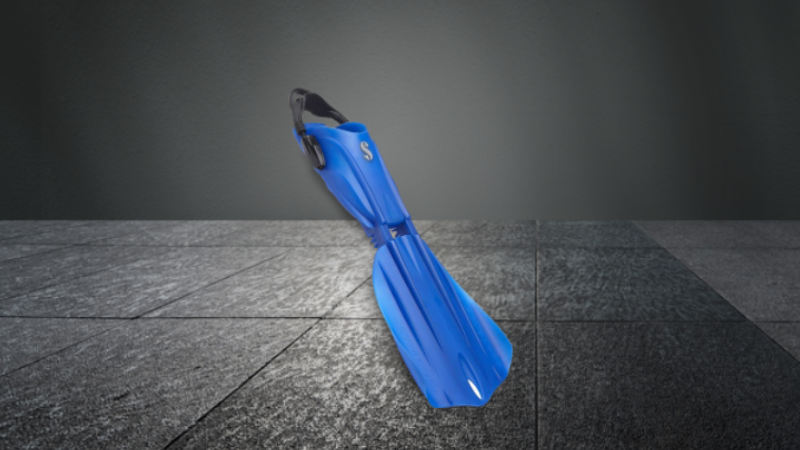
The ScubaPro Seawing Nova fins are the best overall fins on the market. They have a pivoting joint that allows the blade to move in multiple directions and generate thrust, which is incredibly efficient for swimming. The heel strap is made from marine quality bungee material and custom adjustment for total comfort and convenience.
The water flows freely over the working section of the blade, reducing drag and increasing thrust. The articulated joint allows your leg movements to be more efficient by giving you more power with each kick.
- Best overall
- Monprene material
- Clean water geometry
- Reduced drag with increased thrust
- Cutting Edge Technology
- Variable Blade Geometry
- Articulated Mid-Point Join
- Gives maximum thrust with less drag
- Little expensive
2. Best for beginners:
Tusa sf-22 solla open heel scuba diving fins.

They are a runner-up in the best scuba fins category. Tusa SF 22 Solla Fins are perfect for beginners & also for intermediate diver who wants some extra power and comfort. Powered by ForcElast Technology, these fins are designed to improve power transfer from your legs to the fin blade, giving you more speed and agility in the water.
The Multi-compound foot pocket increases power transfer to the fin blade, which means you’ll be able to swim farther and faster than ever before. These fins also feature a three-channel blade with a crescent tip that maximizes propulsion, so even if you’re new to scuba diving, you’ll still feel like a pro!
The Anatomic foot pocket enhances comfort without sacrificing performance, giving you an excellent fit and allowing you to focus on what matters most—exploring the ocean depths!
TUSA patented 20° Angled Blade Design (A.B.D.) makes these fins perfect for divers of all levels because they offer both comfort and performance regardless of their experience level.
- TUSA patented 20° Angled Blade Design (A.B.D.)
- ForcElast Technology
- Three-channel blade with crescent tip
- Anatomic Fin Strap
- TUSA patented EZ Strap and buckle system
- Comfortable
- Easy to use
- Nice design
- Vents fine-tune performance
3. Best for travel:
Scubapro go travel fins.
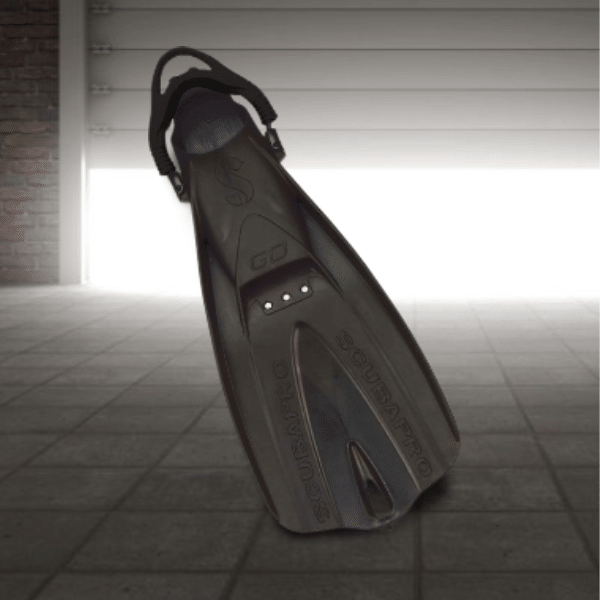
The Scubapro GO Travel Fins are an excellent choice for travelers. They are comfortable, durable, and unbreakable. They also have replaceable heel straps that are self-adjusting.
The Scubapro GO Travel fins are made from a special silicone material that is resistant to wear and tear. The fins have a stiff blade that makes them more efficient than traditional fins. The blades are also made from a special material that allows them to flex more easily when you walk in the water. The bungee heel straps make them easy to put on and take off, so they’re great for travel too!
The strap is made from unbreakable material, so it won’t wear out or break down as quickly as other materials might. The fins also feature comfortable foot pockets and a sturdy blade design that makes them suitable for heavy use in the water.
- Best travel fins
- Marine-Grade Bungee
- Replaceable self-adjusting bungee heel straps
- unbreakable strap
- heavy-duty use
- comfortable
- High Performance
- Available in only one color
4. Best budget:
Cressi free frog fins.

The Cressi Free Frog Fins are a great pick for the budget-conscious scuba diver looking for a pair of fins that will fit a variety of foot shapes.
The most notable feature of these fins is their below-blade foot pocket, which allows for increased thrust by giving you more surface area to push off of. The Free Frogs are made from a variant of low-modulus polypropylene that gives them great flexibility and softness, but also incredible durability, aesthetics, and resistance to demanding use.
The Free Frogs were designed and developed in Italy by Cressi, an Italian brand pioneer in scuba diving equipment.
- Designed in Italy
- New molding technology
- Full pocket design
- Ability to fit in different foot shapes
- IDF-Integrated Dual Frame Technology
- Durable material.
- Comes with 2-year warranty.
- Special design on the back of heel.
- Comfortable.
- Available in beautiful red color.
- Little heavy.
5. Best power:
Scubapro go sport diving fins.
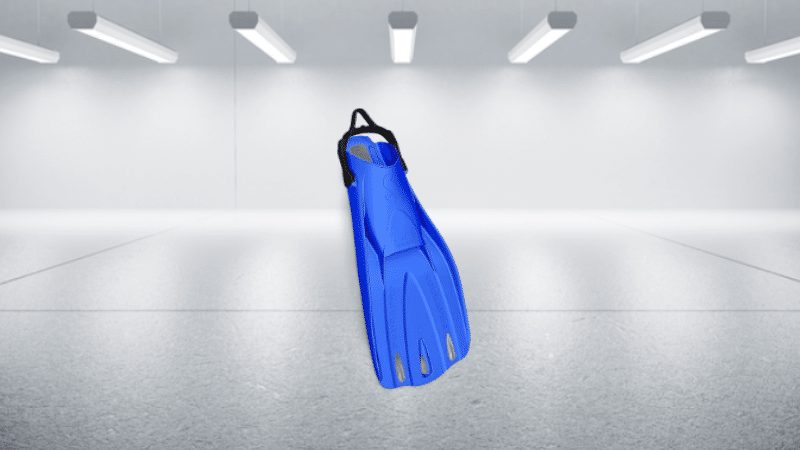
When you’re looking for a good pair of fins, you want something that’s going to be comfortable, give you plenty of power, and be easy to travel with. That’s why we love these Scubapro GO Sport Diving Fins.
This is a boot-fit design that works well for most people. They have an ultra-strong construction and are incredibly powerful, but they’re also easy to travel with. They come with a 25-degree pre-angled blade and power bars on the underside of the rail making them fast, powerful, stable, and efficient.
If you’re looking for a great pair of fins that will fit your needs no matter where your travels take you, we highly recommend this product!
- Scuba “boot-fit” design
- Ultra-strong construction
- Travel friendly
- 25-degree pre-angled blade
- Power bars on the underside of the rail make the fins fast, powerful, and stable
- Best for power
- Can walk easily walk while wearing it
- Specially designed blade
- Need to clean after use
6. Best Open heel:
Cressi frog plus.
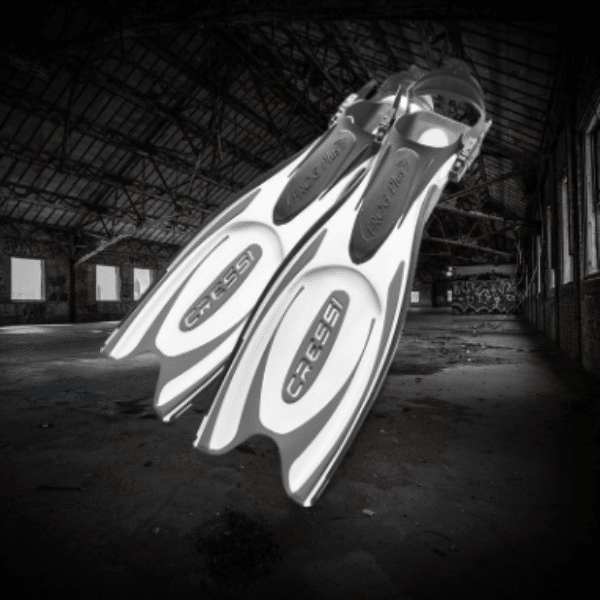
When it comes to open heel scuba fins, Cressi Frog Plus is one of the best. It has a patented 3 material injection molding process that consists in a comfortable foot pocket rubber that extends up the side rails of the blade. The dual density techno polymer, which forms the blade, combined with the third silicone based material creates a channeling effect. This revolutionary blade material is extremely durable and nearly indestructible.
The dual-density techno polymer blade is nearly indestructible and will last you for years to come. The rubber foot pocket extends up the side rails of the blade to provide greater comfort, while still providing great propulsion. Cressi Frog Plus is made in Italy and they are best known for their high-quality diving gear .
If you want to take your scuba diving to the next level, then look no further than Cressi Frog Plus!
- Best in open heels
- Dual suspension
- patented 3-material injection
- dual-density techno polymer
- Enables high level of energy
- patented foot pocket positioned below the blade
- Indestructible
- Available in various colors and sizes
- revolutionary blade material
- Only 1-month warranty
7. Best technical:
Hollis f1 fins.
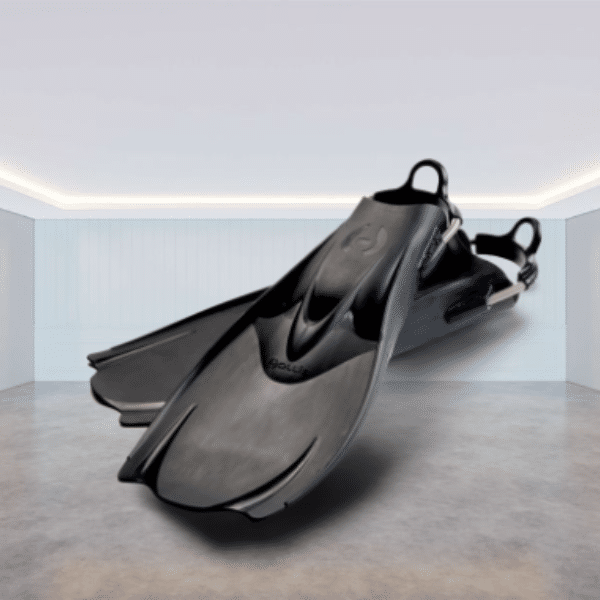
The Hollis F-1 Scuba Diving Fins are the ideal fins for technical divers. These fins are made of high-grade, heavy-duty rubber that is strong enough to withstand the most extreme conditions while remaining flexible enough to be comfortable and easy to kick. The blade is vented to reduce stress while accelerating water over the blade, which gives you more power with less effort.
The Hollis F-1 Scuba Diving Fins feature an angled strap mount for comfort and an easy-grip heel tab for quick release. The generous foot pocket will fit a wide variety of feet, ensuring comfort no matter your size or shape.
- Best for technical diving
- High-grade rubber material
- Spring heel straps with easy-grip heel tab
- Vented blade
- heavy-duty construction
- Generous foot pocket
- Fine-tuned fit
- Reduced stress while accelerating
- Only available in one color
- Bit expensive
8. Best in speed:
Atomic aquatics open heel fins.
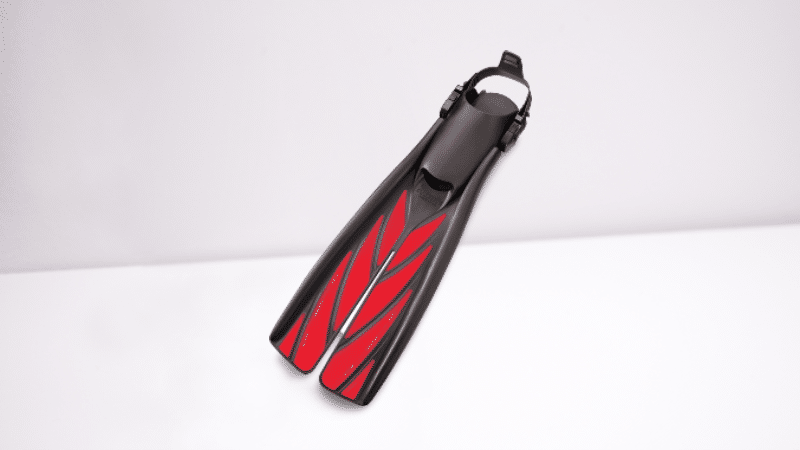
The Atomic Aquatics Open Heel Scuba Diving Split Fins are an excellent choice for scuba divers who want high-speed fins. They feature a quick, easy-release buckle system and ultra-high energy polymer fin material that makes them perfect for speed and agility.
The Atomic Aquatics SplitFin Performance is a great option for scuba diving. The split fin design provides excellent propulsion in all directions, while the quick-release buckles make putting on and taking off your fins easy. The split fin design also allows for more power when kicking underwater, making it easier to swim faster than normal fins would allow you to do so.
- Polymer fin material
- Maximum speed and power
- EZ release buckles
- SplitFin Performance
- High performance
- Best for speed
- Available in seven beautiful colors
9. Lightweight:
Cressi pro light.
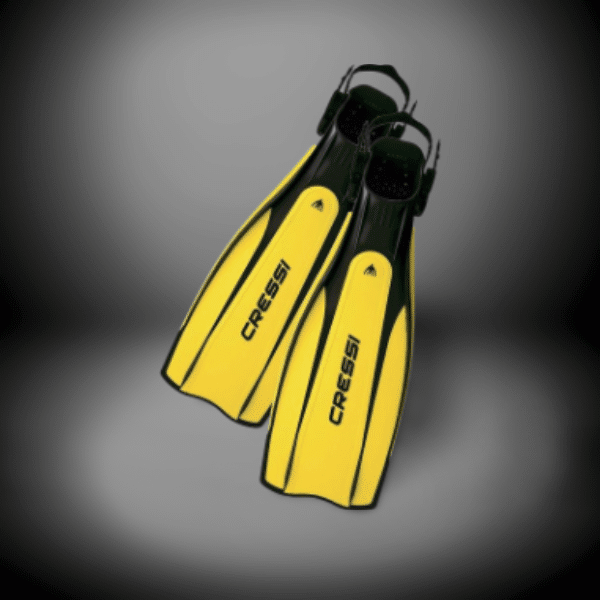
The Cressi Pro Light Scuba Diving Fins are the perfect choice for any diver who is looking to get into the water with the least amount of effort. Using a lightweight design with a full length side-rail, these fins are made to allow you to move through the water with ease. The quick-release strap buckles mean that you can easily take these fins on and off as needed.
Made in Italy out of strong polypropylene and soft elastomer material, these fins will last you a long time. Their full-length side-rails also provide extra support for long dives without causing pain or discomfort in your feet.
If you’re looking for an excellent pair of scuba diving fins that won’t be too much work on your body, then look no further than the Cressi Pro Light Scuba Diving Fins!
- Advanced design
- Strong polypropylene and soft elastomer materials are used for more lightness and well-balancing
- Full-length side-rails
- Quick-release strap buckles.
- Available in 5 different colors
- Well balanced
- Can be used for technical diving
- Less physical effort
- Not heavy duty
10. Flexible:
Mares superchannel full foot scuba fins.

The Mares Superchannel Full Foot Scuba Fins are a great choice for anyone who wants to get the most out of their scuba diving experience with flexibility. These fins offer superior performance, flexibility, and comfort.
The Mares Superchannel Full Foot Scuba Fins have a three-channel “Super-Channel” blade that provides superior propulsion in water. The flexible blades are made from Tecralene / Thermoplastic Rubber to ensure that you can move with ease through the water. The Orthopedic Foot Pocket provides extra comfort and support during your dives.
The soft and comfortable foot pocket allows you to wear these fins without feeling discomfort or pain. They are easy to put on and take off, so there will be no hassle when it comes time for you to make changes during your dive.”
- Three-Channel “Super-Channel” Blade
- Tecralene / Thermoplastic Rubber
- Orthopedic Foot Pocket
- Soft Comfortable Foot Pocket
- Little heavy
11. Best for Military:
Apeks rk3 military rubber fins.
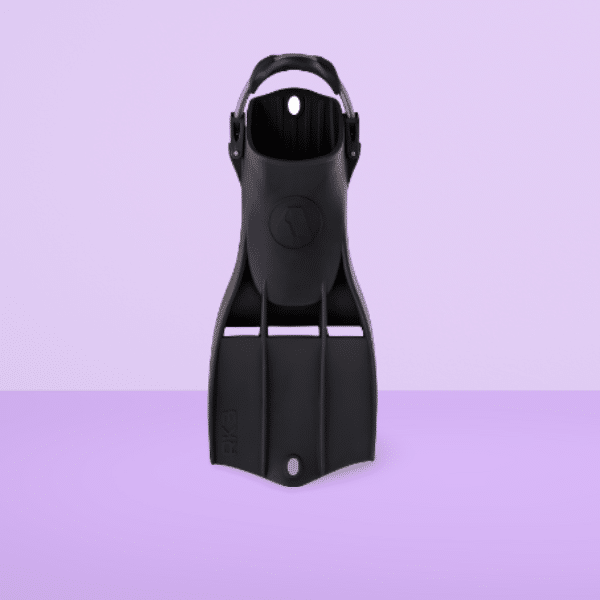
The Apeks RK3 Military Rubber Full Foot Scuba Fins are a great choice for recreational divers. These fins feature an adjustable stainless steel spring straps, rubber material, and traditional all-rubber design. All of these features help ensure that these fins provide excellent performance and comfort.
The custom designed buckle holds spring straps in optimum position to ensure maximum comfort and performance. The short wide blade provides maximum forward thrust while maintaining great maneuverability.
If you’re looking for a pair of professional quality fins that are comfortable and easy to use, then look no further than the Apeks RK3 Military Rubber Full Foot Scuba Fins!
- Best for military purposes
- The traditional full rubber design
- Custom-designed buckle holds spring straps
- Short wide blade
- Stainless steel nut and bolt
- Provides maximum forward thrust
- Soft material but strong
12. For snorkel:
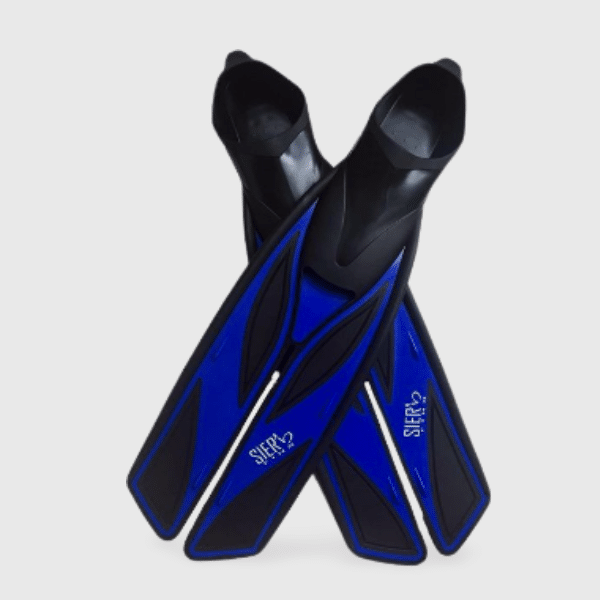
They are the best for snorkeling . These soft silicone full-foot fins are efficient thrust swim fins that will cut through the water, reducing surface resistance and making you more comfortable while you swim. Sier snorkel fins are secured tight-fitting fins that will keep you safe in the water and give you an extra kick when you’re ready to head back to shore.
These long-lasting full-pocket fins are great for anyone who wants to enjoy their time in the ocean without stress or discomfort.
- Best for snorkeling
- Soft Silicone Full-Foot
- Efficient Thrust Swim Fins
- Secured tight-fitting fins
- Cut through water
- Less surface resistance
- Longer lasting full-pocket long fins
- Can be worn with or without socks
- Can also be used for diving
- boast anti-slip bottoms
- increase efficiency
- Comes with mesh carry bag
- Only in one color
What are fins?
Fins are a type of foot-propelled underwater diving tool that can be used for propulsion and steering. They are also used for propulsion, steering, and trim.
It can be made from rubber, polyurethane or other synthetics. They come in many shapes and sizes depending on the type of fin it is (i.e., monofin). The most common style is a split fin where each blade has a foot pocket built into it so you can strap your foot in securely while wearing wet suit boots or fins socks to protect your feet from blisters caused by rubbing against the inside of your drysuit boots or neoprene socks which can cause sores on your skin if left untreated long enough – especially around the heel area where there’s less blood flow keeping bacteria away from this sensitive spot!
What are the travel fins?
Travel fins are ideal for divers who want to travel light, and they’re great for scuba students learning how to kick. They’re also a good option if you want to try diving, but don’t want to invest in an expensive pair of regular fins that may or may not be used again. Travel fins are generally made from low-grade plastic and have short blades—which means they’re easy to pack up and carry with you on trips. However, these fins aren’t as durable as other types of fins.
Buying guide for scuba diving fins
Buying scuba diving fins is a daunting task, but if you follow these steps, you will be well-equipped to make the right choice:
- Make sure they are comfortable.
- Check the size of the fin. The fin should fit snugly on your foot without being too tight or too loose; it should not be possible for more than one finger’s width between your heel and the end of the fin’s foot pocket at any point during inflation and deflation cycles (this may require taking off some booties). If necessary, ask someone who knows what they’re doing to help with this part if you are unsure about whether or not something fits correctly!
- Check for quality construction—make sure there are no seams that look like they might rip open in normal use; check for sturdy materials such as rubberized plastic instead of thin plastic sheeting or composite framing materials that may break easily when put under pressure from water pressure against them while swimming/diving/jumping off cliffs into deep waters!”
Why do you need a scuba diving fin?
A scuba diving fin helps you to propel, stabilize and balance yourself underwater.
- Propelling forward – A scuba fin can help you to move through the water by pushing your body forward. When you initiate a kick with both feet at once, this causes your fins to propel you forward and downward. If one foot is kicking while the other rests on the bottom of the ocean floor or pool deck, it will cause your body to rotate around that point before moving forward again as you switch which foot is resting on the bottom.
- Stabilizing yourself in moving current or turbulence – The combination of finning with other techniques like hand paddles allows divers to stay oriented within strong currents or rough seas without losing control of their bodies or equipment due to wind buffeting them around (called “surface current”). This makes it possible for recreational divers who aren’t familiar with breathing underwater yet to maintain their orientation in open water conditions by staying near shoreline landmarks like buoys until they’ve learned how not only survive but thrive under such circumstances
What to look for in the best scuba fins?
When you’re shopping for the best scuba fins, look for ones that are soft and comfortable. They should have a durable material with a wide range of fit options. You want your fins to be easy to clean and put on and take off. These are the most important features of any scuba diving fin:
- Durable material
- Comfortable fit for all-day wear
- Easy to clean
How do fins work?
Fins are a device used by divers to propel themselves through the water. Their purpose is similar to paddles, in that they move the diver forward. They’re located on the feet and are usually made of rubber or plastic.
Fins help you maintain a horizontal position in the water by providing thrust, but they also allow you to adjust your direction while underwater.
When you’re underwater, scuba fins are essential for propulsion. When you’re scuba diving, you’ll be using a flutter kick to propel yourself through the water—the same way that fish and other aquatic creatures move around.
A flutter kick is a combination of flapping and kicking your legs together in an alternating pattern, like this:
- kick-flap-kick-flap-kick-flap…
Types of fins
The first step to buying a fin is knowing the different types of fins that are available on the market. The types of fins are:
Full-foot fins
Full-foot fins offer a lot of support for your foot and ankle, but with this comes some loss in flexibility compared to open-heel fins. Fullfoots can help keep water out during long dives (because of their secure fit), but if you’re just starting out scuba diving then you might want something that gives you more freedom of movement when kicking underwater so as not to tire yourself out too quickly!
They consist of a foot pocket (the part you slip your feet into) and a blade attached to each side. The foot pocket may be made out of neoprene or rubber material, depending on which type you choose. The blade can either have an adjustable strap or quick-release buckle on it so that it fits securely over your booties (which we’ll explain in more detail below).
- They are the most popular type of fin, and for good reason. They have many advantages:
- Its design helps you swim faster than open-heel fins.
- They’re easy to use right out of the box, with no need for customizing or tightening.
- The rubber foot pockets make them comfortable to wear, even when you’re spending hours in them each day.
- Full-foot fins work well in shallow water, like snorkeling or swimming near coral reefs (although they may not be ideal if you want to swim far distances while wearing them).
Open heel fins
Open-heel fins are the most popular fin design, and they’re also the most flexible. A fullfoot fin has a hard plastic piece that goes over your heel, while open-heel fins do not. While this means they’re more comfortable, it also makes them more expensive because of the materials used in their construction. They might also feel like they rub against your ankle when you put them on or take them off—this is because there’s no barrier to prevent that from happening!
Neoprene booties
Neoprene booties, or dive boots as they’re often called, are an essential piece of gear for any diver. These comfortable neoprene shoes allow you to dive in cold water—often at temperatures below 70 degrees Fahrenheit (21 degrees Celsius). Neoprene is a synthetic rubber material that provides warmth and protection from sharp objects on the ocean floor. You can use your fins with neoprene booties in shallow or deep waters and even walk along sharp rocks without fear of injury. The only drawback? They’re not ideal for warm water diving because they may make your feet too hot if you wear them for extended periods underwater.
Adjustable fins
Adjustable fins are more comfortable than fixed fins, which means you’ll be able to swim faster and for longer periods. The straps on adjustable fin designs don’t pinch or rub against your heel and allow for an easy fit.
The flexibility of adjustable fins makes them more versatile than fixed fin styles, as they can be adjusted between different sizes depending on how well they fit your foot.
Adjustable fins are more durable than fixed fin styles since they can be changed out if there’s any damage or wear and tear over time.
Strap or quick-release buckle?
The strap or buckle is a matter of preference. Some divers prefer the quick-release buckle, as it provides an easy adjustment to their fins. As for the straps, they are more durable than buckles and can be used for all types of fins. However, straps are difficult to use when you are in the water.
On the other hand, with buckles, it will be easier for you to adjust your fin size when diving because all you have to do is pull one tab on each fin blade and then slide them into place. If there is any problem with this type of system then all you need is a few seconds before being able to fix it yourself
What to look for in the best scuba diving fins?
Best color for scuba fins.
The answer is simple: black. Black fins are the best fin color for scuba diving, travel fins, budget fins, and dive fins.
If you want your scuba equipment to look good then make sure you buy black ones. It doesn’t matter if they’re cheap or expensive – just get them in black!
Motivate yourself
The first step to improving your motivation is to give yourself a break. Don’t expect yourself to wake up one day and be an expert diver, nor should you expect yourself to know everything right away. Instead, try to learn about scuba diving fins one step at a time.
There are many different types of fins on the market today—and even if you’re just starting in the sport, it can still be overwhelming trying to figure out which ones are best for your needs without having any experience with them yet!
That’s why we’ve put together this guide full of information about what kinds there are available today: their pros/cons and how they compare overall against each other (so that way when shopping around for some new ones).
Final Words
When it comes to choosing scuba diving fins, comfort is the most important factor. A pair of fins that fits poorly and causes blisters will not only ruin your day but also prevent you from enjoying your underwater experience. Even if they are well made, if they don’t fit properly, they will be uncomfortable to wear.
When looking for the best scuba diving footwear, look for fins that are well-designed and well-made. Their materials should hold up over time and their construction should allow them to last through many dives before needing replacement. However, after reviewing all the fins our top pick is ScubaPro Seawing Nova Dive Fins because it has all the features which are required by every diver whether new or experienced.
We hope that this guide has helped you make an informed decision about which scuba diving fins are right for you. Keep in mind that no matter what style or brand of fin you choose, they all have certain features in common. The best ones will be comfortable and durable enough for long-term use, with a reasonable price tag on top of all their other great qualities!
Yes, you can use scuba fins for snorkeling. The only thing you need to do is to find a pair of fins that are made for snorkeling.
A standard pair of scuba fins will be anywhere from 80-110mm in length when fully extended
The length of a fin is usually measured in millimeters.
Technically, it is possible to scuba dive without fins, but it is generally not recommended. Without fins, the diver would need to rely on their hands and arms to propel themselves, which can be tiring and may not provide enough power or control to effectively navigate the dive
It is generally recommended to rinse your scuba fins after each dive to remove any dirt, sand, or salt that may have accumulated on them. Rinsing your fins can help to prevent corrosion and extend the lifespan of the fins.
Scuba fins are built to last. While it’s impossible to predict the exact lifespan of all scuba fins, you can expect your fins to last at least a few years or possibly much longer.
The best fins for scuba diving will depend on several factors, including the type of diving you will be doing, your personal preferences, and your budget.
Yes, scuba diving fins float. They are designed to be buoyant, so they can be used underwater.
Leave a Comment Cancel Reply
Your email address will not be published. Required fields are marked *
Save my name, email, and website in this browser for the next time I comment.

The Best Scuba Fins: From Cold Water to the Tropics

Alex Gillard
Since 2015 I have been a freelance writer and wildlife photographer, working out of some of the planet’s most spectacular wildlife and nature travel destinations–from the Amazon to Raja Ampat–diving, snorkelling, fieldherping, birding and photographing my way around the world.
- This article contains affiliate links and we will be compensated if you purchase something after clicking on them.
- Check out our review guidelines .
I’ve been diving and snorkeling since I was 12 years old.
From Hawaii to Indonesia, the Red Sea to the Pacific coast of Canada, I’ve owned many pairs of fins, so when I say best scuba fins , I mean fins intended for diving and not snorkel fins.
Want a list of 150 of the most unique nature and wildlife travel experiences?

Anyone who dives, free dives and snorkels will know that the distinction between the three can be a meaningful one.
If you are a serious snorkeler and want much higher-performance fins for snorkelling, check out my Best Snorkel Fins for Serious Snorkelers review.
If you would like to start reading comprehensive breakdowns for each pair, click here .
When you dive, and especially if you’re doing a drift dive or diving in strong currents, you need scuba fins that will be able to power you and your dive equipment effectively.
The small, stubby snorkel fins you get on day trips or at all-inclusive resorts aren’t going to cut it.

Deciding on the best scuba fins for you depends on a few factors, which this article will go into in detail, but they are undoubtedly one of the most important investments a diver makes .
If you’re serious about diving and you do a lot of it, good diving flippers are worth every penny.
- They are an important part of safety in the water.
- They help you maintain buoyancy.
- They help you conserve energy.
- You need the right fins for the right conditions (current, water temperature, fitness)
The Winner of Best Scuba Fins: TUSA SF-0104 Hyflex Switch

I think the best scuba fins currently on the market, that combine all of the best dive fin technology, and look the sleekest are TUSA’s SF-0104 Hyflex Switch fins .
They generate a lot of power with minimal effort, the blade is interchangeable with other TUSA blades, and it can be disassembled for easier packing.

You can really tell TUSA has some super thoughtful industrial and mechanical engineers working on their products, because everything from the heavy-duty elastic adjustable fin straps to the blade angle to the resistance-reducing vortex generator screams attention to detail.
Whether you’re looking for good recreational shore diving, serious snorkeling or recreational freediving fins, these are great additions to your scuba gear.
Main Evaluation Criteria to Choose the Best Scuba Fins
Throughout the following article, I will refer to certain common design terms that are used to describe dive fins.
I thought I would outline them at the outset of the article so that it’s easier to browse and so that you have a better understanding of what’s out there and what you need.
The best scuba fins will be those which combine these criteria in ways that make the most sense for the type of diving you plan on doing .
Some types of dives and diving are better suited for open heeled fins, while if you plan on traveling with your fins or would like to use them for snorkeling as well, full-foot fins can be more practical travel fins.
Cold water and warm water dives also usually require a distinct kind of fin, for reasons that I will go into.
Open Heeled Fins Vs. Full Foot Fins
Open heel fin refer to those scuba fins which are not closed at the back. They look more like a slipper , have fin straps (a bungee heel straps that tighten the foot) and are designed to be worn with a sock or dive boots.
They tend to be preferred for shore dives since they allow you to walk out wearing protective footwear.

Full foot fins (or closed heel fins), on the other hand, look more like the opening of a shoe . You slip your entire bare feet into the foot pockets. These tend to be preferred for dive travel because they are usually less bulky than open heeled fins.

Blade Design
Different scuba fins feature different blade designs for different purposes. They generally fall into the below 5 categories:
- Paddle fins : A flat surface fin with side reinforcement to make sure water stays on the fin. These are in contrast to a split fin, which separate the fin down the middle.
- Jet/Channel dive fins : These fins have channels engineered into the blade that literally “channels” the water like a jet. They vary in terms of weight and length, but they are usually the preferred fin of more experienced divers and technical divers.
- Force scuba fins : These fins are meant to replicate the look and effectiveness of a whale’s tail. They’re quite expensive but very efficient and powerful.
- Split fins: These fins are some of the diving fins for speed. Inspired by the design of a lot of fish tails, a split fin has a split up the middle in order to limit drag. You tend to get superior speed with less effort from these, compared to single-blade fins.
- Hinged Fins: These are usually open heeled fins and feature a pivot arm where the blade meets the foot pockets, which lets you adjust the angle of the fin based on what you’re doing.
- Detachable fins : Some fins (almost always open-heel designs) are detachable. What this means is that you can remove the blade from the foot pockets, which makes them easy to travel with and also easy to combine with other foot blade types if you want turning paddle fins into split fins and vice versa.
Finding a Fin
With those design features in mind, it’s time to evaluate some of the best diving fins on the market. They are:
- Best Scuba Fins Winner: TUSA SF-0104 Hyflex Switch (see above)
Best Open-Heel Dive Fins: Mares Avanti Quattro Plus Open Heel Bungee Strap Fin
- Best Hybrid Scuba Fins: Mares Superchannel Full Foot Scuba Fins
- Best Full-Foot Dive Fins: Scubapro Seawing Nova Full Foot Fin
Best Split Fins: Atomic Aquatics Open Heel Scuba Diving Split Fins
Best travel fins: tusa sf-0104 hyflex switch scuba diving fins, best cold water fins: ist rubber rocket scuba diver fins.
- Best Budget Fins: SEAC F100 Pro Diving Fins

- Weight: 0.9kg
- Length: 25 inches
- Materials: thermal plastic rubber/Tecralene
This recently redesigned, world-famous fin, when it comes to open-heel, The Mares Avanti Quattro are the best diving fins because they combine a lot of other great attributes into the fin as well.
I think one of the most pleasing things about the Mares Avanti is that, despite being very robust and open-heel, they only weigh 0.9kg , so you can easily travel with them without worrying that you’re eating up too much of your checked bag allotment.

Great for a variety of conditions and dive types–drift, open-water, shore, and coldwater–if you’re looking for open-heel, these are the best diving fins out there for the money.
You will appreciate the large thumb loop on the adjustable bungee heel strap for taking these bad boys on and off , especially if you’ve been on a long dive and the water has been a little colder than usual .
With a variety of colours to choose from, sizing for even the smallest feet, and great speed and control in the water, the Mares Avanti Quattro are fins that will get you from A-B quickly.
They work well in any dive types or conditions and are well-priced for what you get: professional quality, robust fins that any dive school or live aboard would be happy to provide to its guests .
One reviewer mentioned that these scuba fins made surface flutter kick difficult because they rest too near the top of the water while swimming prone.
It was the only negative review of its kind, but if you are planning on using these fins for snorkeling as well and are worried that cruising the reef from above could be a bit of a chore (although I tend to use a combination of fin kick styles at the surface depending on the current and coral depth), you might want to consider another pair on this list.
All in all these are a powerful pare of open-heel fins from a reputable dive sport brand.
Best Hybrid Fins: Mares Superchannel Full Foot Scuba Fins

- Weight: 1kg
- Length: 15 inches
- Materials: Tecralene/Thermoplastic Rubber
When we mean when we say best “hybrid” fins is those that are well-suited for both diving and snorkeling.
I like to do both, and sometimes I even prefer snorkeling to diving, so it’s nice to be able to travel with a fin that you can comfortably enjoy both with.
Also from Scuba superstar Mares, the Superchanel Full-Foot Fins are a great option for tropical diving if you don’t want to invest in heavy-duty open-heel fins but still want something that will allow you to generate enough power to enjoy a wide range of dives , these are great.
Affordable, durable and, thanks to the large central super channel and dual lateral channels, powerful enough to make seasoned divers feel comfortable and confident in the water.
These fins are also highly flexible and easy to pack, and the orthopedic flexible foot pocket makes them soft on feet (provided you get the right size).

While divers will attest to these being the best fins for hybrid use, they aren’t going to give you the same kind of power you get from open-heel fins.
Additionally, these aren’t for cold water dives. If you’re diving deep, especially in temperate seas, something you can wear a bootie with is going to be much more comfortable.
Still great hybrid fins for someone who wants or needs the best of both worlds.
Best Full Foot Fins: Scubapro Seawing Nova Full Foot Fin

- Weight: 2.8 lbs
- Length: 30 inches
- Materials: Silicone
The best fins at any given time are those that serve your purpose. Full-foot dive fins are usually lighter, easier to pack and don’t require neoprene socks (aka booties) and the Scubapro Seawing Nova Full Foot Fin are no exception.
These are the best fins if you’re looking for something with a foot pocket because they also incorporate hinged fins technology that helps maximize the amount of thrust you generate. The articulated joint lets the entire blade pivot and the wing-shaped blade gives you a great mix of flex and stiffness.
Two other very nice stability touches on this dive fin are the wing tips on the front of the blade and the power rails situated under the extended footplate. Both ensure there is minimal wobble on each kick so that you are transferring power forward , not losing it in a side-to-side motion.
Everything from this fin’s thoughtful heel pad (to improve grip on boat decks) to the “pivot control tech” that keeps the blade at an optimized 45-degree angle for each and every kick is designed with comfort and efficiency in mind.

You get a lot of power out of these very well-made scuba diving flippers, but they are not the best fins for people with weak legs . In order to maximize your thrust, you need decent quad and hamstring strength.
That’s not to say you won’t get used to them, but if you’re looking for a pair of fins after a long hiatus from the sport, especially if you’re coming off an injury, it’s something to consider.

- Weight: 3lbs
- Length: 23.5-25.5 inches (depending on size)
- Materials: Rubber and plastic
Split fins are undoubtedly one of the best fins for efficiency because they are designed to give you a lot of propulsion with less effort. The idea with the split is to minimize drag in the water while creating both lift and propulsion–functioning similar to a boat’s propeller.

These scuba diving flippers are a very nice balance between weight, length and power, and Atomic Aquatics trademarked “propeller fin” tech is designed to be used with small range of rapid flutter kicks.
Small flutter kicks are great for maintaining your legs within your body’s slipstream in the water , which also helps to reduce drag.
These are definitely some of the best split fins for older (and younger) scuba divers because they require less effort to push you forward. Traditional paddle fins will generate more thrust, but obviously with more effort required.
Flexible hinge points, a high surface ratio blade for great control, power side rails that effectively transfer power and provide stability , and an internal sole plate all combine to make this one of the best split fins out there.
These are definitely not cheap dive fins. You get what you pay for, and Atomic Aquatics is certainly one of the most respected names in professional diving, but these fins are an investment.
The foot pocket is also quite rigid, so booties are a must if you don’t want to rub your feet raw. They are open heel fins, so dive socks are recommended (if not necessary) in the first place, but these do not feel good on bare feet.
If you’re willing to invest in dive socks, these are awesome split fins.

- Weight: 4lbs
- Length: 22 inches
- Materials: Polyurethane
If you’re wondering why the TUSA Hyflex have made it onto this list twice–both as the best scuba flippers overall and as the best scuba diving fins for travel–it’s because of two things.
The first is that to reiterate, the industrial engineering, propulsion physics and fluid dynamics expertise that have gone into these dive fins is self-evident .
They look and feel amazing, and everything in and on them–from the angled blade design to the highly responsive proprietary blade system, to the ultra-comfortable foot pocket–is engineered for maximum efficiency.
The second is that these are, without a doubt, the best scuba fins to travel with on this list. The fact that you can remove the blade and travel with the foot pocket and blade separately is a game changer.
Anyone who has traveled extensively with scuba diving flippers knows that they become a focal point of your packing and arranging and you are kind of forced to pack around them.
From the comments, it appears that some people have a hard time finding the right size . Some allege these dive fins fit too large, others too small.
When buying scuba fins online, confidence in the sizing chart and recommendations is certainly something to factor into whether or not you want to buy.

- Weight:
- Length:
- Materials:
There are a few things that set cold water dive fins apart from their warm water counterparts.
Typically, cold water fins are open-heel in order to accommodate a neoprene dive sock because cold water diving is uncomfortable with bare feet.
Second, cold water scuba diving flippers generally have bigger and thicker blades to provide more power to scuba divers wearing bigger wetsuits (or drysuits), more weight and other pieces of exposure protection. They’re stiffer fins.
Third, cold water dive fins are usually made to be negatively buoyant because drysuit diving tends to make a diver’s feet float. Negative buoyancy means better trim and control in cold water conditions.
The IST Rubber Rockets are the best scuba fins for cold water environments because they combine all three of the above criteria into a fin that is trusted by people whose life depends on their dive gear– deep sea divers, open sea rescuers, coldwater spearfisherman, and military special forces .
These vented fins are made to stand up to harsh environmental conditions, are engineered with vented and curved high-power blades to jet-propel water, and are long enough to ensure efficient movement while short enough to provide excellent manoeuvrability in tight spaces.
If you are planning on doing any open sea or deep sea diving or diving in northern latitudes (in fresh or salt water), you are going to want something like the IST Rubber Rockets on your feet.
These fins are heavy . Over 7 pounds, as a matter of fact, which is certainly something to consider if you are a traveling diver like me.
I would definitely want something like this if I was doing some serious cold water diving, but as an item in my checked bag, I think I would want something lighter.
That’s not to say you can’t compromise on space and other items or even travel with a designated dive bag (depending on what you’re doing and how long you’re traveling for).
But be aware that you are getting something with some heft to it that will probably result in some preliminary leg fatigue as you get used to them.
Pretty unbeatable for cold water, though.
Best Budget Fins: SEAC F100 Pro Diving Fins

- Weight: 2.1lbs
- Length: 28 inches
- Materials: technopolymer, rubber
Try to look past the word “budget” here if you can because these dive fins, while considerably cheaper than the other options on this list, are still made by SEAC at the end of the day.
The F100 Pros are the best scuba fins for people on a budget , or looking for a cheaper pair of fins as secondaries (either to keep in the car, at home or perhaps even to travel with). These are ideal backup travel fins for tropical waters and they are also suitable for snorkeling and spearfishing.
These recreational scuba diving flippers are light, surprisingly strong and very comfortable . You get something that is priced like a piece of recreational gear, but which utilizes pro design and technology like anatomical shoes, a 25-degree curved blade, and quite a long blade, which provides a lot of thrust.

They are also great for people who have sore or injured ankles and want power without the ankle strain that you typically experience with more powerful fins.
A straightforward, paddle-blade, channelled fin that is easy on the wallet but one that most divers and snorkelers are happy to have as either their primary or their backup fin.
The blade is quite long, which is where much of the power comes from in this relatively inexpensive fin, but that means you need to be extra careful about touching coral while diving. This is even more apparent while snorkeling.
You’re also sacrificing some power . It’s a full-foot fin, and it doens’t have the same propulsion engineering–hinges, vents, winged tips, power rails, etc.–that some of the heftier, more expensive open-heel dive fins have.
They are still some of the best scuba fins out there, especially when you consider the price, the manufacturer’s reputation and the weight.
What Went Into My Selection Process for the “Best Scuba Fins” List
- First and foremost my own diving, free diving and snorkeling experience around the world in a variety of conditions using a wide range of fins.
- What do my dive friends, old and young, have to say about their favourite fins and what they like about them?
- A lot of reviews and video evidence attesting to the pros and cons of each of the dive fins I shortlisted and eventually settled on.
- Extensive reading of the negative reviews so that I could give you a balanced take on a fin. There is no such thing as the perfect dive fin and, as trite as it is to say, everyone is different and values different qualities and features differently.
My Main Criteria When Choosing Fins For Myself
As I’ve mentioned a few times throughout this review, the best scuba fins are those that are right for a given dive scenario. These are the criteria I use, however, when looking for fins for myself, and I tend to apply them regardless of where or how I’m diving:
Durability and material
I’m hard on gear (especially because I travel so much) and I have sensitive skin, so I need scuba diving flippers that are made from quality material that won’t destroy my feet.
Not too hard not too soft
I want to be able to fight currents and do drift dives, which means I don’t want something that flexes too much, but I also don’t want something that is going to exhaust my legs.
Medium-length blade
Longer blades, as a general rule, are more powerful, but because I travel so often and because I also like to use my fins for snorkeling, I tend to opt for something medium length (25 inches or so).
Full foot blade type
I like full foot fins because they’re better travel fins, most of my diving and snorkeling (though not all) is in warm water, and you don’t dive booties to use them comfortably. An open heel blade type is more appropriate for shore diving and tend to be the style you find on more powerful fins, however.
I’m pretty frugal when it comes to almost everything in my life, but scuba fins is one of the exceptions. A good pair of dive fins shouldn’t cost you more than 250 bucks, but anything under 50 is likely not going to be something that stands the test of time (certainly not based on how rough I am on things).
Reasons To Bring Your Own Gear When Traveling
If you’re a recreational diver who travels a lot to dive, you are probably going to want to invest in your own scuba diving flippers are some point. Different dive schools and boats have different philosophies on fins, depending on where you go.
What’s more, some shops cheap out on fins or don’t have a wide enough range of sizes to cover a variety of foot shapes.
There is nothing worse than being stuck with scuba fins that aren’t right for your feet, body, the amount of weight required for a dive, dive type, water temperature and dive length.
You can work around this by traveling with your own fins and diving equipment wherever you go.
Looking After Your Dive Fins
There are basically four best practices when it comes to looking after your dive fins:
- Keep them out of the sun: Ultraviolet light deteriorates fin material and shortens the life of your equipment.
- Clean your fins: You should thoroughly cleanse your fins with fresh water every time you come out of the ocean. This is doubly important if you’ve been in a swimming pool, as chlorine is very bad for fins.
- Store fins flat: Good quality scuba fins are robust, but if you store them bent or on their sides for long enough, you can end up with a permanent crease in the blade and make them more susceptible to tears and cracks.
- Keep your foot pocket inserts: When you buy new fins, they come with plastic inserts. A lot of people just toss these, but you should hold on to them and place them inside your fins after each dive. This helps maintain the structural integrity of the foot pocket.
Snorkeling vs Scuba Fins: Why the Distinction?
I love both snorkeling and diving. A lot of pure divers wonder why I even bother with snorkeling when you can spend 45 minutes at 60 feet and experience full immersion in the underwater world, but I’m also a big fan of patrolling from above.
When snorkeling, I love the feeling of being able to descend and ascend freely while being unencumbered by tanks, BCDs, regulators and the like.
What you get with typical “snorkeling fins”
If you search for “snorkeling fins” online, however, you are very likely going to be shown, at least to a large degree, the tiny little stubby short fins that you might find at a big box retailer or be shown at the top of the list on big online retailers.
These are also the kinds of fins that you are likely to be given or are available to you if you go on a leisurely snorkeling day trip in any mass tourism destination. They are also what a lot of resorts and hotels will have for guests.
These, in short, are not scuba diving flippers. They are not even, in my opinion, great fins for snorkeling because the blade is too small to propel you efficiently through the water.
My snorkeling fins tend to be ones that can also be used for diving, just with a closed heel.
These stubby fins require a lot of kicking, which generates far too much whitewash (which can scare marine life and stir up the water), and it makes ascending and descending way more difficult.
Dive fins are made for efficiency both under the water and on top of it. Longer blades, better flex dynamics, better draft reduction and power transfer, and better materials, but more expensive.
Why Investing in Good Quality Scuba Fins Makes Sense
If you are a serious diver, you should want to get the most out of each and every underwater experience. The world’s reefs and marine ecosystems are in serious trouble, with many very dire projections.
My goal when I’m underwater is to be as immersed and in the moment as possible, which means being able to navigate the underwater world as efficiently as possible.
I want to conserve energy, I don’t want to startle or damage marine life, I want to feel confident that I can battle changing ocean currents when necessary and I want to be able to pack my fins when I travel.
I’m willing to spend money on good quality dive gear because I know it will last and, more importantly, I know the experience is invaluable.
In short, it makes sense to buy the best scuba fins available (that you can afford) because the alternative is a less optimized experience.
Related Reviews
- The Best Snorkel Fins for Serious Snorkelers
- The Best Dive Flashlight 2022: The ORCATORCH D710
- Best Snorkel Gear For Serious Snorkelers: 10 Things Every Snorkeler Should Travel With
- The Best Waterproof Power Bank
- The Best Dive Computer
- The Best Snorkel Mask For Serious Snorkelers
- The Best Underwater Camera For Snorkeling
- The Best 3mm Wetsuit
- The Best BCD List For Every Dive Type
- Skip to primary navigation
- Skip to secondary navigation
- Skip to main content
- Skip to primary sidebar

Latest Diving Tips & Product Reviews
- Dive Computer
- Scuba Diving
- North Carolina
- Affiliate Disclosure
- Privacy Policy
Home » Scuba Diving » 12 Best Scuba Fins in 2023
"I may earn a commission from qualifying purchases made through my affiliate links on Diveaeris.com. Read Full Disclosure. "
12 Best Scuba Fins in 2023
Last Updated December 30, 2022 By Scott Maldonado
The best scuba fins are imperative dive equipment that all divers should have in their gear kits. They play a critical role in providing you power for your kicks as well as helping to control buoyancy better.
For these reasons, the desire to own a pair of fins is second only to purchase comfortable scuba masks . A perfect model varies among distinct divers because it relies much on their personal preferences, diving environments, and the frequency to dive.
Hence, you may find choosing the most suitable item is not a walk in the park, especially when there are thousands of options on the market today. However, do not worry, as I have selected and reviewed this article’s top 12 best scuba fins.
Also, a buying guide and other useful tips are added for your consideration as well.
Table of Contents
My Top Picks
Comparison chart, 1. cressi frog plus, 2. atomic aquatics full foot split fin, 3. mares avanti quattro plus, 4. mares volo race full foot, 5. tusa sf-22 solla, 6. apeks rk3 military, 7. mares superchannel full foot, 8. scubapro seawing nova, 9. cressi reaction pro, 10. scubapro go travel, 11. scubapro go sport, 12. seac talent camo, 1. full foot or open heel fins, 3. heel strap type, 4. blade style, features explained, what is the difference between snorkeling fins and scuba fins, frequently asked questions (faqs), final thoughts.
If you really want to improve your performance in diving, owning a scuba fin will be a worthy investment. For a quick browse on the market, below are some of the best scuba fins you should consider.
- Best Overall: Cressi Frog Plus “Customizable buckles, 3-material molding technology, channeling effect, easy to use.”
- Best Budget: Atomic Aquatics Full Foot Split Fin “Pull tab, split blade design, inspired by fish fins, ultra-lightweight, ideal for experienced scuba divers.”
- Best for Frog Kick: Mares Avanti Quattro Plus “Updated version, four channels, Channel Thrust technology, anatomical foot pocket.”
- Best for Travel: Mares Volo Race Full Foot “Orthopedic foot pocket, optimized pivoting blade, easy to kick, reduces leg fatigue.”
- Best for Strong Currents: TUSA SF-22 Solla “ForcElast Technology, 20-degree angled blade design, maximizes propulsion and speed, brings divers premium comfort.”
- Best Tech Diving Fins: Apeks RK3 Military “Traditional all-rubber design, stainless steel spring straps, cold water compatible, provides you with forward thrust.”
- Best for Beginners: Mares Superchannel Full Foot “Three-channel blade, heel pull tab, comes with superb efficiency, effortless to put on and off.”
- Best for Small Feet: Scubapro Seawing Nova “Pivoting wing-shaped blade, an ergonomic foot pocket, an oversized finger loop, suitable for rough diving conditions.”
- Best Under $100: Cressi Reaction Pro “Rigid panels, an elastomer foot pocket, lightweight and compact for dive travel, anti-slip design.”
- Best for Wide Feet: Scubapro Go Travel “Self-adjustable heel strap, the Piggy Back Stack System, comes with numerous sizes, easy for packing.”
- Best for Speed: Scubapro Go Sport “Boot-fit design, attachment points, ideal for cold water diving, suitable for heavy-duty use.”
Buying scuba fins doesn’t come easy except by luck. Every item will present itself to be the best if you go shopping without any clue on what to look out for.
Trying to save time? You can see a glance at the basic features of the top 12 best scuba fins on my list. Below is a comparison table to facilitate your reference.
The 12 Best Scuba Fins Reviews
Although I have created a short review section for you, I recommend that you have in-depth knowledge of the top 12 best scuba fins for better accuracy in choice-making. Thus, I have provided comprehensive reviews combined with highlighting their pros and cons.
All you need to do is read the following section and find out what is your dream gear.

Having a simple design combined with the excellent functions of a traditional paddle fin, the Cressi Frog Plus is an ideal selection for both inexperienced and professional divers. The exclusive molding technology makes it easy to construct the fins by using three different materials.
Thanks to that, the Cressi Frog Plus can offer you a rugged and indestructible construction for long use. Along with the open heel design, the fins provide you with adjustable buckles as well.
Besides, the Cressi Frog’s non-vented blade also comes with flexible channels, which gives you a high level of power. Thus, your propulsion is greater, and you can move underwater more quickly.
Key Features:
- Customizable buckles
- 3-material molding technology
- Channeling effect
- The foot pocket is below the blade
- Easy to use
- Adjustable buckles give you a better fit
- Comes with robust construction
- The foot pocket is made from super soft material to bring you ultimate comfort
- Offers multiple color options to fit your style
- Provides additional power for effortless kick
- Suitable for various dive levels
- More cumbersome compared to full foot fins
- Not perfect for dive travel
Product Specifications:
Here is a Youtube video of the incredibly comfortable and lightweight Cressi Frog Plus Fins. Check it out and learn how you can get the best out of your workout with them.

Considering the competitive price tag that it offers, the Atomic Aquatics’ top-quality is truly formidable. The fins provide you with a streamlined appearance which is particularly designed to optimize speed and power.
That’s why the model allows you to achieve high performance effortlessly. In addition, the Atomic Aquatics features a closed heel design, which means that it’s much more lightweight and can be packed in a suitcase easily.
But the most remarkable advantage of these fins is their split blade. Unlike standard fins, split fins can give divers greater thrust with less water drag. What’s more, they require less effort to create a kick, thereby preventing leg strain and cramping.
Read more: Top 9 Best Budget Dive Computers Picks in 2023
- Split blade design
- Inspired by fish fins
- Offers economical price point
- Ultra-lightweight
- Perfect choice for travelers
- Gives you excellent propulsion for less effort
- Ideal for experienced scuba divers
- The foot pocket is comfortable to wear
- Comes in numerous sizes
- Not suitable for beginners
- Not many choices in terms of color
Check out the following video of the Atomic Aquatics High Performance Full Foot Split Fins and see for yourself how good-looking and efficient they are.

The Mares Avanti Quattro Plus impresses divers with its simplicity and comfort. Being renewed from its predecessor – the Avanti Quattro, this model is lighter and softer but ensures higher efficiency thanks to flexible materials.
Besides, the Mares Avanti Quattro Plus applies Channel Thrust technology for its blade, which contributes to creating immediate responsiveness and exceptional propulsion. Therefore, the fins can work well regardless of diving conditions.
Furthermore, the Avanti Quattro Plus is integrated with a bungee strap. This feature enables divers to take on or off the fins smoothly. Additionally, the belt can be adjusted automatically to fit your boot size when you dive deeper.
- Updated version
- Four channels
Bungee strap
- Channel Thrust technology
- Anatomical foot pocket
- Stabilizers included
- Maximizes your performance
- The four channels offer greater thrusting power
- Versatile to be used in different dive environments
- The design gives you high stability
- The bungee strap makes donning and doffing the fins a lot easier than before
- Limited size options make the fins less ideal for divers with large feet
Here is a video review of the Mares Avanti Quattro Plus Scuba Fins. Check it out to decide whether you bring them for your next diving workout .

The Volo Race is another fantastic model from the Mares brand. An outstanding benefit of these fins is allowing you to wear them with your barefoot, thereby often preferred by tropical-water divers.
In addition, the Mares Volo Race features an optimized pivoting blade system that facilitates fluid movement. The vented design helps control the water flow smoothly, thereby increasing the fins’ efficiency. Therefore, you do not need much effort when making a kick.
Besides, the vented blade is a good choice for diving in small spaces like wrecks and caves as well.
- Orthopedic foot pocket
- Optimized pivoting blade
- Super channel technology
- Tecralene and thermoplastic rubber construction
- Rubber covered stabilizers
- The foot pocket gives you a sense of super softness
- The vented blade reduces leg fatigue
- Designed to provide you with constant thrust
- Easy to kick
- Offers high efficiency with minimal effort
- Suitable for scuba divers and snorkelers
- No need to be worn with dive socks
- Not the most comfortable fins
- Not being the flawless option for cold water diving
- Harder to put the fins on and off compared to open heel items
Watch the video below of the fantastic Mares Volo Race Full Foot Dive Fins to get some tips on kicking properly with them.

For years, the TUSA SF-22 Solla has been well-known for its finest quality, awesome thrust, optimal speed, and great stability. At a glance, you can find out its angled blade combined with three channels, creating incredible performance despite giving minimal effort.
Besides, the fins are integrated with a quick-to-adjust buckle system and an anatomic strap. These customizable buckles offer you a perfect fit and facilitate removal under emergencies. Meanwhile, the bungee spring strap enhances foot comfort as well as reduces heel slippage.
Additionally, the TUSA SF-22 Solla also comes with a reasonable price tag. Thus, you can save a lot of money spent on buying other essential dive gear. For example, you can use the fins with an air-integrated dive computer to make your adventures into the deep ocean more fascinating.
- ForcElast Technology
- 20 Degrees Angled Blade Design
- Anatomic foot pocket
- Anatomic Fin Strap
- Three-channel blade
- Designed to maximize propulsion and speed
- The foot pocket is designed to boost power transfer
- Brings divers premium comfort
- The buckle system provides you with an excellent fit
- The anatomic strap helps to prevent heel slippage
- You can wear the fins with dive socks, thanks to their open heel design
- Robust construction
- Comes in a wide range of sizes and colors
- Not ideal for traveling
The video review below will give you detailed information on the benefits and functionality of the TUSA SF-22 Solla Open Heel Scuba Diving Fins. Let’s check it out!

The Apeks RK3 is superb for technical divers thanks to its reliability, ruggedness, and high performance. The blade is made from a thermoplastic rubber material to serve purposes of use in harsh environments.
Moreover, the short wide blade is also helpful in offering forward thrust as well as maintaining excellent maneuverability. Additionally, the Apeks RK3 features stainless steel spring straps, which help hold the fins in place. They come with adjustable buckles for your great fit as well.
Another huge advantage of the Apeks RK3 is its open-heel design combined with a spacious foot pocket. This enables you to wear the fins with drysuit boots, making it ideal for diving even in the coldest conditions without freezing your feet.
However, although the fins can keep your feet warm, you still should control your dive time through a dive computer to avoid being submerged too long. Since icy diving can cause your body to lose heat, thus resulting in health problems.
- Traditional all-rubber design
- Stainless steel spring straps
- Short wide blade
- Adjustable buckles
Coldwater compatible
- A sizable foot pocket
- Multiple color options
- Enhances your performance
- Stainless steel spring straps are marine-grade, so they are more durable than bungee belts
- Provides you with forward thrust
- Offers excellent maneuverability
- The tremendous foot pocket enables the fins to be used in cold water
- Solid construction for severe environments
- The open-heel design makes the fins a little heavy
See the amazing features and capabilities of the Apeks RK3 Military Rubber Fins and learn how to use them by watching the video below.

The Superchannel Full Foot Scuba Fins is indeed a worthy investment for entry-level divers from the brand Mares. It includes a blade whose design is the perfect combination of efficiency and power.
That’s because the Mares Superchannel’s blade offers you a three-channel system that optimizes water flow to provide excellent propulsion and eliminate leg fatigue. What’s more, its blade also uses first-rate materials, guaranteeing the fins are highly durable for a long time.
The full-foot pocket is super soft to prevent blisters when you have to wear the fins all day. Besides, an easy-to-grip pull tab allows for effortless donning and doffing even when you are in the water. Additionally, the Mares Superchannel can be operated smoothly by free divers as well.
Read more: The 15 Best Dive Computers Picks for Beginners
- A massive versatile central super channel
- Two lateral channels
- Heel pull tab
- Channel thrust technology
- Upper and lower stabilizers
- Comes with superb efficiency
- Three-channel blade helps to offer exceptional propulsion and eliminate leg fatigue
- Effortless to put on and off
- Suitable for scuba and freedivers
- Consumes less energy to create a kick
- Stabilizers give you high stability as well as reduce power loss
- Some sizes offered are too big for divers with small feet
- The split blade sometimes doesn’t appeal to novice divers
Here is a Youtube video review of the Mares Superchannel Full Foot Scuba Fins. Check it out and see if they fill the gap of what you are looking for.

The Scubapro Seawing Nova is designed to take advantage of a blade fin’s power, acceleration, and maneuverability, as well as a split item’s comfort and efficiency.
Firstly, the fins include a wing-shaped blade, which helps to bring you not only excellent stability but also magnificent propulsion. Thanks to that, you are effortless to propel yourself through the water and optimize your speed.
What’s more, this design makes it perfect for diving in small spaces without causing leg fatigue as well. In addition, the Scubapro Seawing Nova also offers divers an elastic heel strap accompanied by a handy loop for smooth adjustment.
- Pivoting wing-shaped blade
- Ergonomic foot pocket
- Extended heel plate
- Marine-grade bungee heel strap
- An oversized finger loop
- One-year warranty
- Generates greater thrust without water drag
- Ergonomic foot pocket increases power transferability
- Rugged construction
- Wing-shaped blade ensures high stability when you speed up
- The bungee spring strap allows for simple adjustment
- Suitable for rough diving conditions like coral reefs, wrecks, and caves
- Be able to anti-skid thanks to grip pads on the footplate
- The fins do not offer the most affordable price point
- Bulkier and heavier to be pack in a suitcase

The Cressi Reaction Pro is an all-rounder fin because it can be suitable for scuba diving, freediving, and snorkeling. Its construction is made from three different materials, ensuring powerful and smooth kicks regardless of diving conditions.
Also, the fins’ blade offers differentiated thickness areas to bring higher efficiency as well as exceptional rigidity. Plus, the elastomer foot pocket also gives you a sense of comfort and convenience. Besides, it is positioned beneath the blade to provide additional thrust.
See Also: Top 15 Best Dive Watches Under $100 in 2023
- Reinforced side-rails
- Rigid panels
- Extended blade
- Elastomer foot pocket
- Anti-slip materials
- 20% increased surface area
- The fins can be used by scuba divers, freedivers, and snorkelers
- A soft foot pocket gives you a secure fit
- Lightweight and compact for dive travel
- Ease of use
- The blade design enables it to control the water flow better
- Enhances propulsion without requiring much power
- Not many color options
- The long blade is not ideal for diving in small spaces
To see the Cressi Reaction Pro Snorkeling & Scuba Diving Fins in action, watch this Youtube review.

The Scubapro Go Travel Fins are specially designed to meet various use requirements of divers who usually transport by plane. Therefore, it’s obvious that the fins are one of the most lightweight models on my list.
Some people wonder whether the Scubapro Go Travel can be highly durable after many years of use. Don’t worry because the fins use natural neoprene for the material, giving them the ability to resist wear and tear.
Additionally, the travel-friendly feature of the Scubapro Go is another real bonus. Accordingly, the fins allow you to stack them together for packing in a carry-on suitcase. That’s why you will not encounter issues in weight restrictions when traveling.
- Self-adjustable heel strap
- A 25-degree angled blade
- The Piggy Back Stack System
- A central power panel
- Offers barefoot freedom
- The bungee spring strap is made from the top-quality material
- Wide angled blade design gives you greater propulsion
- The fins come in numerous sizes
- The stacking system makes it easy for packing
- The neoprene construction helps the fins be long-lasting for years
- Large feet divers can find it difficult to choose a perfect size
- Not supports wearing with dive socks
Check out this video of the Scubapro Go Travel Fins for more information on their benefits and usage.

In terms of icy water compatibility, the Scubapro Go Sport surpasses its cousin – the Scubapro Go Travel, thanks to the open-heel design. This feature enables the fins to be worn with dive booties for keeping your feet warm, which most full-foot fins cannot.
Along with the boot-fit design, the Scubapro Go Sport also comes with a customizable bungee spring strap. This helps to put the fins on and off at ease as well as bring you a secure fit no matter your feet size.
Additionally, the angle blade is worthy of much attention. Unlike other scuba fins I have reviewed above, the Scubapro Go Sport offers attachment points on its blade to maximize performance.
This means that these spots are used for mounting skegs that reduce sideslip and give excellent stability, thereby helping the fins achieve high efficiency.
- Boot-fit design
- A marine-quality bungee spring strap
- An angled blade
- Attachment points
- Being a convenient choice when traveling
- The boot-fit design is ideal for cold water diving
- Sturdy construction makes it suitable for heavy-duty use
- The angled blade provides powerful thrust with minimal effort
- The fins can be used by scuba divers and snorkelers
- Skegs attached to the blade’s mounting points are not included in the purchase
Watch the following video of the Scubapro Go Sport Diving Fins to see how they pass the performance test excellently.

Although the Seac Talent Camo features a closed-heel design, it’s still roomy enough for divers to wear with their booties. Furthermore, the fins offer an ultra-soft foot pocket made from thermoplastic rubber, which ensures bringing you premium comfort.
Also, to help you donning and doffing smoothly, the Seac Talent Camo provides divers with the heel tabs built in its non-vented blade. Notably, the fins give various sizes to fit snugly for both men and women.
The manufacturer said that the Seac Talent Camo could be used in strong currents. Nevertheless, I suggest you should use it in shallow water areas. Because of the fins’ medium blade length, you can achieve higher efficiency when freediving.
- Medium-long blade
- Camouflage Effect
- Injection Color System Technology
- The fins can be worn with neoprene booties
- Ideal for shallow diving
- Suitable to dive in strong currents
- Scuba divers highly appreciate the foot pocket’s comfort
- Easy to get on and off
- Available in multiple sizes
- Restricted color options
- Not the best choice for deep diving
Related Reviews:
- Top 7 Best Full Face Scuba Masks Reviews in 2023
- Top 12 Finest Scuba Wetsuits Reviews in 2023
- Top 5 Stunning GoPro for Scuba Diving Reviews in 2023
- Top 12 Best Scuba Diving Lights Reviews in 2023
- Top 12 Best Scuba Tanks Reivews in 2023
Choosing the Right Scuba Diving Fins
There are numerous scuba fins with various features, designs, sizes, and price tags. Therefore, it can be more stressful when you are a new diver and have little knowledge.
To help you make the best purchase, I have researched the market and compiled those critical factors you need to consider.
Full foot fins feature a foot pocket that encompasses your heel. They are particularly designed to serve tropical-water divers who will wear them with their bare feet.
If you want to use the full foot fins for icy-water destinations, you can still wear them with booties, but keep in mind to buy a slightly larger size to get comfortable. In addition, these fins fit perfectly with travel needs.
They include flatter blades, and thereby, are lighter and easier to pack in a suitcase. I make sure that if you own a pair of full foot fins combined with a travel BCD , your transportation to anywhere is a breeze.
Check out my picks of the best scuba BCDs in 2023 here .
Besides, the open heel fins’ design allows them to be worn with dive socks and can be adjusted to fit your feet snugly by using adjustable straps. That’s why these fins can work well with a wider range of foot sizes compared to closed heel ones.
Additionally, open heel fins are effortless to take on and off, facilitating movement underwater when your scuba regulator makes you more cumbersome.
Although a few designs enable scuba fins to operate in different environments, the most popular models on the market now are designed for diving for exclusive situations.
Open heel fins are the best choice for shore diving. Meanwhile, full foot fins are usually preferred by freedivers and snorkelers if they offer stiff blades. Moreover, rough diving conditions like wrecks and caves require a scuba fin with a short rigid blade.
Open heel fins provide you with two major types of straps, including ratchet and spring belts. Ratchet heel straps are standard or traditional ones that give you adjustments through clips and buckles.
They often tend to be harder to put on and off. Moreover, these straps are less robust than their counterpart – the spring belts.
The spring heel straps are much simpler to take on and off as well as offer you a more rugged construction. They also come with a handy loop for you to remove the fins underwater effortlessly.
Depending on the price point, scuba fins will contain bungee or metal spring straps. Affordable models often include the former, whereas high-end items will give you the latter.
Scuba fins have three main blade styles. They are vented, non-vented, and split blades. Vented models contain a few holes that let water pass through, which provide divers with better propulsion. This design enables for creating more efficient kicks and reducing the effort to move underwater.
Vented blades are a great option to dive in overhead environments like wrecks and caves. However, non-vented items are not limited to diving conditions, thanks to their flexible panels. This design allows for channel water smoothly for facilitating the frog and flutter kick.
Meanwhile, split blades are highly favored by seasoned scuba divers due to their superb maneuverability. These style fins look like fish ones and are created with a middle split, which helps reduce water drag.
This section will present you with common terms that all divers must know to use their scuba fins efficiently. Please do not skip it if you are an entry-level one. I believe understanding these special features will help you a lot in improving your diving skills.
Open heel fins are held in place by a bungee strap. This belt allows you to get in and out of your fins smoothly, although you are in the water. The bungee strap overwhelms the standard one because of its automatic adjustability.
Full foot fins fit like a shoe, and you can wear them with your barefoot or neoprene socks. To put your fins on and off at ease, you need a pull tab. This tab gives you something to grab firmly without tearing your fin’s foot pocket.
Flexible channels and panels
Non-vented blade fins often come with versatile channels and panels to increase thrust. This feature enables you to create a flutter kick with great ease. Furthermore, because of its bendable design, it’s easy as a piece of cake to pack your fins in a piece of luggage.
Although some full-foot fins can support diving in warm and cold water, you still need to purchase a pair of open-heel fins. That’s because you can wear the latter with your booties while the former cannot.
Besides, the open heel fins provide you with a variety of foot sizes, which means that you can use thick socks but still ensure a sense of comfort.
A pair of fins is crucial dive gear that divers of all levels should buy, whether they tend to do snorkeling or scuba diving. With so many items available on the market, you surely need to grab the fabulous features and functionality that different types of fins offer.
This helps you make the right decision and get the utmost satisfaction. Therefore, I attached the following section that compares snorkeling and scuba diving fins to clear your thoughts.
Keep reading: Snorkeling vs. Scuba Diving – Which One Is Suitable for You?
If you are seeking answers to your questions about scuba fins, this is the right place. Here are some of the most frequently asked questions for your clarity.
Are Short Fins Good for Scuba Diving?
Scuba divers need long fins to move underwater conveniently, and they are a good selection for freediving as well.
However, shorter blade items will be the most suitable to dive in small spaces like wrecks, caves, and shallow water areas. Therefore, short fins are still an excellent choice for novice divers.
Why Are Scuba Fins So Long?
Scuba fins are long since longer blades can create greater propulsion for your kick while requiring less effort. Hence, you can propel yourself through the water more rapidly.
Can You Freedive With Scuba Fins?
Scuba fins are not highly recommended for freediving. Because most of them are not long enough, they cannot provide you much thrust. You will find yourself consuming a great amount of energy but not moving very far.
How Long Should My Scuba Fins Be?
The length of scuba fins is usually between 25 to 30 inches which give you enough power for kicks to propel yourself underwater. Besides, this length range helps to reduce the water pressure when you dive deeper .
Can You Use Snorkel Fins for Scuba Diving?
Snorkeling fins may not be powerful enough for scuba diving because they are designed for diving in shallow environments. Additionally, since they lack some essential features, they cannot operate properly in strong currents and deep diving.
Scuba diving is an interesting recreational sport but also contains many safety risks. Therefore, owning a pair of scuba fins will help you feel more secure when immersed yourself in exploring the magical underwater world.
Of all the 12 models I selected, the Cressi Frog Plus is the best overall. The basic design, rugged construction, and great acceleration are their plus points.
If you are looking for a budget-friendly option, the Atomic Aquatics Split Fins should be your consideration. At this affordable price point, I believe you cannot find a second model that can provide high efficiency and magnificent thrust as the Atomic Aquatics does.
Have you bought any of these scuba fins? Feel free to share your experience in the comments section. You should also share new ideas that you obtain via this article with your friends and family on Facebook or Twitter by clicking on the buttons below.
Related Articles:
- Do You Need to Know How to Swim to Scuba Dive?
- NAUI vs. PADI: Which Training Agencies Are Better?
- How Much Does It Cost to Go Scuba Diving?
About Scott Maldonado
Hi, I am Scott Maldonado, the founder of diveaeris.com. You are welcome to this website. Diving is so much fun, and I’ve got a flair for it. With many diving sessions under my belt, I have transformed from just an experienced diver to a professional instructor. I will love to contribute to your development as a diver. Therefore, I will be engaging my years of experience by discussing anything related to diving on this website. Read more about me .
Reader Interactions
Leave a reply cancel reply.
Your email address will not be published. Required fields are marked *
Save my name, email, and website in this browser for the next time I comment.
Gear-obsessed editors choose every product we review. We may earn commission if you buy from a link. Why Trust Us?

The Best Inflatable Standup Paddleboards Combine Capability and Portability
Boards that can span 10-plus feet yet pack down to the size of a small suitcase.
Inflatable SUPs in their earlier adaptations had a reputation for being a flimsier version of a hard board (think floating air mattress), but today’s higher-end inflatable paddleboards rival the performance of hard boards. Budget-friendly inflatable SUPs offer just as much fun for a third of the price (and space) of a hard board.
So whether you’re seeking serenity on calm waters or if it’s chasing thrills on the open ocean, you can do so with a paddle in hand. Go fast and far with a touring board or do some downward dogs with your four-legged friend on a stable beginner friendly board. Read on for the features you’ll need to look for when choosing the right paddleboard for you. We’ll also answer your SUP FAQs.
Best Inflatable Standup Paddleboards
- Best Overall SUP: BOTE HD Aero
- Best Budget SUP: ROC Paddle Board
- Most Portable SUP: iROCKER All-Around Ultra
- Best Stability SUP: RETROSPEC Weekender Plus
- Best for Beginners SUP: BOTE WULF Aero
The Expert: With two decades of standup paddling experience, I’ve paddled throughout the South Pacific along coastlines in Fiji, French Polynesia, and Hawaii, as well as Australia and California. My grandparents used to paddle competitively, and my grandfather carves custom paddles professionally. Whenever I pick up a paddle in their presence, I am coached extensively. My love of the ocean inspired me to create The Salt Sirens , a website dedicated to ocean sports, and I am a guidebook author for Moon Travel Guides. My writing has appeared in outlets like The Standup Journal, Travel + Leisure , AFAR , Vice , Lonely Planet and more.
What to Look For in an Inflatable SUP
While there are some great all-around boards, inflatable SUPs have become increasingly specialized for activities like fishing , surfing, and touring. First think about how you’ll use your board—casual flat-water cruising, fishing , camping , or catching waves.
More Cool Stuff To Consider: Best Inflatable Kayaks • Best Waterproof Bluetooth Speakers • Best Flippers to Dive, Snorkel and Swim • Best Backpack Coolers
Perhaps most important for inflatable standup paddleboards is length since it has the greatest bearing on overall performance. Generally, the longer a board is, the better it glides and the greater its capacity to carry heavy loads. Touring boards and those for fishing are longer. In fact, long-distance racers will often ride boards 14 feet or bigger; SUPs for surfers (and for kids) are shorter, as shorter boards tend to be more agile. Many surfers use boards that measure just 7.5 feet. For most recreational paddlers, lengths should fall between 10 and 12 feet.
Don’t forget to double check the weight capacity. Is it just for you or will there also be camping or fishing gear, or maybe even a dog or cooler along for the ride?
Boards are often designed for different activities—tackling whitewater, fishing, practicing yoga, or leisurely touring. This is most evident in the shape of the board. Standup paddleboards meant for touring tend to be long and narrow, allowing them to paddle fast and straight. Paddleboards meant for yoga, beginner paddlers, or general use tend to be wide with a round nose, prioritizing stability.
If a standup paddleboard is too heavy for you to carry and launch, it’s likely to collect dust in a corner. Choose a paddleboard that’s manageable to carry, but note that lighter boards can often be made from less durable materials. Lighter boards will often have a single-layer PVC outer shell with a linear drop stitch inside to give the board its firmness. Heavier and more durable boards might have layered PVC, welded seams, and a more complex system to make them stiffer.
Portability
One of the best things about inflatable SUPs is their portability. If it’s just a short hike from your car to the water, weight may not be a big factor. But if you have a long haul to get to the water or if you will be traveling with your board, that may change the equation. Most inflatable SUPs come with a backpack for easy transport, and some carriers even have wheels.
Paddleboard Accessories
The standup paddleboard itself is only part of the sport. Many inflatable standup paddleboards come with accessories like a paddle, fin(s), pump, and leash. The paddle is essential, and you’ll want one that’s adjustable by length if multiple people will be using the board. Note that paddle length is determined by the paddler’s height. You'll want to be sure your fin or fin system is compatible to your board, and that you have a leash to tether you to the board.
Invest in a high-quality personal flotation device, like a life jacket or inflatable belt-pouch, for safety. The Unites States Coast Guard requires paddlers to wear one when venturing outside of surfing, swimming, and bathing areas.
Most inflatable standup paddleboards come with a hand pump to inflate the board. If you’re short on time and would rather spend your energy paddling instead of pumping, there are electric pumps (figure about $1oo-$150) that cut down the effort it takes to inflate your board.
How We Evaluated Inflatable SUPS

To find the best inflatable SUPs, I relied on my personal experience using inflatable SUPs that are featured in this roundup (as well as many that ultimately did not make the cut). I tested boards in a variety of water conditions and got feedback from other paddlers who had different paddling preferences and abilities from mine.
With the surge of new inflatable SUP brands on the market, I wanted to make sure I wasn’t missing any main contenders. Then, I combed through reviews on consumer websites and paddling forums. Resources like Paddling Magazine and Session Magazine helped me find brands I might not have considered.
The number one thing I looked for in a paddleboard was its performance followed by value for money, durability, and intended purpose. Added features like storage and carrying systems also played into consideration. I did not feature boards that seemed as cumbersome as a hard board, as that defeats the purpose of an inflatable.
BOTE HD Aero

The BOTE HD Aero is my ‘Best Overall’ for three main reasons: versatility, sturdiness, and maneuverability. It’s stable enough for beginners and agile enough to grow into, making it a worthwhile investment if you want a one SUP quiver. It’s great for a quick workout on calm water yet it can also handle longer distances. As for the details? I love the use of ample bungy storage space at the nose and tail, the non-slip deck, and paddle strap to tuck the paddle away.
The package includes a hand pump, fins, leash, travel bag, and three-piece paddle. BOTE also sells a range of compatible accessories for the board like a trolley rack, cooler, and hands-free carry system.
ROC Paddle Board

The ROC Paddle Board is ideal for paddlers who want to dip their toes into the sport without making too splashy an investment. Fun for calm conditions, this board is easy to inflate, lightweight, paddles well, and is surprisingly stable.
Though you won’t gain much speed on the ROC Paddle Board, it’s a fun cruiser. In fact, this SUP would be the ideal fit for families going on a vacation and who want a one-size-fits-most board to share around.
The board comes with a paddle, hand pump, leash, carrying bag, fin system, and small dry bag that can clip to the bungy storage areas. If you plan to store this board fully inflated, I recommend releasing a little air before stowing it away to increase its longevity, as the seams might stretch and leak over time.
iROCKER All-Around Ultra

There’s an arms race among the paddleboard companies to see which board can be the lightest and most compact. For iRocker, its take on this challenge is the All-Around Ultra model, a 10-foot board that packs down into a small backpack. The board itself weighs a touch under 20 pounds.
Despite its lightweight construction, the All-Around Ultra is stable and tracks straight. Its two-fin system makes turning a little slow.
You’ll find bungy storage at the nose and tail, and three carrying handles. The board comes with an electric pump, a five-piece paddle, fins, a leash, and a bag. The larger 10-foot model is best for petite paddlers who are 5’5" and shorter. Taller paddlers should opt for the 11’0” All-Around Ultra .
Retrospec Weekender Plus

The Retrospec Weekender has evolved over the past few years and my favorite version is the Retrospec Weekender Plus. At 36 inches wide, it has a base that’s stable enough to handle a bit of chop but still steers smoothly. Suitable for rides in various conditions plus accurate steering make this an ideal board for both beginners and experts.
The SUP comes with a kayak seat conversion that’s quick to set up when your legs start wobbling or if you simply want a change in perspective. Features like two bungy storage areas at the nose and tail, an easy installation fin system, and nonslip deck make this board an all-arounder.
The package comes with a carrying backpack, pump, paddle, leash, three fins, repair kit, and a waterproof phone case. An action camera mount at the nose is a convenient touch for shutterbugs.
For the next Retrospec Weekender iteration, I hope to see the storage bungy cables stretched across the whole deck to give it a tiny bit more stow capacity, but perhaps that’s pedantic.
BOTE WULF Aero

If you’re new to paddleboarding (or want a board that’s reliable in calm conditions), opt for a SUP that’s easy to maneuver but stable enough to give you a solid base as you find your balance.
The BOTE WULF Aero is a top pick thanks to its shape and durability. Its mid-section is 33 inches wide so it’s easy to get on, stand up, and stay on.
A magnetic water bottle holder near your feet makes it effortless to reach down and rehydrate—you won’t have to worry about tiptoeing to the bungy storage section by the nose.
The BOTE WULF Aero comes with a repair kit, carrying case, fin, adjustable paddle, and leash. The only true hindrance from this being an out-of-the-bag beginner SUP is that the pump is sold separately.
Bluefin SUP Cruise Carbon

Many intermediate and experienced paddlers will cite rigidity as their top gripe with inflatable paddleboards. It’s a challenge for an inflatable to replicate a fiberglass or epoxy board feel. The Bluefin Cruise Carbon, however, comes close. Dual inflation chambers, carbon-reinforced rails, and its shape make it sturdier and more agile than many of its inflatable counterparts. You won’t feel the signature bounce and wiggle of an inflatable SUP as it goes over chop as easily on the Bluefin Cruise Carbon. A comfortable neoprene seat easily clips into the board, converting it into a kayak.
The board also features two bungy storage areas, three carrying handles, action camera mounts and a non-slip deck pad. The package includes a travel bag, leash, dual-action pump for easy pumping, paddle, and seat.
Red Paddle Co. Sport

The Red Paddle Co Voyager’s price tag teeters on the edge of a comparable hard board, but you have portability and durability that you might not find with its hard board counterpart.
The Voyager is ideal for long days (and/or distances) out on the water. Its V-shaped hull with twin fins helps the board move fast, track straight, and handle choppy conditions. The extended nose increase stability for riders who are newbies to those paddlers who are more advanced.
On deck, you’ll find three carrying handles, D-rings, and a bungy storage area at the nose. The package comes with a wheeled carrying bag, pump, fin, and battens. The paddle must be purchased separately .
Why the Right Paddle Makes a Big Difference, Where to Take Your SUP, and Why Go for an Inflatable. Expert Chantae Reden Has the Answers!

What are the main benefits of an inflatable SUP over a hard board?
Inflatable SUPS are typically more affordable than similarly shaped hard boards built from fiberglass or epoxy. Because inflatable SUPS are packable, they’re also more portable and lightweight than hard boards.
If you’re a beginner paddler who isn’t sure if a performance hard board is worth the investment, purchasing an inflatable SUP is often a wise choice to learn the basics of paddling and whether it suits your lifestyle.
Where can I paddleboard?
Most bodies of water that are open to recreational water sports are ideal places to paddleboard. If you’re just starting out, go to your local lake or river where waters are calm.
If you live near the ocean, start in flat water lagoons or bays before moving to areas where you could encounter currents and waves. It’s also best to paddleboard while the wind is blowing onshore, so you’ll drift back to land in case of an emergency.
Because standup paddleboarding is still a growing sport, it’s wise to see where local kayakers are heading—many times, conditions that work well for calm water kayaking are suitable for paddleboarding as well.
Is it true that a good paddle is just as important as a good board?
Having a good board is more important than having a good paddle, but only slightly. Without a suitable paddle, you’re unlikely to get very far no matter what board you’re on.
A good paddle doesn’t have to necessarily be expensive or made from high-end materials like carbon fiber. As a rule, you’ll want one that’s tailored to your height (roughly 4 inches taller than you are), lightweight, and comfortable to hold.
Chantae Reden is an adventure writer and photographer who rarely strays far from the coastline. She is a freediver, surfer, kitesurfer, paddler, scuba diver, and has a mild obsession with sharks. She has ridden a motorcycle through East Timor, scuba dived with tens of bull sharks in Fiji, and swam beside humpback whales in Tonga. Her work has appeared in Travel + Leisure , Escape , AFAR , Lonely Planet, and she is a guidebook author for Moon Travel Guides. Contact Chantae on her website, ChantaeReden.com .

.css-cuqpxl:before{padding-right:0.3125rem;content:'//';display:inline;} Best Product Reviews of 2024 .css-xtujxj:before{padding-left:0.3125rem;content:'//';display:inline;}

The Best Memorial Day Lawn Mower Sales 2024

Take Up to 32% Off Editor-Favorite Grills

The Best Early Memorial Day TV Sales To Shop Now
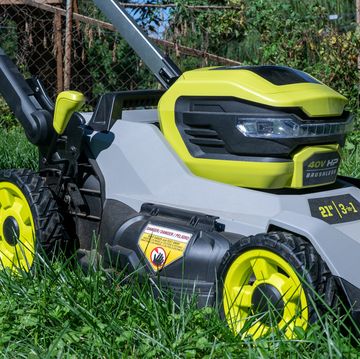
The Best Electric Mowers of 2024 for Any Yard
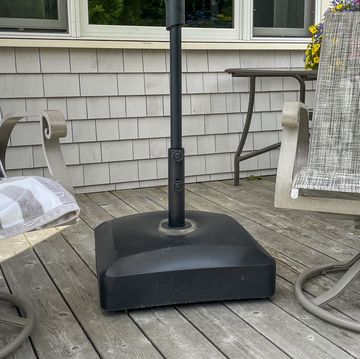
The Best Umbrella Stands of 2024
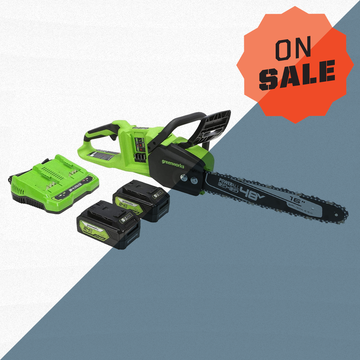
Save 45% on This Greenworks Chainsaw at Amazon
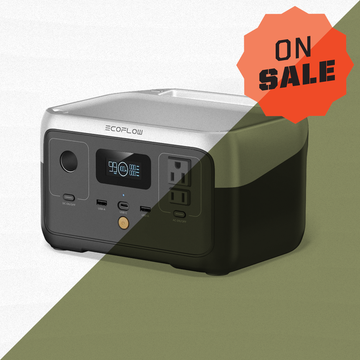
This EcoFlow Solar Generator Is 43% Off at Amazon

The Best Smokeless Fire Pits for Backyard Bonfires

The Best Doorbell Cameras for Surveillance

The Best Countertop Ice Makers of 2024

The Best Indoor Security Cameras for Peace of Mind
latest in US News

Millions on East Coast under severe thunderstorm watch as...

Jeffrey Epstein’s original 'little black book' now on sale,...

Stefanik needles 'novice' NYC rep. on Democrats' election...

Biden trips, barely avoids nasty fall while honoring fallen...

Sen. Bob Menendez's Manhattan federal bribery trial launches with...

NYC subway performers say they're under constant threat from...

Mom of OnlyFans model says she's 'proud' after NYC-Dublin portal...

Schumer-led senators call for $32B yearly spending to 'cement...
Mystery man’s body found during search for missing florida diver — who family thinks may have blacked out.
- View Author Archive
- Email the Author
- Get author RSS feed
Contact The Author
Thanks for contacting us. We've received your submission.
Thanks for contacting us. We've received your submission.
The search for a missing diver in Florida took a bizarre twist Monday when rescuers found a different body — whose identity is also a mystery.
Water rescuers made the bewildering discovery while searching off the coast of Fort Pierce for freediver Virgil Price, who had vanished while exploring a World War II-era shipwreck the day earlier.
The unknown man was pulled from the water some 30 miles from where family suspects Price succumbed to a blackout.

“This individual weighs approximately 200 to 225 lbs. and appears to be over 50 years of age. His clothing and physical characteristics do not match those of the missing diver from Sunday,” the St. Lucie County Sheriff’s Office said.
Nearly everything about the man remains a mystery: he does not match any missing person reports in the area and it is not clear what caused his death, the department said.
The body, however, “does not appear to have been in the water for an extended period of time.”

The strange discovery came just hours after the US Coast Guard suspended its search for Price, 39.
The experienced free diver was exploring the Halsey shipwreck, roughly 13 miles southeast from the shore, when “he failed to resurface,” the sheriff’s office said.
The 435-foot long ship — sunk by a German U-boat in 1942 — has become a popular diving destination. The wreck, broken in three pieces, rests 65 feet deep on the ocean floor, according to FishingStatus.

According to his sister, Price was a skilled diver with nearly a decade of experience under his belt who had demolished depths well beyond where the SS Halsey lies.
“I’m not sure if he reached his goal yet of 300 feet of depth, but I know for sure he had made it well into the 250s to -70s. So this wasn’t that deep of a dive, and it was a clear day,” Brit Drozda told The Post Tuesday night, adding that Price could hold his breath for over five minutes.
Price was likely spearfishing — one of his favorite hobbies — when he experienced a blackout, Drozda theorized. The murky waters, great for fishing, may have contributed to his fate, as well as his proximity to the strong currents of the nearby Gulf Stream.
“It’s unbelievably hard to not know where he is, but in my heart of hearts I know he’s gone,” said Drozda.
The grieving sister said she and her father had just walked out of Sunday morning Mass when they received the devastating news.
Although heartbroken by the loss, Drozda said he’s found some comfort knowing her brother died doing what he loved.
“He had such a passion for the ocean that if he were born with gills, he’d probably never would have left the ocean. He just was an incredible freediver and person. I mean, infectious,” she said.
“He was just this big teddy bear and big kid and just so playful and it’s so hard to put into words because he lived so much life in such a short period of time, and I am just so grateful that I got to spend that time with him … and I want people to know that like he cared so much about people and animals in the ocean.”
The USCG said it covered more than 1,415 miles over 36 hours in hopes of finding the missing man, but decided to halt the search “pending new info,” though they did not clarify what details led to the suspension.
“The decision to suspend an active search is never taken lightly. We extend our sincerest condolences to Mr. Price’s family,” Lt. Cmdr. John Beal said in a statement.
Price was identified as a “team member” at Florida Freedivers, a sporting goods store in North Palm Beach.
He was last seen wearing a green wetsuit with an orange stripe on the hood, yellow weights on his weight belt and black carbon fiber fins.
Share this article:

Advertisement

IMAGES
VIDEO
COMMENTS
BLADE LENGTH. When it comes to fins, size matters. Longer fin blades perform well in the open ocean and are best for SCUBA divers who prefer to use the flutter kick. Shorter, more compact fins are best for diving in enclosed environments and provide more power when combined with the frog kick.
Apeks RK3 Fins. Apeks is leading the way when it comes to high-quality and high-performance scuba equipment, and the Apeks RK3 fins are a prime example. Made from rugged thermoplastic rubber, the Apeks RK3 fins will hold up in any environment and conditions, and will last for years.
7. Best travel scuba Fins for Cold Water Diving: Apex RK3 Military Dive Fin. The Apex RK3 Military Dive Fin is specially designed for cold water diving and offers exceptional performance. These fins boast a unique military-style vented design, with shorter yet wider blades that deliver powerful kicking power.
Best "Classic" Fins: Tusa SF-22 Solla; Best Fins for Travel: ScubaPro Go Travel; Cheapest Scuba Fins: Tusa Liberator X-Ten; Best Range of Colours & Patterns: ScubaPro Go Jet; Best Split Fins: Atomic Smoke on the Water; Best Rental Fins: Mares Avanti Quattro+ Best Manta Inspired Fins: Oceanic Manta Ray; Best Fins for Extra Secure Fit: Mares ...
Best Travel Scuba Fins - Top 6 Picks. 1. Tusa Hyflex Switch. To pick the ideal scuba fins, you need to opt for a product that makes movement easy to help you explore the underwater world. Luckily, this pair comes with a polyurethane blade system and a vortex generator, guaranteeing swift movement, allowing you to utilize every second of the ...
Aqualung Storm MAX £90. Aqualung's Storm Max are long fins made from a single material Monprene construction for durability and strength, with an automatically adjusting bungee strap for ease of donning and doffing. Each size has its own colour coding to help distinguish it from other divers' fins.
4. Mares Volo Race Scuba Travel Fins. 5. Aqua Lung HotShot Scuba Travel Fins. 6. Hollis F-2 Scuba Travel Fin. Are you excited to plan a trip to scuba dive along a beautiful coral reef but concerned about the bulk of your luggage? Fear not, because we have compiled a list of the best travel scuba fins on the market.
The best scuba diving fins from the 2020 Scuba Diving magazine Gear Buyers Guide. ... Made of lightweight, durable Monprene, this compact fin is well-suited for dive travel. The compact blade provides plenty of power, yet remains small for easy packing and transport. The Storm has an open-heel foot pocket, but is designed to be worn as a full ...
Best Scuba Fins Reviewed #1 - Apeks RK3 Review (Best All-Rounder) Check Price. ... The Scubapro Go Travel fin is a fin designed for the traveller, and is also much more affordable than other pairs. Weighing in at a mere 0.6kg per fin, these are ideal for travelling. However, durability is not compromised, as they are made of 100% monoprene.
OUR TOP PICK. Product Name: TUSA SF-0104 Hyflex Switch Diving Fins. Product Description: For those looking for standard paddle fins, we highly recommend the TUSA SF-0104 Hyflex Switch Fins. It has an open heel design with a bungee strap for the best fit no matter what the underwater temperature is.
Our Top 5 Picks of the Best Scuba Fins. Best fins for strong currents: Scubapro Seawing Supernova Fins. Best for warm water dives: Mares Avanti Super-Channel Full Foot Fins. Best snorkeling & freediving fins: Cressi Rondinella Full Foot Fins. Best scuba fins for beginners: Tusa SF 22 Solla Fins.
The Short Version. Best All-Rounder: Mares Avanti Quattro Plus. Best For Beginners: Tusa FF-22 Solla. Best For Travel: Scubapro Go Travel. Best Split Fins: Atomic Aquatics. Best Budget (Closed Heel): Cressi Clio. Best Budget (Open Heel): TUSA Liberator X-Ten. Best For Efficiency: Scubapro Seawing Nova.
Short fin length makes it difficult to chase fish (spearfishing) My top pick scuba diving fins, is my personal fin, the Apeks RK3s. The RK3 regular comes in lots of vibrant colors and is a very lightweight fin. Slightly less stiff than others on this list, it is still enough for most people.
Mares Avanti Quattro Plus. $189.95. The Avanti Quattro + fins exceed the established performance of the traditional model thanks to the use of new materials that optimize efficiency. Greater responsiveness and thrusting power with an even more attractive look.
Here is our list of best scuba diving fins in 2024: Best Overall: ScubaPro Seawing Nova. Best for beginners: TUSA SF-22 Solla Open Heel Scuba Diving Fins. Best for travel: Scubapro GO Travel Fins. Best budget: Cressi Free Frog Fins. Best power: Scubapro GO Sport Diving Fins. Best Open Heel: Cressi Frog Plus. Best For Technical: Hollis F1 Dive Fins.
With those design features in mind, it's time to evaluate some of the best diving fins on the market. They are: Best Scuba Fins Winner: TUSA SF-0104 Hyflex Switch (see above) Best Open-Heel Dive Fins: Mares Avanti Quattro Plus Open Heel Bungee Strap Fin. Best Hybrid Scuba Fins: Mares Superchannel Full Foot Scuba Fins.
While most divers prefer open heeled fins, full-foot fins are a more affordable option and are a better choice for warm water dives. Travel diving - For travel, the best types of fins are lightweight, compact, and efficient. This can be a difficult combination to find, but the SCUBAPRO GO Travel Fin ticks all those boxes.
Best Under $100: Cressi Reaction Pro. "Rigid panels, an elastomer foot pocket, lightweight and compact for dive travel, anti-slip design.". Best for Wide Feet: Scubapro Go Travel. "Self-adjustable heel strap, the Piggy Back Stack System, comes with numerous sizes, easy for packing.". Best for Speed: Scubapro Go Sport.
Apeks RK3 Fins. 11. SKU: APXFRK3SU. $199.00. View Details. In Stock. DESCRIPTION. A popular military-grade scuba fin with vented blade design, spring straps, and outstanding performance. Top Rated Gear.
Best Overall SUP: BOTE HD Aero; ... fins, leash, travel bag, and three-piece paddle. ... She is a freediver, surfer, kitesurfer, paddler, scuba diver, and has a mild obsession with sharks. She has ...
A second body was found during the search, but officials have not yet identified who the man is or how he died. St. Lucie County Sheriff's Office. The strange discovery came just hours after the ...
Search 42 Elektrostal' fence companies & installers to find the best fence contractor for your project. See the top reviewed local fence companies and installers in Elektrostal', Moscow Oblast, Russia on Houzz.
Search 1,121 Elektrostal' new & custom home builders to find the best custom home builder for your project. See the top reviewed local custom home builders in Elektrostal', Moscow Oblast, Russia on Houzz.
Search 66 Elektrostal' local plumbers, companies & services to find the best plumber for your project. See the top reviewed local plumbers & plumbing services in Elektrostal', Moscow Oblast, Russia on Houzz.
Search 83 Elektrostal' stone, paver & concrete contractors to find the best masonry and concrete contractor for your project. See the top reviewed local masonry and concrete contractors in Elektrostal', Moscow Oblast, Russia on Houzz.